Flagship Journal for Evidence Engaged Practice
Issue 4

w: ags.bucks.sch.uk
Issue 4
Published by Aylesbury Grammar School 2022
Aylesbury Grammar School
Walton Road
Aylesbury
Bucks
HP21 7RP
Assistant Headteacher
Vanessa Beckley
vbeckley@ags.bucks.sch.uk
AGS Research Team @AGSResearchEd
AGS Headmaster @AGSHeadmaster
www.ags.bucks.sch.uk
Flagship: Journal for Evidence Engaged Practice
2
Engaged Practice
Flagship Journal for Evidence
Front cover artwork by AGS A Level art student.
Foreword by the Headmaster
‘These institutions have a collective purpose, a shared set of rituals, a common origin story. They nurture thick relationships, and demand full commitment. They don’t merely just educate, they transform.’ David Brooks, The Second Mountain: The Quest for a Moral Life.
In his book, David Brooks reflects on the concept of a society of hyper-individualism characterised by unfulfillment and alienation - which is in stark contrast to the relationships, community and commitment displayed on these pages. For each researcher and research project, there are connections, professional growth, impact, and the relentless desire to improve the lives of our families and community.
This isn’t the first Flagship, and this isn’t the first publication based on educational research. However, it is the first since the historic disruption to education across the globe. It marks a fully-fledged approach to collaboration, a stability and creativity to the progress of our professional practice and the education of our young people.
In an academic year that has seen the return to a richness of musical performance, to emotion and creativity across the arts, as well as a speed and strength in the sporting arenas, 2021-2022 has seen many firsts and many triumphant returns.
Our students re-entered the examination halls in May and June 2022 to sit their qualifications for the first time in three years. They did so with preparation and resilience. Whilst an evolution of Remote Learning marked an end to School closures for snow events, the impact of climate change and the arrival of Storm Eunice in February and the extreme heat of July challenged this position, delivering unique, unprecedented closures and disruptions to learning. However, we were prepared. Prepared both to continue to learn, but also to be agile and flexible in the face of change. Something developed because of the pages you are about to read.
‘Everything must change so that everything can remain the same’, says Tancredi in Giuseppe Tomasi di Lampedusa’s The Leopard (Il Gattopardo), but the ‘same’ for us is hidden by a relentless desire to improve and an undeniable focus on ensuring certainty even when all around us we see and experience uncertainty.
To all the trailblazers and pathfinders, to the editing team, and the constant desire to transform, thank you. This is certainly our Flagship.
Mark Sturgeon Headmaster AYLESBURY GRAMMAR SCHOOL

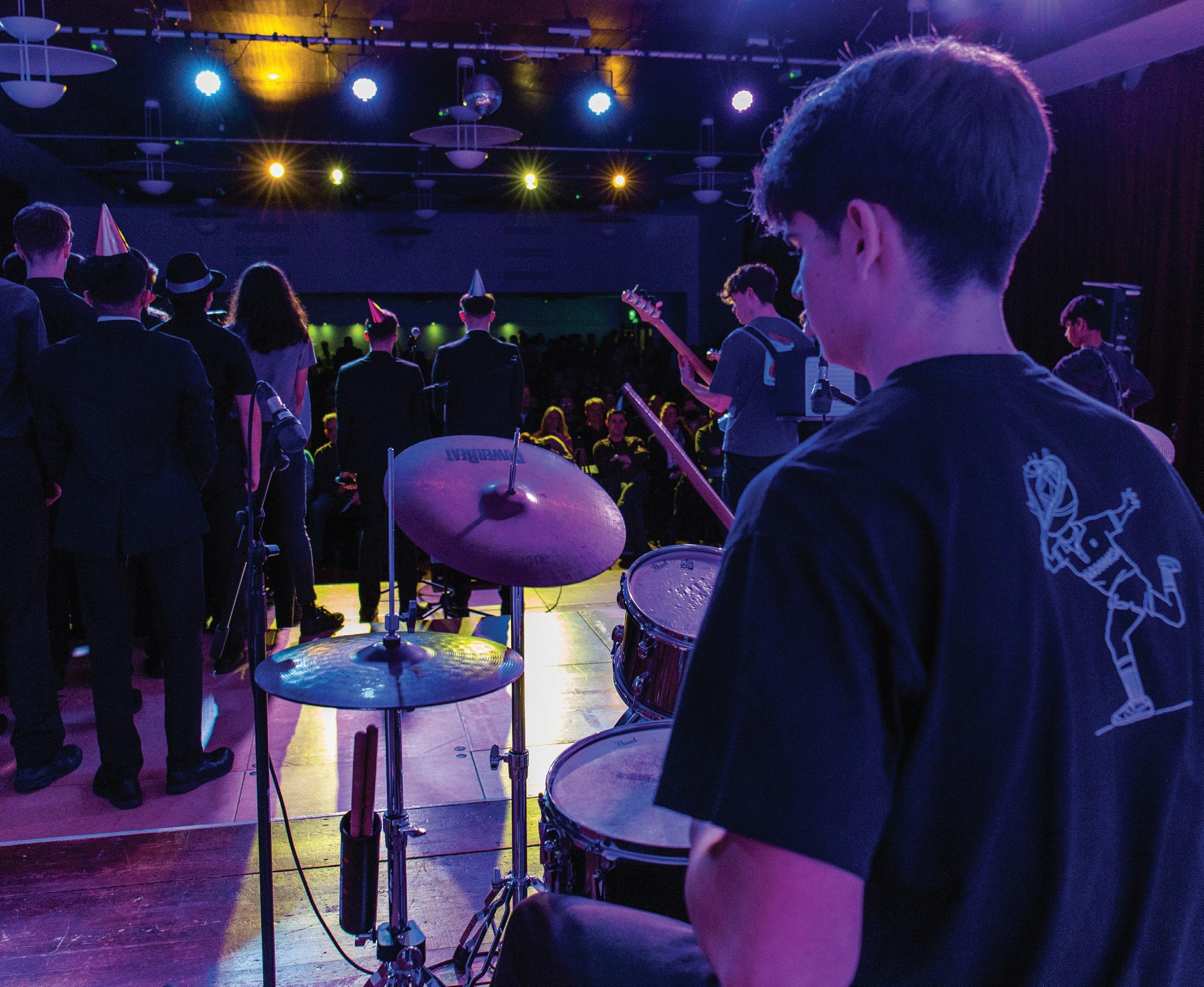
In a landscape where so much is unpredictable, it is human nature to seek facts on which it can rely. Perhaps that is why this edition of Flagship is our most extensive.
The audience – excited, apprehensive, maybe a little unnerved in what is probably their first large crowd since the restrictions – adjust masks, shuffle in their seats, back away apologetically from their neighbours. Mr Nathan, in his characteristic smart waistcoat and suit, styles his way to the front of the crowd and puts everyone at ease: smiling, benevolent, impressive. “Welcome to our first musical event since Lockdown,” he beams, the joy palpable. He turns to face his musicians and the miracle begins. The Hall, starved of sound, delight, laughter, joy for so many months, erupts into a cacophony of unleashed notes ricocheting off walls, glancing across the crowd, rebounding from the sound crew, burrowing into the names of our great Aylesburian heroes etched onto the memorial stone to the right of the audience, before flashing across the delighted and hopeful faces of our musicians. The pandemic is cruel but our School is stronger.
And what a calendar of exciting events followed. Whilst this is the fourth edition of Flagship, our Journal for Evidence Engaged Practice, in so many ways it has been a year of firsts. Like the whimsical initial notes of House Music, hesitant and delicate, we started again. Faces on screens became jostling students; WhatsApp groups dissolved into teachers collaborating over a coffee; House Art was tangible, concrete, three dimensional; hopeful Heads of Department buried thoughts of teacher assessed grades like a forgotten nightmare; students assembled bright and early in our Hall. Working groups started to meet, busily planning initiatives to support students with their literacy, their careers, their character. The PE department jammed their diary with fixtures. And Mr Crapper, Head of Modern Foreign Languages, unfolded his map of France and picked up his phone…
On Friday 27th May 2022, forty Y8 students departed for Burgundy in the first overseas curriculum trip since the start of Covid. The same month saw some four hundred dedicated students write their way to success in public exams with courage, optimism and determination. There were some unusual firsts too. Storm Eunice emptied the playgrounds, rubbish bins leashed down with rope, the School Hall defending itself as the wind buffeted its windows trying to break its resolve. The new Reception door twisted on its hinges. The Tower Block groaned at its mistreatment. Then came the Heatwave. The Met Office red warning kept students at home for the first time as roads melted. The Hall looked on wryly.
In a landscape where so much is unpredictable, it is human nature to seek facts on which it can rely. Perhaps that is why this edition of Flagship is our most extensive. We ask how we can support students to develop character to prepare them for an uncertain future; we question how we can support a more positive masculinity against the unhealthy Man Box that has been handed down by societal norms and consider the value of role models; we connect as humans across cultures examining ethnomathematics and diverse textbooks. In Flagship we do this rigorously and always from an evidence base.
Our staff are dedicated to a collective endeavour on behalf of our students. And like the gradual flourishing of music following the pandemic, the spirit of AGS swells and our great Hall beams down.
Vanessa Beckley Research Lead AYLESBURY GRAMMAR SCHOOL
w: ags.bucks.sch.uk 4 EDITOR’S NOTE
From the back of the Hall the first few hesitant squeaks of a clarinet signal the arrival of our students. A little chatter from the front. An overloud boom from a microphone. Hurried steps to the sound board to check the connections.
VANESSA BECKLEY
Vanessa Beckley has been teaching English at AGS since 2009 and alongside this is Assistant Headteacher for Professional Learning. Deeply concerned and saddened by the dramatic fall in new teachers to the profession and the challenges of retention, she sees autonomous and purposeful professional learning, a collaborative School culture and staff interaction as essential steps in the journey towards better wellbeing for all. She is therefore excited to edit this fourth journal as a celebration of the commitment of its contributors and their exceptional talent. This year’s recommended read is “Running the Room” by Tom Bennett, a book which is simultaneously colourful, hyperbolic and witty, and practical, sage and outspoken. Definitely Marmite.
RACHAEL JACKSON
Rachael Jackson has been teaching French at Aylesbury Grammar School since 2019 and is also a Digital Learning Leader for the School and newly appointed to the role of Professional Tutor.
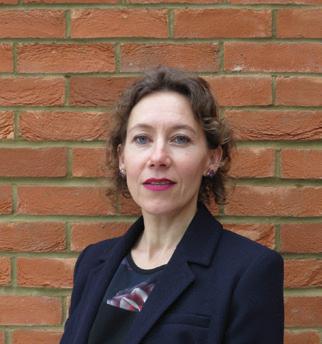

Rachael has been selected by the International Boys’ Schools Coalition (IBSC) to conduct an action research project on “Shattering Stereotypes: Helping Boys Cultivate Healthy Masculinity” and recently attended the IBSC conference on “The Path to Manhood” in Dallas, Texas with 500 educators from around the globe.
Rachael’s recommended reading on the topic of masculinities has to include the work of Raewyn Connell. She would also encourage the reading of Reiner’s (2021) book “Better boys, better men: The new masculinity that creates greater courage and emotional resiliency” which is a difficult book to read in terms of the suffering described but one which lingers in one’s thoughts and highlights the importance of this work.
HARRY DUDMISH
Harry Dudmish is a teacher of P.E., starting at Aylesbury Grammar school as an NQT in 2020, joining a very experienced department. Together with the new Director of Sport, and as part of the Character Development Working Group, alongside his research project in character, Harry looks to help develop an ever progressing PE curriculum. With an extensive background in team sports, Harry understands the range of benefits sports can offer students, but also seeks to continue exploring how far the mind can go. Much of the reading Harry does revolves around psychology and character, with recent books including “The Art Of Resilience” by Ross Edgley and “The Chimp Paradox” by Steve Peters.


JAMES TAYLOR
James Taylor has been teaching at Aylesbury Grammar School since 2019, and is a teacher of History and Classics. He has just completed his NQT+1 year, as well as supervising students for EPQ and acting as Head of House. This year, he has been conducting research on student perceptions of role models and leadership, enhancing the work he has been doing in both the Research and Character working groups. James always enjoys reading, both for historical curiosity and with an interest in educational and pastoral issues, so can recommend both “America on Fire: the Untold Story of Police Violence and Black Rebellion since the 1960s” by Elizabeth Hinton and “The Boy Question” by Mark Roberts.
5 Flagship: Journal for Evidence Engaged Practice
ALEX GRUAR
Alex Gruar is a teacher of Classics at Aylesbury Grammar School. She believes that the study of the ancient world is for everyone and has previously been involved in a project for the University of Oxford providing Latin GCSE lessons for teenagers who would not otherwise have the opportunity. For the past two years, she has been focussing on how changing to a more representative coursebook can improve student awareness of the existence of BAME people in the Roman world, and how teachers can optimise this. She recommends the Radio 4 programme “Detoxifying the Classics” as an introduction to why this should matter for all of us.
ALI MANJENGWA
Ali Manjengwa is teacher of Mathematics at AGS having joined in 2008. He has been a member of the Diversity working group and the Research working party and has delivered presentations to staff on decolonising the curriculum. A diversity champion for the Maths department, he has an interest in curriculum change and has been researching ways to decolonise the Maths curriculum at AGS to make it more inclusive and interculturally responsive. This year he has focussed his research on implementing and evaluating an ethnomathematics strategy on students’ learning and understanding of multiplication.
ANDREW SKINNER
Andrew Skinner has been Head of English at AGS since 2014. This year, as part of completing his NPQSL, he explored the effect of a wider ranging induction summer camp on how students coped with the transition from primary to secondary school. John West-Burnham’s “Moral Leadership”, centred around ethical and value driven leadership in school communities, was influential and a springboard into many interesting discussions and further reading.


AMBER FINN
Amber Finn is a physics and computer science teacher who has been teaching at AGS for six years. She is particularly interested in the use of technology in education and is part of the School’s group of Digital Learning Leaders. When the International Boys’ Schools Coalition (IBSC) announced in 2019 that their upcoming theme for action research would be Boys and Technology: New Horizons, New Challenges, New Learning, she was excited to apply to be part of the cohort of teachers from around the world taking part. After multiple delays and obstacles due to COVID the research went ahead and the findings were presented at the annual IBSC conference in July 2022. A useful place to start when looking for research informed improvements is the Education Endowment Foundation’s (EEF) Guidance reports. Amber found the EEF’s report on Using Digital Technology to Improve Learning particularly useful.
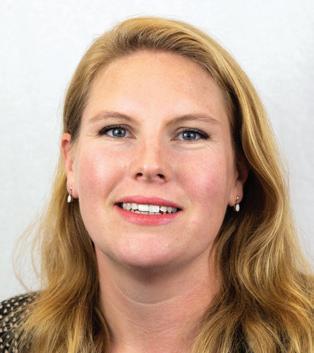

w: ags.bucks.sch.uk 6
Meet The Research Team
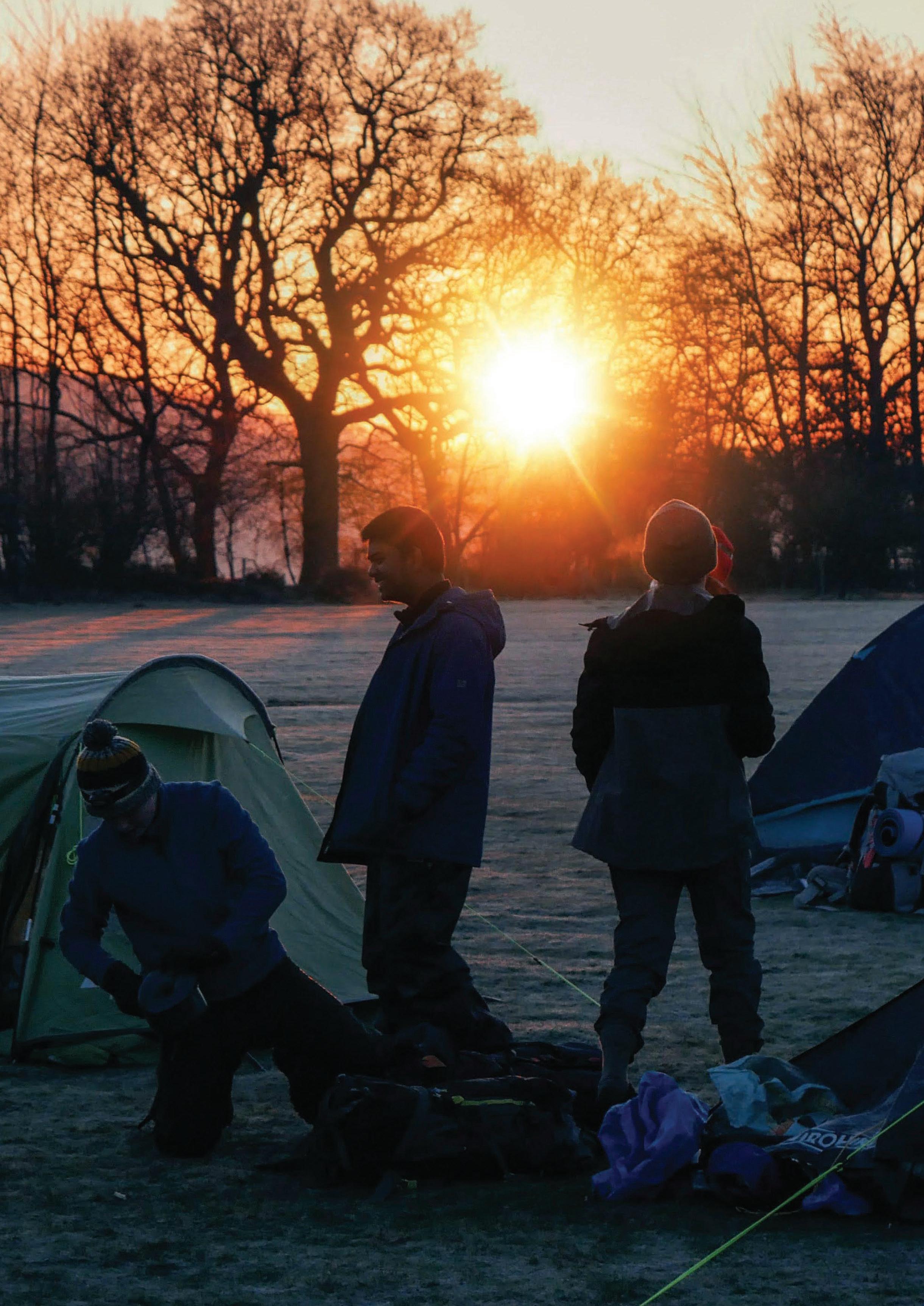
Contents
9
RACHAEL JACKSON
What does Positive Masculinity mean to Year 8 students today?
21
HARRY DUDMISH
What is the impact of either a student centred or games approach on key stage 3 students’ character development, particularly ownership, during P.E. lessons?
31
JAMES TAYLOR
To what extent can Year 9 students’ perceptions of role models be broadened and challenged within teacher and peer-led Personal Development sessions?
43 ALEX GRUAR
The impact of a change to a more diverse KS3 Latin course book in student perceptions of BAME people in the Roman world, and how to optimise this: an update.
55 ALI MANJENGWA
Assessing the effectiveness of an ethnomathematics teaching strategy on students’ understanding of mathematics.
63 ANDREW SKINNER
How might a broader and more inclusive transition process from Year 6 to Year 7 develop student confidence and attitude to learning in Autumn term for Year 7?
73 AMBER FINN
Using technology to support self-paced learning in physics and the effect on self-efficacy
What does Positive Masculinity mean to Year 8 students today?
ABSTRACT
Masculinity or masculinities is a subject that has been gathering attention dramatically since 2017. At the same time, it is often poorly defined, misunderstood and provokes strong feelings and opinions, or retreats into a silent taboo. In March 2022, I began an action research project with one class of Year 8 students to uncover their thoughts and feelings on masculinity. In this paper, you will hear their voices and you will be able to share in the privilege of listening to their innermost and most authentic thoughts. A privilege and also a great responsibility of really listening to them and hearing them. We all have a tremendous opportunity to learn and reflect and play a part in defining a world of limitless masculinities.
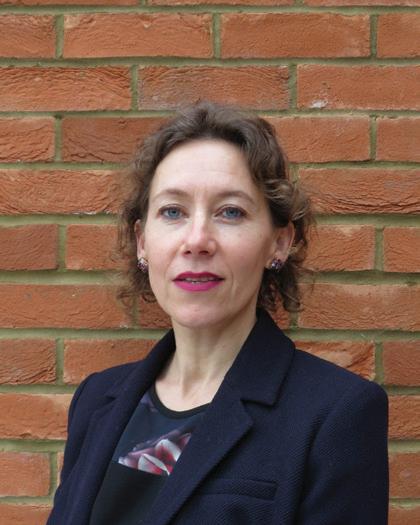
Flagship: Journal for Evidence Engaged Practice
Rachael Jackson Teacher of French, Digital Learning Leader, Professional Tutor
CONTEXT
In recent years, the term “Masculinity” has percolated conversation in schools, whether informally across playgrounds and through corridors or more formally. There are many terms used today and they are not always fully understood or helpful. You may have heard of some of these terms, such as “Positive Masculinity” and “Healthy Masculinity” or “Toxic Masculinity” and “Hypermasculinity”. The terms “Toxic Masculinity” and “Hypermasculinity” carry some unhelpful connotations as deficit models (Waling, 2019; Maricourt & Burrell, 2022) and it might be more constructive and accurate to talk in terms of “multiple masculinities” (Messerschmidt, 2018; Connell & Messerschmidt, 2005).
Listening to young people about their experiences and perspectives on “multiple masculinities” has never been so important as it is today and we have an opportunity (and arguably an obligation) to guide and support them.
The voice of our young people became much more visible from 2017 onwards, following the high-profile legal case against Harvey Weinstein. The #MeToo hashtag provided a social platform for people to share their experiences of sexual abuse and very quickly went viral.
Then in 2020, a spotlight was shone on abuse specifically in schools and amongst young people, with the social platform, Everyone’s Invited. Survivors of sexual harrassment and abuse were able to anonymously share their story, and revealed the extent of sexual harrassment and sexual abuse in schools. Ofsted responded with a report in June 2021 which found that issues around sexual harassment are “so widespread that they need addressing for all children and young people” and advised schools “to act as though sexual harassment and online sexual abuse is happening to them” (Safer Schools, 2021).
Everyone in society is negatively impacted until we progress to a society that is better at accepting, supporting and championing “multiple masculinities”. Society today is seeing a crisis of masculinity with high and rising rates of loneliness, prison numbers, “despair deaths” (where men abuse alcohol or drugs to induce death) and suicide (Reiner, 2021; Pitts-Tucker, 2012; Lythcott-Haims, 2022; David Brooks, 2022).
Aylesbury Grammar School recognises the opportunity and the responsibility we have to support and guide our young people and has highlighted Positive Sexual Citizenship and Positive Masculinity as a priority in its School Development Plan this year. In support of this School priority, I have developed a Masculinity Programme that I am currently piloting with one Year 8 class.
LITERATURE REVIEW
For too long a narrow version of masculinity has harmed how boys feel about themselves and made them question where they fit (Brozo, Walter & Placker, 2002, p.531). For boys who do ‘not fit’, then life as an outsider is fraught with insults of being feminine, gay or odd (Nye, 2005, p.1941). For boys who manage to ‘fit themselves’ into the narrow version of masculinity, their experience is just as unhappy, sometimes unable to express their sensitive side, achieve academically or pursue their sexuality (Reiner, 2021; Legewie & DiPrete, 2021, p.466; Connell, 1989, p.293; Connell, 1992, p.742).
Hegemonic masculinity is the dominant construct of masculinity that prevails across the globe and has the typical characteristics of heterosexuality and physicality that undermine so many men who do not fit this profile. The Man Box concept (Porter, 2010) and exercise (Hurst, 2018) is a powerful visual reminder of today’s restrictive narrow definition of masculinity, where boys will eliminate “eighty percent of human emotions” to fit in the Box (Reiner, 2021). Boys say they cannot share their vulnerabilities and emotions for fear of being shamed by both boys and girls (Reiner, 2021). Boys and men will self-police themselves and each other on the strict hegemonic masculinity traits (Willer et al., 2013; Martino, 1999) and girls and women, as schoolmates, colleagues and mothers also play a formative role in constructing masculinities (Connell & Messerschmidt, 2005, p.848).
The concept of hegemonic masculinity emerged in the 1980s (Connell & Messerschmidt, 2005, p.830) but discussions of the male personality under tension can be found in Freud’s work from the 1950s (Connell & Messerschmidt, 2005, p.832). Hegemonic masculinity is not fixed; it evolves over time according to social and cultural change (Connell & Messerschmidt, 2005, p.835) and nor is it easily confined or defined; “is it John Wayne or Leonardo DiCaprio; Mike Tyson or Pele?” (Whitehead, 1998, p.58).
w: ags.bucks.sch.uk 10
What does Positive Masculinity mean to Year 8 students today?
Hegemonic masculinity is not the majority or the norm, but it is the normative and the model against which all males are measured (Connell & Messerschmidt, 2005, p.832) and it positions itself as superior to all other subordinate non hegemonic masculinities. Simply put, there are a plurality of masculinities and hegemonic masculinity seeks to dominate them all (Connell & Messerschmidt, 2005, p.846).
If we box diversity into such narrow terms, some departments will see it as a box to be ticked (Bradshaw, 2009).
The traditional hegemonic masculinity contrives men as successful, responsible leaders and the financial breadwinners (Connell, 2016; Lu & Wong, 2013) and disseminates a belief that you are “either dominated or the dominator” (Reiner, 2021). Sportiness and sport is often used as a means to constrain boys into a narrow masculinity (Martino, 1999, p.240) and there are strong associations with alcohol, sexual accomplishments and involvement in “sexually crude conversations” with no space for anything other than heterosexuality (Pinkett & Roberts, 2019, p.104; Hurst, 2018, 6:00; Harper, 2004; Lu & Wong, 2013).
Physicality is another hegemonic lever, favouring superior, strong and muscular physiques (Nye, 2005, p.1947). Rich (2014) explores how race can also unhelpfully play out in establishing hegemonic masculinities and Lu and Wong (2013) highlight the additional stresses on different ethnic physicalities, for example slim-framed Asian Americans.
Being seen to be nerdy, a book-reader or a documentarywatcher can contradict hegemonic masculinity (Lu & Wong, 2013, p.357) and many boys seek to protect their masculinity in the classroom by looking like they ‘tried to fail’ rather than look like they ‘tried and failed’ (Pinkett & Roberts, 2019, p.11; Reiner, 2021, p52).
“The standards of true masculinity are so exacting as to be virtually unattainable” (Willer et al., 2013, p.983)
“The standards of true masculinity are so exacting as to be virtually unattainable” (Willer et al., 2013, p.983) and the additional constant risk of losing masculinity drives men to strive, protect and police their sense of masculinity (Willer et al., 2013). The overcompensation thesis says that where men feel their masculinity lost or threatened, they seek to demonstrate more strongly the
hegemonic masculinity traits, which at the moderate end of the scale could be disassociating with housework and at the more worrying end of the scale lead to harassment or violence towards women and those that threaten their sense of masculinity (Willer et al., 2013, p.984).
RESEARCH QUESTION
The overarching question for this research is:
To what extent can the delivery of a Healthy Masculinity Programme to a Year 8 class in registration, over a 12-week period, dismantle the “Narrow Masculinity” that pervades today and, in its place, construct a “Limitless Masculinity” ?
This research question and programme is still active and the findings will not be known until later in 2022 and the work will continue into 2023. In the interim, I can share the following:
WHAT DOES POSITIVE MASCULINITY MEAN TO YEAR 8 STUDENTS TODAY?
Based on the initial questionnaires completed by one Year 8 class, I am able to share what they think about masculinity today. Through their words and Gingerbread drawings they share what masculinity means to them.
RESEARCH METHODOLOGY
This “action research” is practitioner-based qualitative research and seeks to evidence the theory within one Year 8 classroom using inductive reasoning (Mertler, 2019). I chose a Year 8 class as an optimum age for understanding the complexities we would debate and, at the same time, hopefully before they have concreted in their perspectives (Reiner, 2020).
“Research occurs in the ivory towers, whereas practice takes place in the trenches” (Parsons & Brown, 2002)
Research ethics requires honesty and openness and I therefore ensured all students participated on a strictly voluntary basis and with complete anonymity and confidentiality assured for every student.
11 Flagship: Journal for Evidence Engaged Practice
I felt that in order to truly hear what Year 8 students really think and feel about masculinity today, and knowing how personal, private and sensitive this could be, that anonymous data would be a more authentic voice.
In March, I invited one Year 8 class to the library where they could spread out and find a quiet and private space to complete two questionnaires. The first questionnaire I asked them to complete was a Gingerbread Man. Without explaining what the word “man” meant (because I did not want to lead them in any way), I simply gave each student a Gingerbread Man sheet which included the instructions:
“Draw a picture answering the question: “What do you think a man looks like?”. Using short labels (one or two words), identify five or more aspects of a man in your drawing.”
The 12-week Masculinity Programme that I selected is based on an analysis of a number of well-researched and established programmes originating predominantly from the UK and US. These programmes included The Good Men Project, Manhood 2.0, Beyond Equality, The Representation Project, The Being Mankind and A Call to Men.
I chose the “Live Respect” programme developed by A Call to Men because it is designed for secondary schools and has been widely used in the US across schools, universities, the US Department of Justice, US Military, National Football League, Major League Baseball and corporations such as Deloittes and Uber. Founded in 2002 by Tony Porter, who is renowned for his 2010 TED talk, I engaged with their Director of Youth Initiatives to adapt the materials and to design a bespoke Masculinity Programme for Aylesbury Grammar School.
In recognition of my role as a teacher and being female, I wanted to reflect the boys’ gender and age more closely into our facilitation. I therefore asked the Head Boys to co-deliver the Masculinity Programme with me. Our Year 8 class were incredibly fortunate to have the three Head Boys of 2021-2022 and the three Head Boys of 2022-2023 co-run the sessions each week and lead the student discussions.
We are now nearing the end of the 12-week Masculinity Programme and following the completion, I will ask the Year 8 students to complete the same two questionnaires in the same way and hope to be able to see to what extent their perspectives have changed.
I will then review and revise this Masculinity Programme and feed forward the findings into an iterative and in-depth study starting September 2022 and completing Summer 2023.
I then collected in the Gingerbread Man questionnaire, again ensuring students’ anonymity by asking them to turn their drawing over and repeatedly shuffling the papers as I collected them.
The Gingerbread Man questionnaire was designed to be very open and capture their thoughts without any leading questions. I then wanted to be able to drill down into specific questions that reflected the literature and therefore designed a second questionnaire using a Google Form, with a series of likert scale and free-format response questions. Together, the Gingerbread Man and the Google Form questionnaires provided rich data and a clear insight into their thoughts on masculinity, before I began the Masculinity Programme with them.
w: ags.bucks.sch.uk 12
What does Positive Masculinity mean to Year 8 students today?
FINDINGS
The most poignant finding from the two questionnaires was how important and yet taboo this subject is for the Year 8 boys. One student said they found it “hard as it is uncomfortable” and another said “I found it difficult because no one talks about things like this in or out of school”. This is confirmation of how important and welcome this open dialogue on masculinities is for our students.
“I found it difficult because no one talks about things like this in or out of school.” (Student E)
“I have never been asked theese (sic) questions before so it was preety (sic) hard.” (Student G)
The Gingerbread Man questionnaire findings revealed a strong reflection of the literature on traditional hegemonic masculinity. Thematic coding of the students’ annotated drawings revealed strong associations to physicality, responsibility and leadership. In a class of 32 students, 17 referenced puberty (drawing and labelling facial and body hair, and genitals), 10 referenced muscles (drawing and labelling six packs, pecs and biceps), 2 referenced being tall, and 7 referenced roles of responsibility, leadership and emotional strength.
Following the Gingerbread Man questionnaire, the first question in the Google Form questionnaire for students to answer was to finish the sentence “As a man …” and to do this 10 times. The intention of this question was to probe deeply into their understanding of what it means to be a man (or boy). The responses revealed again a strong reflection of the traditional hegemonic masculinity. Students’ number one reference on the question of the role of a man, according to thematic coding, was to lead, care and provide financially for his family. Students said that “As a man I should work and care for kids” and that I am “to be the man of the house”. They described the responsibilities they saw: “we have to make the money” and “I am expected to have a good job” and “we are corporate slaves when we are older”. In their own words “a lot is expected of us”. The second largest category according to thematic coding centred around emotional strength. Students voiced the narrow masculinity that deprives boys of their full set of emotions granted to them at birth. They said, “I should be courageous or brave” and “I must be confident”. They said, “We cant (sic) cry”, “I am not allowed to cry ‘’ and “You need to hide how you feel to seem manly”. At the same time they know and feel this to be wrong in saying, “I wish that men support each other” and “I wish that life was easier”.
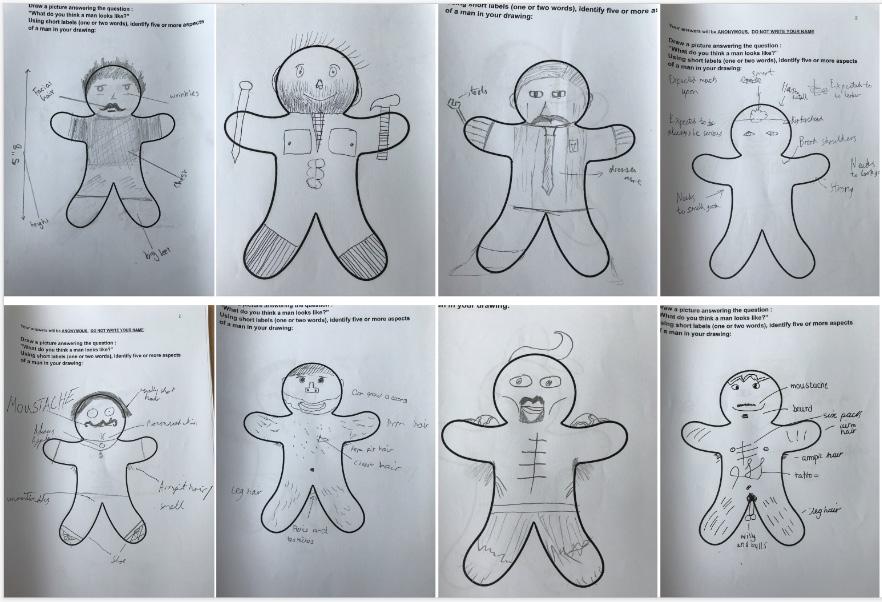
13 Flagship: Journal for Evidence Engaged Practice
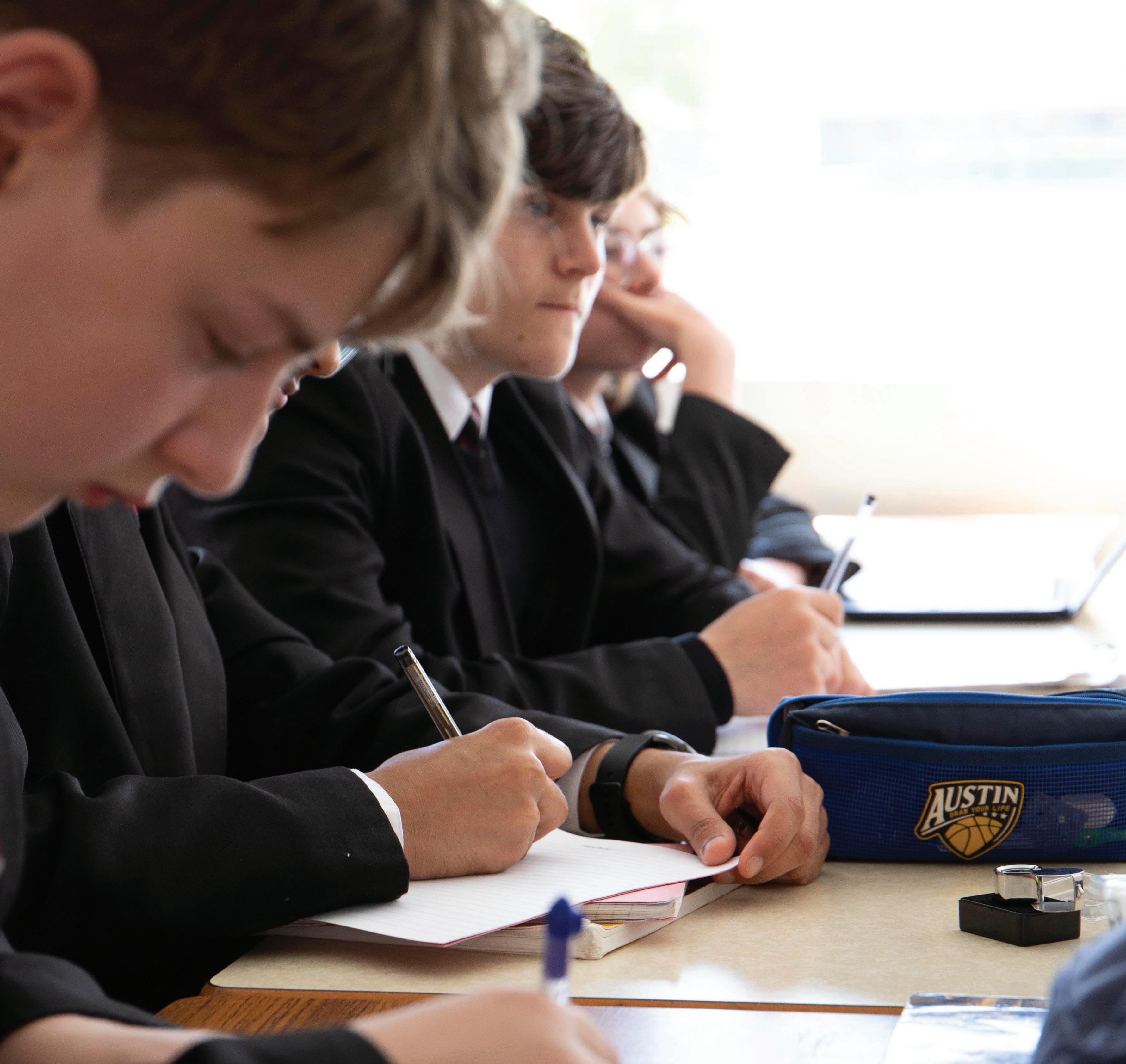
What does Positive Masculinity mean to Year 8 students today?
Hegemonic masculinity is not the majority or the norm, but it is the normative and the model against which all males are measured (Connell & Messerschmidt, 2005, p.832) and it positions itself as superior to all other subordinate non hegemonic masculinities.
Students’ third largest category focused on physicality. Students said, “I am expected to be attractive”, “We want to be handsome”, “We want to be tall” and “I should be physically and mentally strong”.
A small number of students were able to voice a broader set of emotions and vulnerabilities in challenge to the narrow hegemonic masculinity. They said, “I should be able to ask people for help”, “I am kind”, “I respect” and “I am not perfect”.
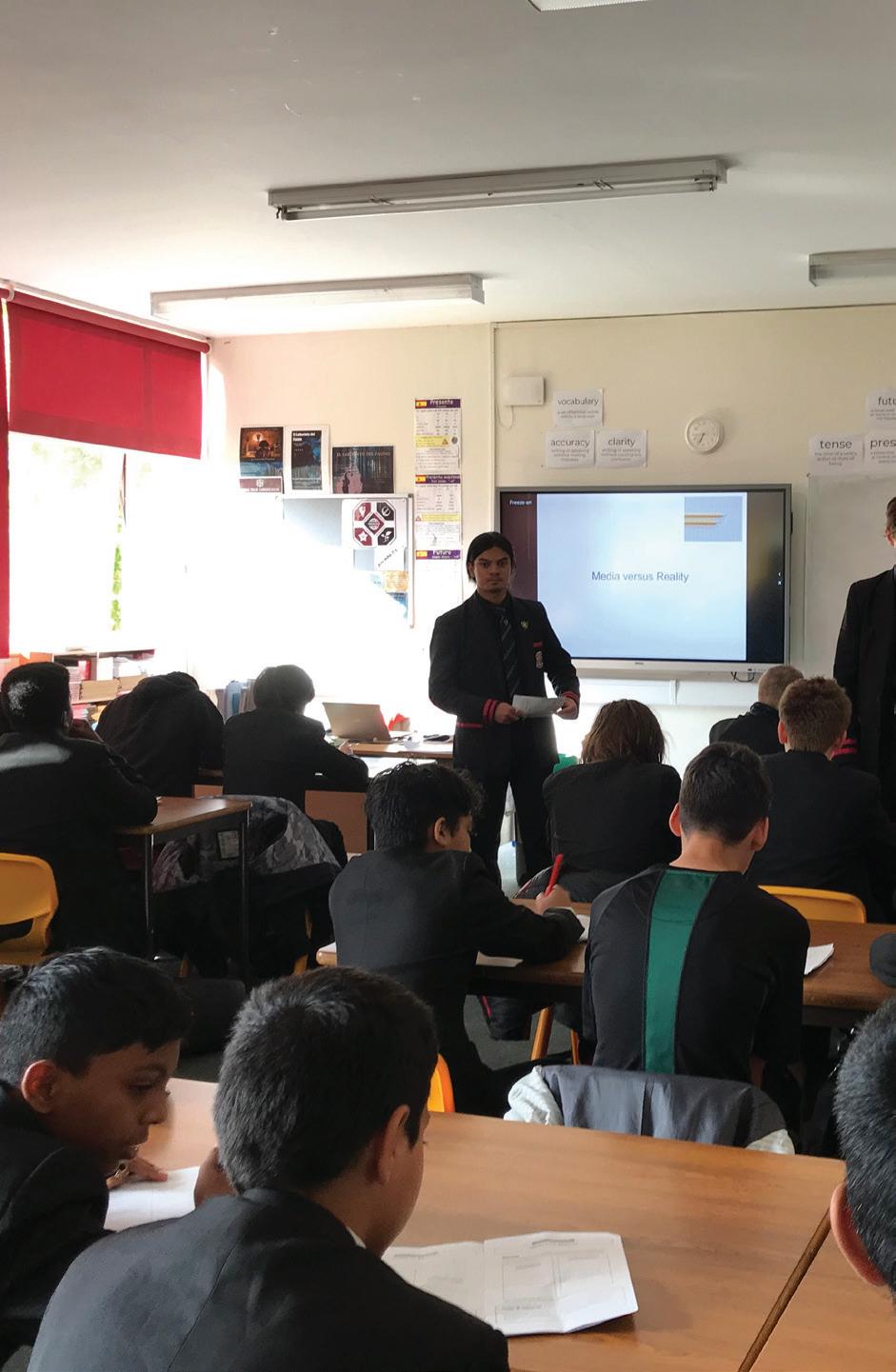
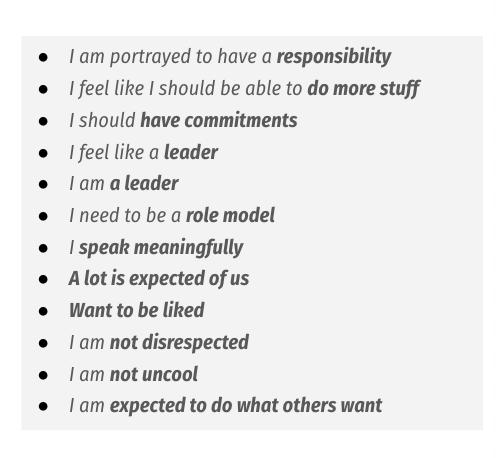


15 Flagship: Journal for Evidence Engaged Practice
Students voiced the narrow masculinity that deprives boys of their full set of emotions granted to them at birth.
After the “As a man …” questions, students were presented with a series of likert scale and similar questions. These questions were designed to test to what extent the hegemonic masculinity described by the literature might be reflected in their answers. The Man Box literature states that boys start to exclude emotions and vulnerabilities as they grow up, based on what they see and learn about them on what it means ‘to be a man’. Our Year 8 students were asked to select all the emotions that they felt it was ok to feel as a man/boy. They articulated that it was ok to feel loving (24 responses), confident (23 responses) and angry (23 responses). At the other end of the scale there were just 19 responses for feeling nervous, 18 responses for feeling sensitive and the lowest score was 17 for feeling vulnerable. In summary, their answers are starting to reflect the narrowing of hegemonic masculinity. Some students added comments to this question and added the additional feelings of “lonely” and “depressed”.

One student positively wrote, “a man can feel anything that he wants” and at the other end of the spectrum another student wrote, “I don’t want to be seen as vulnerable, sensitive, scared, nervous, sad or angry”.
“i (sic) man can feel anything that he wants.” (Student B)
“I don’t wanna be seen as vulnerable, sensitive, scared, nervous, sad or angry.” (Student C)

“When we don’t like a girl, that’s our problem, when a girl doesn’t like us, that’s also my problem.” (Student F)
Students were asked if they felt comfortable crying in front of friends and two-thirds said no, compared to one-third who said yes. Contrast this with the question if students felt comfortable seeing two men kiss each other and just over one-half of students said yes and just under one-third said no. In short, Year 8 boys are more comfortable seeing two men kiss each other than crying in front of their friends. It may be that these results reflect the efforts in society and schools to champion tolerance of sexual orientation. It may also be that these results reflect the work still to do in society and schools to dismantle the constraints of narrow hegemonic masculinity.


w: ags.bucks.sch.uk 16
What does Positive Masculinity mean to Year 8 students today?
Students were asked a series of questions designed to see what associations they would make between masculinity and sport, music and intellectualism, to see whether the literature was borne out in the voices. Over half of students agreed “men should be sporty”, compared to less than a quarter of students who thought that “men should be musical”. Interestingly more than three-quarters of students disagreed that “men should be musical”. Responses on “men should be nerdy/intellectual” also showed weak association with masculinity, with two-thirds disagreeing and onethird agreeing with the statement. The boys’ responses to all three questions show some reflection of the narrow hegemonic masculinity.
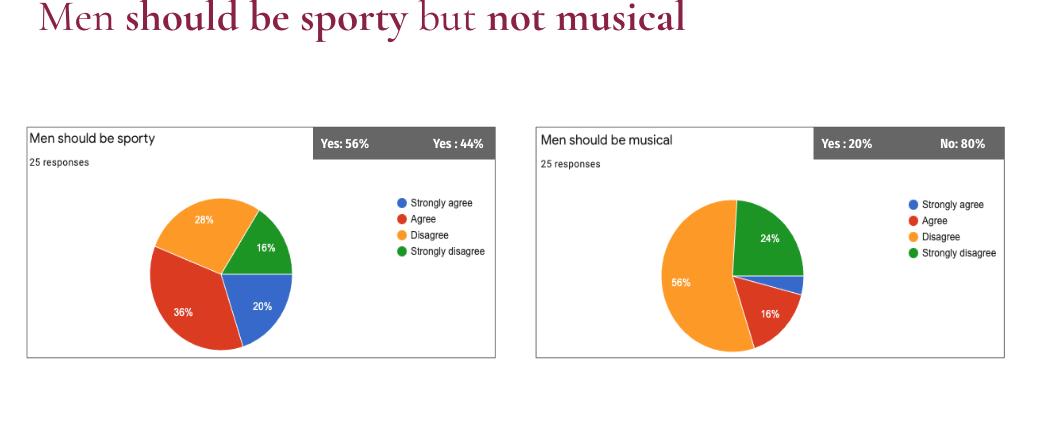
CONCLUSION
When embarking on this action research, I did not know what I would find out, and in particular, I had no sense of what boys thought about masculinity. Yes, I see boys in the classroom and the playground and yes, there are snippets of conversation that I pick up on. But in terms of their deep, inner, private and personal thoughts on this topic, I had absolutely no idea.
The more I researched the literature, the more I reflected on a multitude of levels. I realised how starkly important it is to help boys have open conversations on masculinity. I realised the immense opportunity to lead and support these conversations, together with the terrifying burden of getting it right (or at least, not getting it wrong).
Informed by the literature, I created the Year 8
Students were given free-format questions to be able to add anything they wanted to say, so that the questionnaire could capture their complete and accurate voice as far as possible. One positive free-format response is shared below and it is both erudite and brings optimism.
Questionnaires so that I might capture their voices and see whether and to what extent their thoughts and ideas reflected the literature. I found out that yes, already in Year 8, their voices do reflect the literature and the dominant hegemonic masculinity of today’s society. They already ‘know’ that the full set of emotions gifted to them at birth is slowly being eroded by societal constructs of what it means to be a ‘man’. They already feel a sense of pressure to conform and the negative feelings that go with this.
I hope that the work I am doing with students today and into 2023 will help them take some steps towards dismantling the narrow hegemonic masculinity that pervades today, and allow them to talk more freely and openly. I hope that it will allow them to construct limitless masculinities for themselves and become the new norm for how they see the world around them.
17 Flagship: Journal for Evidence Engaged Practice
“I (sic) just want to say that men can be whatever they want and do whatever they want unless they are harming others.” (Student H)
I realised how starkly important it is to help boys have open conversations on masculinity. I realised the immense opportunity to lead and support these conversations, together with the terrifying burden of getting it right (or at least, not getting it wrong).
REFERENCES
A Call to Men. (2021). The Live Respect Middle & High School curriculum. https://www.acalltomen.org/liverespect/
Anderson, E. (2005). Orthodox and Inclusive Masculinity: Competing Masculinities among Heterosexual Men in a Feminized Terrain. Sociological Perspectives, 48(3), 337–355. https://doi.org/10.1525/sop.2005.48.3.337
Beyond Equality. (2021). Beyondequality.org. Retrieved 29 December 2021, from https://www.beyondequality.org/blog-posts/imagine-toolkit-involving-boysin-preventing-street-harassment.
Brooks, D. (2022). How to Treat Others with Respect. IBSC Conference. The Path to Manhood. Dallas, Texas. 26 June 2022.
Brozo, W. G., Walter, P., & Placker, T. (2002). “I Know the Difference between a Real Man and a TV Man”: A Critical Exploration of Violence and Masculinity through Literature in a Junior High School in the ’Hood. Journal of Adolescent & Adult Literacy, 45(6), 530–538.
Connell, R. (2016). Masculinities in global perspective: hegemony, contestation, and changing structures of power. Theory and Society, 45(4), 303–318. http:// www.jstor.org/stable/44981834
Connell, R. W., & Messerschmidt, J. W. (2005). Hegemonic Masculinity: Rethinking the Concept. Gender and Society, 19(6), 829–859. http://www.jstor. org/stable/27640853
Connell, R. W. (1992). A Very Straight Gay: Masculinity, Homosexual Experience, and the Dynamics of Gender. American Sociological Review, 57(6), 735–751.
Connell, R. W. (1989). Cool Guys, Swots and Wimps: The Interplay of Masculinity and Education. Oxford Review of Education, 15(3), 291–303.
GQ (2019). The State of Masculinity Now (A GQ Survey) https://www.gq.com/ story/state-of-masculinity-survey accessed 19Jan2022.
Edley, N., & Wetherell, M. (1997). Jockeying for position: the construction of masculine identities. Discourse & Society, 8(2), 203–217. http://www.jstor.org/ stable/42888109
EDUCATION - Being ManKind. (2021). Being ManKind. Retrieved 29 December 2021, from https://beingmankind.org/education/.
Farrell, A.D., & Meyer, A.L. (1997). The effectiveness of a school-based curriculum for reducing violence among urban sixth-grade students. The American Journal of Public Health, 87, 979-984.
Gilpin, C., & Proulx, N. (2018). Boys to Men: Teaching and Learning About Masculinity in an Age of Change (Published 2018). Nytimes.com. Retrieved 29 December 2021, from https://www.nytimes.com/2018/04/12/learning/lessonplans/boys-to-men-teaching-and-learning-about-masculinity-in-an-age-ofchange.html.
Harland, K., & McCready, S. (2012). Taking boys seriously - a longitudinal study of adolescent male school-life experiences in Northern Ireland. Department Of Education, 59. Retrieved 30 December 2021, from https://dera.ioe. ac.uk/16385/7/taking_boys_seriously_final.docx_Redacted.pdf.
Harper, S. (2004). The Measure of a Man: Conceptualizations of Masculinity among High-Achieving African American Male College Students. Berkeley Journal of Sociology. Vo.48, pp.89-107.
Hurst, B. (2018, December). Boys won’t be boys. Boys will be what we teach them to be. [Video]. TED. https://www.ted.com/talks/ben_hurst_boys_won_t_ be_boys_boys_will_be_what_we_teach_them_to_be?language=en
Legewie, J., & DiPrete, T. A. (2012). School Context and the Gender Gap in Educational Achievement. American Sociological Review, 77(3), 463–485.
Lu, A., & Wong, Y. (2013). Stressful Experiences of Masculinity Among U.S.-Born and Immigrant Asian American Men. Gender & Society, 27(3), 345-371. https:// doi.org/10.1177/0891243213479446
Lythcott-Haims, J (2022). How Not to Mess Up Your Boys. IBSC Conference. The Path to Manhood. Dallas, Texas. 27 June 2022.
Maricourt, C. de and Burrell, S. R. (2022) ‘#MeToo or #MenToo? Expressions of Backlash and Masculinity Politics in the #MeToo Era’, The Journal of Men’s Studies, 30(1), pp. 49–69. doi: 10.1177/10608265211035794.
Martino, W. (1999). “Cool Boys”, “Party Animals”, “Squids” and “Poofters”: Interrogating the Dynamics and Politics of Adolescent Masculinities in School. British Journal of Sociology of Education, 20(2), 239–263.
Mertler, C., 2019. Action research. 6th ed. California: SAGE.
Messerschmidt, J.W. (2018). Multiple Masculinities. In: Risman, B., Froyum, C., Scarborough, W. (eds) Handbook of the Sociology of Gender. Handbooks of Sociology and Social Research. Springer, Cham. https://doi.org/10.1007/978-3319-76333-0_11
Namy, B.H, Stitch, S., Crownover, J., Leka, B. & Edmeades, J. (2015). Changing what it means to ‘become a man’: participants’ reflections on a school-based programme to redefine masculinity in the Balkans. Culture, Health & Sexuality, 17:sup2, 206-222
Norland, S., James, J., & Shover, N. (1978). Gender Role Expectations of Juveniles. The Sociological Quarterly, 19(4), 545–554. http://www.jstor.org/ stable/4105654
Nye, R. A. (2005). Locating Masculinity: Some Recent Work on Men. Signs, 30(3), 1937–1962.
Parsons, R., & Brown, K. (2002). Teacher as reflective practitioner and action researcher. Belmont, CA: Wadsworth/Thomson Learning.
Pinkett, M., & Roberts, M. (2019). Boys don’t try? Routledge.
Pitts-Tucker, T. (2012). Pressure to keep up macho image may drive men to suicide. BMJ: British Medical Journal, 345(7876), 4–5. http://www.jstor.org/ stable/23278637
Porter, T., (2021). Live Respect: Gender and racial equity curriculum. Acalltomen.org. Retrieved 29 December 2021, from https://www.acalltomen. org/resources/liverespect-gender-and-racial-equity-curriculum-for-youngpeople-ages-10-24/.
Porter, T., (2010). A Call to Men. TED Talk. Retrieved 9 July 2022, from https://www.ted.com/talks/tony_porter_a_call_to_men
Promundo-US and University of Pittsburgh Medical Center (2018). Manhood
2.0: A Curriculum Promoting a Gender-Equitable Future of Manhood. Washington, DC and Pittsburgh: Promundo and University of Pittsburgh.
w: ags.bucks.sch.uk 18
What does Positive Masculinity mean to Year 8 students today?
Safer Schools (2021) Everyone’s Invited – Ofsted Update - Safer Schools. [online] Available at: <https://oursaferschools.co.uk/2021/06/17/everyonesinvited-ofsted-update/> [Accessed 6 July 2022].
Reiner, A. (2021) Better boys, better men: The new masculinity that creates greater courage and emotional resiliency. New York, NY, USA: HarperOne.
Rich, C. G. (2014). Angela Harris and the Racial Politics of Masculinity: Trayvon Martin, George Zimmerman, and the Dilemmas of Desiring Whiteness. California Law Review, 102(4), 1027–1052. http://www.jstor.org/stable/23784359
Shover, N., Norland, S., James, J., & Thornton, W. E. (1979). Gender Roles and Delinquency. Social Forces, 58(1), 162–175. https://doi.org/10.2307/2577791
Sinacore, A., Shaofan, B., & Cheng, P. (2020). Responsible Sexual Citizenship in Today’s World: The Challenges Confronting Boys. IBSC.
Swain, J. (2000). “The Money’s Good, the Fame’s Good, the Girls Are Good”: The Role of Playground Football in the Construction of Young Boys’ Masculinity in a Junior School. British Journal of Sociology of Education, 21(1), 95–109. http:// www.jstor.org/stable/1393361
The Children’s Society (2021). How toxic masculinity affects young people. https://www.childrenssociety.org.uk/what-we-do/blogs/how-toxicmasculinity-affects-young-people
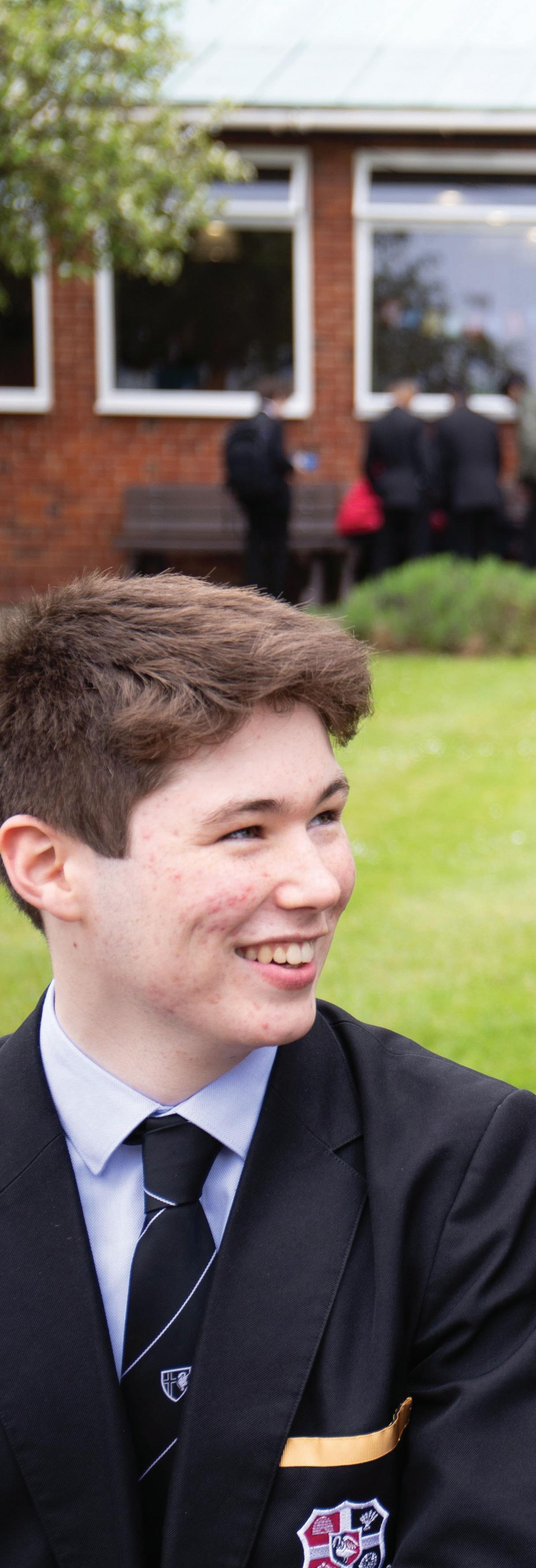
The Representation Project. (2021) The Representation Project. Retrieved 29 December 2021, from https://therepproject.org/about.
Waling, A. (2019) Problematising ‘Toxic’ and ‘Healthy’ Masculinity for Addressing Gender Inequalities, Australian Feminist Studies, 34:101, 362-375, DOI: 10.1080/08164649.2019.1679021
Wang, Z., Chen, X., & Radnofsky, C. (2021). China to teach masculinity to boys because of changing gender roles. NBC News. Retrieved 29 December 2021, from https://www.nbcnews.com/news/world/china-proposes-teachingmasculinity-boys-state-alarmed-changing-gender-roles-n1258939.
Wilkinson, K. (1985). An Investigation of the Contribution of Masculinity to Delinquent Behavior. Sociological Focus, 18(3), 249–263. http://www.jstor.org/ stable/20831367
Willer, R., Rogalin, C. L., Conlon, B., & Wojnowicz, M. T. (2013). Overdoing Gender: A Test of the Masculine Overcompensation Thesis. American Journal of Sociology, 118(4), 980–1022. https://doi.org/10.1086/668417
Whitehead, S. (1998). Hegemonic masculinity revisited. Gender, Work, and Organization, 6(1), 58-62.
19

ABSTRACT
Schools are a place where students have the opportunity to receive and experience lessons, ranging from moral, personal and educational (Ryan and Lickona, 1992; Lerner, 2018), but do students really gain more than academic progress from lessons? The national curriculum for Physical Education identifies the requirement for students to become physically confident alongside building their character (Department for Education, 2012), which in turn should further promote and reinforce the wider development of our students than a single aim of educational achievement through their school lives. This research explores what lessons can offer aside from the academic progress from the perspective of the students themselves, with a focus on character development, particularly ownership.
Despite there being a clear vision and required desire to teach more than just the subject content, historically there has been a “hesitation” among the educational community to steer away from a “traditional” teaching programme. These concerns stem from a dominant ideology that lessons may “detract from the focus” of “increasing academic performance” (Benninga et al., 2006, p.448-452), suggesting that content knowledge not only holds a higher priority than developing young people, but also that both character and personal development can not occur alongside the learning of the subject. Fortunately, this view is becoming increasingly outdated, with a number of schools developing character education models, such as the AGS Learner. These models underpin key characteristics that shape young people in preparation for their future, but hold no overruling structure on how these are integrated or experienced for the student. Again, as previously stated, this project focuses on character development within lessons, but will further explore the impact a student centred teaching style has on exposing aspects of the AGS Learner to students, with ownership being the prioritised focus.

Flagship: Journal for Evidence Engaged Practice
What is the impact of either a student centred or games approach on key stage 3 students’ character development, particularly ownership, during P.E. lessons?
Harry Dudmish Teacher of P.E.
Mosston and Ashworth (1990, 2002) for a number of years have been academics within the field of education, creating the “spectrum of teaching styles”. This spectrum indicates the broad range of teaching methods that can be used to deliver subject knowledge to the students. Despite there being multiple styles across the spectrum, there are two opposing agendas that encompass these: a student centred and teacher centred approach. Since then, there has been a magnitude of research surrounding the spectrum and methods within, indicating positives such as character development around student centred styles (Kaput, 2018). However, this project does not seek to debate which style of teaching is greater or holds more value, but rather to examine the impact a student centred approach has on the character development of students in P.E., while still exposing students to the school and national curriculum in lessons.
In summary, this research will look at clarifying three aims around the topic of character development.
1) Do P.E. lessons allow students to build their character as required in the national curriculum, and expose them to aspects of the AGS Learner?

2) Does a student centred approach, as suggested by academics, have an impact on character development?
3) Following on from the previous aims, how much is the ownership of the students enhanced and nurtured within P.E.?
What is the impact of either a student centred or games approach on key stage 3 students’ character development, particularly ownership, during P.E. lessons?
CONTEXT
There are a number of reasons this project was carried out, which include investigating methods of integrating the AGS Learner into lessons, offering more to students than just the curriculum and subject knowledge, and gaining an understanding of the students’ perspective of physical education and teaching styles. All of these were underpinned by an ever present factor of still providing a valuable sequence of lessons following the department’s scheme of work, with an effort of nurturing character throughout.
Aylesbury Grammar School has been nurturing character since 1598, and can proudly demonstrate the development of character all the students experience throughout their school lives, while obtaining outstanding GCSE and A Level results. This combination results in students leaving AGS as young adults well prepared for their future, both academically but also in wider society. However, students are also required to develop wider skills and characteristics effectively in the younger year groups, just as much as the senior students. For a number of years the Year 7 cohorts have been formed by a spread of differing primary schools, with many new students joining AGS as a single student from their previous school, and not knowing anyone in their form, year or the school community. In 2022/23 the Year 7 body will include boys from 75 primary schools across neighbouring counties, highlighting the diverse group of young students joining, but also the immediate need for students to have suitable social and personal skills to cope with such change.
achieve their next step in education and their future careers. More specifically, P.E. at both GCSE and A-level also matches the school trend of high grades, alongside multiple students forming successful careers within the sport industry. However, despite the successes AGS P.E. provides within education and careers, the uptake of students selecting GCSE P.E. over recent years ranges between 20-30 boys, which equates to 14%. Equally, for A Level, student numbers range between 5-10 for P.E., which is 4% of the year. With over 80% of boys not selecting P.E. as an option, is there a need for such a dominant skill development focus for all students in KS3? Or can P.E. offer more by using physical activity as a vehicle to teach sport alongside wider skills and benefits?
LITERATURE REVIEW
For many years it has been known that schools are a great facilitator for young people to experience multiple developmental benefits which include character (Ryan and Lickona, 1992; Lerner, 2018), yet there has been a consistent reluctance to veer away from anything that is not curriculum focused (Benninga et al., 2006). However, more recent studies can suggest that this view within education is becoming increasingly outdated (Hellison, 2010; Arthur et al., 2016; Pike, et al., 2021), with frameworks such as character development models being in place nationwide, and school structures and environments lending themselves to support students in wider enrichment (Lavy, 2020). In addition to this, when looking into the specific topic of sport, historically there are clear indications that a sporting environment too provides fantastic opportunities to enhance these factors (Shields and Bredemeier, 1995; Gould and Carson, 2008). Despite academics highlighting the huge positive scope around personal development within schools and sport, there is limited indication of which methods best enhance the opportunities for these developments to occur.
Similar to the pattern of the Year 7 intake, is the display of excellent GCSE and A-level results students achieve from Aylesbury Grammar School. Throughout the School, in each subject, students obtain fantastic grades to help them
Research from Solomon (1997) and Rahman (2007) opened up two significant views on delivering P.E. to students and how sports can holistically be taught. The first, and arguably most obvious, is known as “teaching of the physical”. This very much relates to the “traditional” way of teaching, which involves teaching skill acquisition and seeking performance development and sporting understanding. The second approach is “teaching through the physical” which allows for broader learning to take place, while using the sport as the vehicle for learning to occur. New research indicates
23 Flagship: Journal for Evidence Engaged Practice
For many years it has been known that schools are a great facilitator for young people to experience multiple developmental benefits which include character.
that these applications can be blended together to allow students to develop their sporting ability alongside their character, social and life skills (Suherman, Supriyadi and Cukarso, 2019; Pennington, 2019), which could be a factor in why there is now less reluctancy in character development within lessons. However, none of these academics were able to expand on teaching styles and methods for best delivering these approaches. Only in the last decade has there been any definitive research into specific teaching styles that are proposed to support character development alongside educational learning within lessons. Prior to this, academics could only offer looser suggestions in what can be incorporated to aid with wider enrichment of students, such as offering students a range of experiences within the same lesson (Siedentop, 1994; Hanif, 2006); lessons that utilise different motivational aspects (Deci and Ryan, 1985; Rahman, 2007); competition (Shields and Bredemeier, 1995) and social/team activities (Tutkun, Görgüt and Erdemir, 2017). In comparison, much more recent literature proposes that a student centred approach, and more specifically, a Teaching Games for Understanding (TGfU) approach is well suited to enhance character, particularly due to the use of conditioned games (Harvey, Kirk and O’Donovan, 2014; Sujarwo et al., 2021). Sujarwo et al. (2021) further expands on this, with an understanding that by providing clear parameters for students to work in, while not dictating on a specific technical focus, students will be able to find a range of successful ways to achieve the goals set out, and ultimately learn through this process and be exposed to social and personal developmental opportunities. However, there is a requirement for consistent reinforcement with aims and for lesson objectives to be clear, otherwise the focus of the lesson can become lost, and students may not receive any benefits from this style of teaching (Griffin and Butler, 2005; Mitchell, Oslin and Griffin, 2013). This limitation to TGfU can be directly linked back to Solomon (1997) and Rahman (2007), where using sport as a vehicle for learning, rather than a direct skill acquisition focus, can allow for students of differing ability to learn at different rates, alongside having different experiences to enhance characteristics. This integrated approach of blended learning for all has been supported for a number of years, particularly when it comes to the inclusion of character development (Berkowitz and Bier, 2005; Felderhof and Thompson, 2014; Pike, 2015).
METHODOLOGY
This project focused solely on KS3 students, across four support classes ranging from Year 7 to 9. With a wide sample of students being exposed to this research, there was an aim to be able to collate data from an array of perspectives, providing a true reflection on the impact a student centred approach has. The objective of accumulating accurate data from research within the character development field can provide challenges, as personal development can be difficult to assess externally (Mambu, 2015; Halonen et al., 2020). With this in mind the data collection process concentrated predominantly on questionnaires to provoke a self reflection process, which is suggested to hold greater value (Elias, Ferrito and Moceri, 2015). Although this collection method relies heavily on student comprehension and honest self reflection, the use of such a broad sample size should allow for anomalies to become filtered out.
As one of the aims within this research was to gain an understanding of the impact a student centred approach has on character development, students were required to complete an initial questionnaire, as an opening reference point for future comparisons to take place. The methodology had two data collection points, one before the TGfU unit of work started, and then one at the end. As suggested by Pike et al. (2021), this framework will offer suitable opportunities to assess each collection point separately, alongside comparing the impact the student centred approach had, using thematic analysis. Both of these data points used the same questionnaire to allow for more accurate comparisons, but with the final questionnaire also having extended probing questions around ownership, to enhance the search for specific understanding within this characteristic.
w: ags.bucks.sch.uk 24
What is the impact of either a student centred or games approach on key stage 3 students’ character development, particularly ownership, during P.E. lessons?
In addition to the questionnaires, students who were unable to participate in P.E., due to no kit or injuries, would be completing a live observation and reflection sheet on the lesson taking place. This provided an added lens to the research allowing for students to express their views during the unit of work, in addition to the two collection points. This ‘non-doer sheet’ in conjunction with the questionnaire provided both quantitative and qualitative feedback, which now offered some reasoning behind the numbers that would be gathered.

This streamlined data collection method had the single focus of clarifying the three aims previously mentioned, with little deviation. With two assessment points, one initial and one final, alongside the non-doer sheet there was a specific focus on quantitative data, with some qualitative to provide context.
FINDINGS
The initial and final questionnaires provided a source of discussion not only around the particular topic of ownership, but also the general topic of character development within P.E. This section will aim to break down the questions asked in the questionnaire, with an analysis from the results gathered.
25 Flagship: Journal for Evidence Engaged Practice
The first is known as “teaching of the physical”... which involves teaching skill acquisition and seeking performance development and sporting understanding. The second is “teaching through the physical” which allows for broader learning to take place, while using the sport as the vehicle for learning to occur.
Both charts above highlight that there is a general consensus within the sample group that P.E. does have an impact on the development of character. Both assessment points showed four as the highest response, which corresponds to students thinking P.E. has an impact on character, indicating that sports does offer opportunities for personal development to occur. This supports the research from Shields and Bredemeier (1995), Gould and Carson (2008), which stated how effective a positive sporting environment can be.
When comparing the two results, it is initially clear to see that fewer students, after experiencing a TGfU unit, strongly believe P.E. developed their character, yet the remaining categories hold similar numbers between the sets of data. This could imply that on the surface, a unit of work on TGfU has little differing impact in comparison to a varied format of teaching, however when diving deeper into the questioning, this view starts to change.
Immediately, on both graphs it is clear that a large proportion of students feel that the games aspects of lessons have a significant impact on their character development. Also, it is interesting to see that between the two sets of data, there is both an increase in the perceived impact games have on character, in addition to a drop off in the impact of drill activities. This clearly highlights that students themselves, upon reflection, believe their personal development is most likely to be enhanced most during game situations, rather than drills. These findings directly coincide with research from Harvey, Kirk and

O’Donovan (2014) and Sujarwo et al. (2021), indicating that in fact conditioned games do enhance the development of young people’s character. Although there was both an increase in responses for games, and a decrease in drills, around a fifth of students believe drill activities support their character development. This can suggest that using a mixed approach would cater for a wider range of students, but would this then affect the majority of the class that selected games, or dilute the amount of opportunities to develop character by blending methods?

w: ags.bucks.sch.uk 26
HOW STRONGLY DO YOU BELIEVE P.E. DEVELOPS YOUR CHARACTER?
WHEN DURING A LESSON DO YOU FEEL CHARACTER IS DEVELOPED?
What
P.E.
is the impact of either a student centred or games approach on key stage 3 students’ character development, particularly ownership, during
lessons?
Firstly, with the students, the term ownership was interchanged frequently with leadership, resulting in discussions and data collection requiring to group the two terms together. From the data collected, it was evident that the student body was equally split with how they felt ownership was developed using a TGfU approach to the unit. The majority placed themselves in the middle ground (3), with a fairly equal proportion leaning towards they believed/strongly believed (4 and 5) conditioned games enhanced ownership in comparison to not believing/ strongly not believing (1 and 2). The fact students exchanged ownership and leadership could imply there is a misunderstanding with the terminology, which has then resulted in the majority selecting option 3. However, these results could also suggest that ownership is not a considerable factor that is developed through games from the students’ perspective, and that they believe other characteristics are enhanced more through the use of games. It is evident from previous graphs that students believe characteristics are developed through conditioned games, although maybe not ownership/leadership as much.
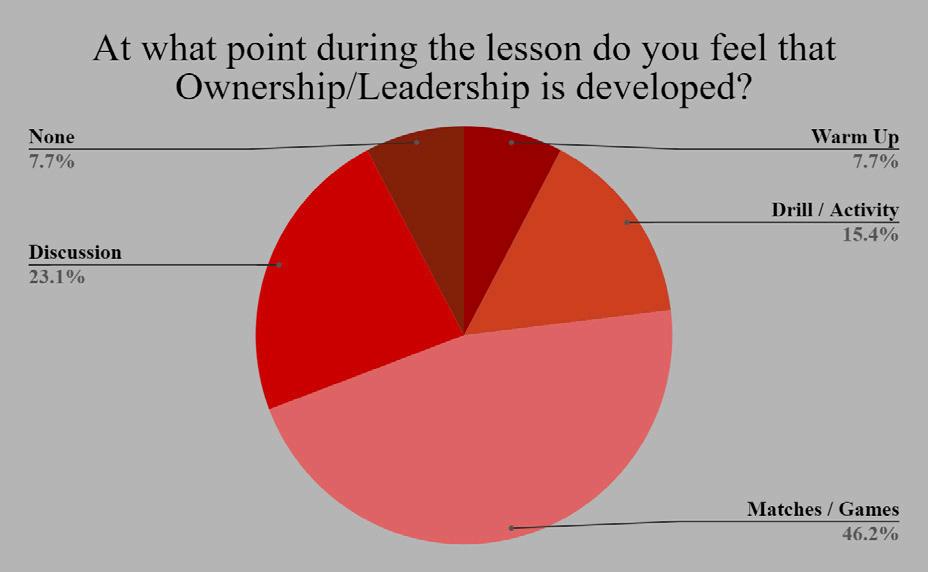
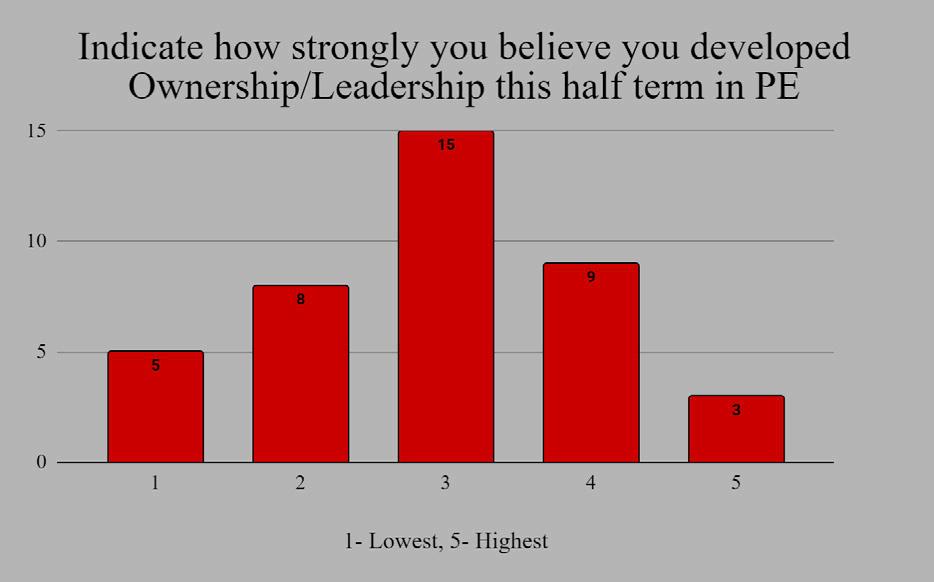
Although the previous graph indicated no suggestions that a TGfU approach impacts ownership, further questioning would rather suggest that the topic of work, or P.E. itself, has little effect on ownership development. This is because, when students were asked when ownership is developed during lessons, games again received the greatest response. In addition to this, drills received a huge drop off in comparison to games and discussions, and in previous questioning regarding wider characteristics. This highlights that a TGfU approach could offer some support with ownership being enhanced in comparison to reciprocal or command focus teaching styles, as only 15% of students stated drills as a response.
When students were further questioned into when specifically they felt the characteristic of ownership was most apparent for them, responses signal more reinforcement around the research of Harvey, Kirk and O’Donovan (2014) and Sujarwo et al. (2021) on TGfU.
The image above shows the written responses of students, with the use of thematic analysis to group like-minded statements together to build a picture of the students’ thoughts - the larger the words, or phrases, the more common the response was. Many of these responses circulate around the theme of matches or gameplay, hinting that it is during a game when most students take ownership of their actions, learning or activity.

27 Flagship: Journal for Evidence Engaged Practice
HOW STRONGLY DO YOU BELIEVE OWNERSHIP/ LEADERSHIP WAS DEVELOPED DURING THE TGFU UNIT?
WHEN DURING A LESSON DO YOU FEEL OWNERSHIP/LEADERSHIP IS DEVELOPED?
In 2022/23 the Year 7 body will include boys from 75 primary schools across neighbouring counties, highlighting the diverse group of young students joining, but also the immediate need for students to have suitable social and personal skills to cope with such change.
This correlates not only with research previously stated, but also ties together the previous graphs from the quantitative data, evidencing that students can not only identify what activities best support their personal development, but when specifically during these lessons characteristics are being practised.
STUDENT OBSERVATIONS
What teaching style was predominantly used in the lesson?
Centered 3
CONCLUSION
In summary, this project offered reinforcement to many of the academics stated within the literature review, with a comprehensive understanding of what P.E. and a TGfU approach can provide for students away from skill acquisition. Throughout this research were three aims that underpinned the focus, and which structured this report.
1) Do P.E. lessons allow students to build their character as required in the national curriculum, and expose them to aspects of the AGS Learner? When reflecting on both the initial and final data collection points, it seems apparent that P.E. certainly can offer, and does offer, the opportunity to develop aspects of the AGS Learner to the overwhelming majority of students.
In addition to the student reflections, any non-doer was required to provide live observations, indicating their thoughts on the teaching style being used, and then the characteristics being exposed during the lessons. These observations demonstrate, and further support, both previous findings from this research and academics, as the students observing the lessons noted that a teacher centred approach provides the fewest opportunities to develop characteristics. In addition to this, the observations also indicate that there is no opportunity for students to take ownership during a teacher centred delivery of a lesson. In comparison, a student centred approach, and an equal combination, offers many more opportunities for personal development, with ownership being stated in both styles.
2) Does a student centred approach, as suggested by academics, have an impact on character development? Certainly. A student centred approach provides a magnitude of opportunities for character to be enhanced and developed. There is, however, certainly a suggestion that an equal combination of both teacher and student centred approaches could offer richer value to a wider range of learners.
3) How much is the ownership of the students enhanced and nurtured within P.E.? Ownership is a factor that is involved with P.E., and based on the observations, significantly more so when delivered with a student centred style. However, it seems that other characteristics are developed more within P.E., and that student understanding of ownership, and possibly other characteristic terminology requires clarity and further learning and defining.

w: ags.bucks.sch.uk 28
Student
Teacher
Equal
Centered 2
combination 3
What is the impact of either a student centred or games approach on key stage 3 students’ character development, particularly ownership, during P.E. lessons?
REFERENCES
Arthur, J., et al., 2016. Teaching character and virtue in schools. Routledge
Benninga, J., et al., 2006. Character and academics: What good schools do. Phi Delta Kappan, 87(6), pp.448-452.
Berkowitz, M. and Bier, M., 2005. What works in character education: A research-driven guide for educators. Washington, DC: Character Education Partnership.
Deci, E. and Ryan, R., 1985. Motivation and self-determination in human behaviour. NY: Plenum Publishing Co.
Department for Education, 2012. Physical education programmes of study: key stages 3 and 4.
Elias, M., Ferrito, J. and Moceri, D., 2015. The Other Side of the Report Card: Assessing Students’ Social, Emotional, and Character Development. Corwin Press.
Felderhof, M. and Thompson, P., 2014. Teaching Virtue The Contribution of Religious Education. London.
Gould, D. and Carson, S., 2008. Life skills development through sport: Current status and future directions. International review of sport and exercise psychology, 1(1),
Griffin, L and Butler, J., 2005. Teaching Games for Understanding: Theory, Research, and Practice. Champaign, IL: Human Kinetics.
Halonen, J. et al., 2020. The Challenge of Assessing Character: Measuring APA Goal 3 Student Learning Outcomes. Teaching of Psychology, 47(4).
Hanif, A., 2006. Sport. Ed @ Zhenghua Secondary School. Physical Education Newsletter, 20, 6-7.
Harvey, S., Kirk, D. and O’Donovan, T., 2014. Sport education as a pedagogical application for ethical development in physical education and youth sport. Sport, Education and Society, 19(1).
Hellison, D., 2010. Teaching personal and social responsibility through physical activity. Human Kinetics.
Kaput, K., 2018. Evidence for Student-Centred Learning. Education evolving.
Lavy, S., 2020. A review of character strengths interventions in twenty-firstcentury schools: Their importance and how they can be fostered. Applied Research in Quality of Life, 15(2).
Lerner, R., 2018. Character development among youth: Linking lives in time and place. International Journal of Behavioural Development, 42(2).
Mambu, J., 2015. Challenges in assessing character education in ELT: Implications from a case study in a Christian university. TEFLIN Journal, 26(2).
Mitchell, S., Oslin, J. and Griffin, L., 2013. Teaching Sports Concepts and Skills: A Tactical Approach for Ages 7 to 18. Human Kinetics: Leeds.
Mosston, M. and Ashworth, S., 1990. The Spectrum of Teaching Styles. From Command to Discovery. Longman, White Plains, New York. Mosston, M., and Ashworth, S., 2002. Teaching physical education (5th ed.). Boston, MA: Benjamin Cummings.
Pennington, C., 2019. Creating and confirming a positive sporting climate. Journal of Physical Education, Recreation & Dance, 90(4).
Pike, M. et al., 2021. Character development through the curriculum: teaching and assessing the understanding and practice of virtue. Journal of Curriculum Studies, 53(4).
Pike, M., 2015. Ethical English – Teaching and Learning in English as Spiritual, Moral and Religious Education. Bloomsbury, London.
Pike, M., et al. 2021. Character development through the curriculum: teaching and assessing the understanding and practice of virtue. Journal of Curriculum Studies, 53(4).
Rahman, H.A., 2007. The zhenghua PE experience: A constructivist approach to character development through physical education.
Ryan, K. and Lickona, T., 1992. Character development in schools and beyond (Vol. 3). CRVP.
Shields, D. and Bredemeier, B., 1995. Character development and physical activity. Human Kinetics Publishers.
Siedentop, D., 1994. Sport education: Quality PE through positive sport experiences. Human Kinetics Publishers.
Solomon, G., 1997. Does physical education affect character development in students?. Journal of Physical Education, Recreation & Dance, 68(9).
Suherman, A., Supriyadi, T. and Cukarso, S, 2019. Strengthening national character education through physical education: An action research in Indonesia. International Journal of Learning, Teaching and Educational Research, 18(11).
Sujarwo, S. et al., 2021. The Development of Physical Education Learning Models for Mini-Volleyball to Habituate Character Values among Elementary School Students. Sport Mont, 19(2).
Tutkun, E., Görgüt, İ. and Erdemir, İ., 2017. Physical Education Teachers’ Views about Character Education. International Education Studies, 10(11).
29 Flagship: Journal for Evidence Engaged Practice

What is the impact of either a student centred or games approach on key stage 3 students’ character development, particularly ownership, during P.E. lessons?
To what extent can Year 9 students’ perceptions of role
and challenged within teacher and peer-led Personal Development sessions?
ABSTRACT
One of the key aims of education is to build character and help build young people into adults prepared to contribute to society, and we would like to think in doing this we are building role models. There is, however, a lot of debate and discussion around how students understand what a role model is or should be, and more interestingly where students might identify role models. As teachers, we often like to think of ourselves as role models, but how else can we help our young people to develop themselves into positive role models for society?
The aim of this research project is to investigate how our students perceive role models, their characteristics and where they view themselves within this. It then seeks to consider how teacher and peer intervention can be used to broaden and challenge these notions, and create greater discussion in the classroom of what makes a good role model. Within this, it evaluates the success of a series of Personal Development sessions in AGS with Year 9 that is one such example of this intervention in action. By assessing their engagement, attitudes and ideas, the research provides some interesting results, highlighting the potential benefits of peer discussions and sessions across a wider cohort.

31 Flagship: Journal for Evidence Engaged Practice
models be broadened
James Taylor Teacher of History
CONTEXT
Aylesbury Grammar School is a selective boys’ grammar school in Buckinghamshire, founded in 1598. It prides itself on not only achieving outstanding results at both GCSE and A Level, but offering a wide ranging extra-curricular provision to encourage access to a full and expansive curriculum. This is underpinned by a commitment to nurturing character development through the wider AGS Learner ideal, comprising the five broad characteristics of Ownership, Courage, Resilience, Innovation and Motivation.
As part of the wider development of character education in school, Personal Development sessions were introduced as part of a form tutor’s responsibilities during extended registration with their form group. These sought to discuss a series of issues, and encourage students to reflect upon their own character, values and attitudes. This also took place in a wider focus more recently on positive masculinity, with Positive Sexual Citizenship and Positive Masculinity both forming key foci in the School Development Plan for the year. This research sits alongside these priorities, as issues of role models and masculinity, research suggests, can be addressed alongside one another and are in many ways intertwined issues.
Across the academic year 2021-22, I have been a form tutor for a Year 9 group, and this seems a clear juncture in their school journey. They have transitioned fully into secondary school life, are a year group affected by Covid and during this year also begin to make choices down their future pathways by picking their GCSE options. This is also a key moment in which ideas of role models, masculinity, and leadership can be embedded - these students in the next year or so may be aspiring to Junior Prefect positions, taking on increased responsibilities, as well as facing potential challenges and barriers as they embark on GCSEs.
Therefore, this six week series of Personal Development sessions sought to both gain insight into their perceptions of role models, and thus what might influence their behaviour, values and attitudes towards masculinity and leadership. It also aimed to instil greater confidence in these students in themselves as potential role models for the future, and encourage them to seek to be positive role models.
LITERATURE REVIEW WHERE DO WE FIND ROLE MODELS?
Role models are discussed throughout society, with the term itself now to an extent amalgamated with other ideas, such as leadership, masculinity and achievement. This is something that Carrington and Skelton (2003) support, arguing:
“a role model today is most often equated with ‘a symbol of achievement’ and is sometimes conflated with being a ‘star’ or ‘idol’”
This seems, most obviously, to explain the idolisation and admiration of celebrities and famous individuals today, which is a factor that is worth discussing when it comes to how young people may view, and indeed misinterpret, role models.
Understanding role models, and how they are developed, can be discussed within traditional learning theories, particularly social learning theory (Bandura, 1986). Within this, Bandura argues that attitudes, values, and beliefs are formulated and learned through observation of others and experiences. Thus, the importance of role models cannot be understated, if this will lead others to transform their own behaviours in response. Role models are likely to be key to the socialisation process, and a great source of learned behaviour.
Thus, education is one area in which role models are sought, and there is a suggestion that young people have a narrowed view of role models that needs addressing by schools, as research suggests young people rarely challenge themselves on where attitudes come from, nor easily find reference points to change their outlook and values (Odih, 2002). Schools absolutely can tackle this, but the fact that this often then leads to more prescriptive solutions of ‘role models’ to address underachievement and ‘laddish’ behaviour in particularly young boys is interesting. suggesting an assumption that purely increasing the presence of role models within schools might be the solution (Francis, 2000). Whether this is achievable is one thing, but whether it is even necessary, for example, for male teachers to act as role models specifically for young boys is an assumption that research can challenge.
When it comes to where young people find role models, parents are cited frequently in research to be pivotal and
w: ags.bucks.sch.uk 32 To what extent can Year 9 students’ perceptions of role models be broadened and challenged within teacher and peer-led Personal Development sessions?
main role models (Stephens, 2006; Wiese and Freund, 2011). The idea that young people would emulate their parents is not surprising given Bandura’s socialisation theories, but the fact that further studies have continued to highlight this, and especially the lack of teacher presence in young people’s choice of role models, poses interesting questions - one that my research intended to unpick with our students.
WHY ARE ROLE MODELS IDENTIFIED?
Whether young people consciously decide on role models is a question debated and discussed within research, but studies have shown that individuals are more likely to find affinity with a role model based on various characteristics. While factors are likely to be unique to individuals, patterns have emerged such as the fact that social class and gender are likely to be shared characteristics that drive a choice of role model (Lucey, 2001).
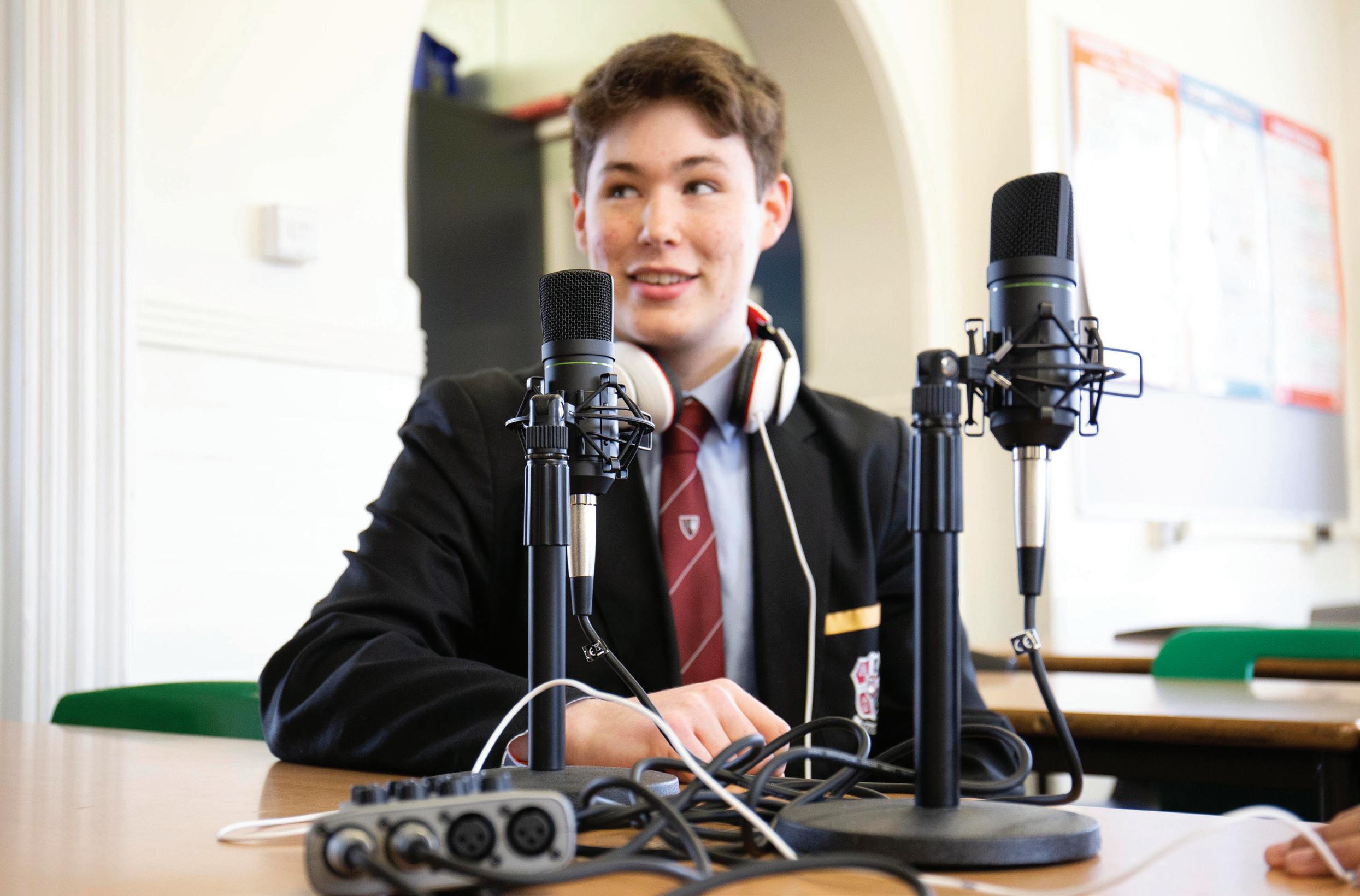
Similarly, they are more likely to choose role models based on their own goals (Lockwood, Jordan and Kunda, 2002). This might offer some explanation to Carrington and Skelton’s earlier assertions, as individuals may well seek a ‘symbol of achievement’ to emulate, in the hope of replication of their accomplishments.
ROLE MODELS AND MASCULINITY
Masculinity, and especially the recent discourse around positive masculinity, have driven the debate about role models particularly for young men. Whilst some research corroborates the notions of shared characteristics, there is an additional layer suggested by some studies that indicates that ability, proficiency and experience are viewed as of greater importance to someone’s ‘role model’ status than more authentic qualities (Fleming et al., 2005). The idea that a role model could be athletic and sporty, but lack compassion, empathy or sensitivity, ties into some contemporary discussions around narrowed views of masculinity, such as the Man Box idea (Porter, 2010; Hurst, 2018; Reiner, 2021).
Similarly, these questions are discussed in the context of schools and education. Cushman (2008) indicated in his research that young male students may identify more with role models that characterise ‘real men’ - his study even cited schools in which their recruitment process sought these characteristics in their male staff. Given previously discussed research, indicating that teachers were not often cited as role models, it might appear concerning that this is the method being used to address underachievement and lack of role models for students.
One more promising route, therefore, to addressing the same issue is in NPRM (near-peer role models) (Murphey, 1998; Beatty and Tillapaugh, 2007). By considering shared characteristics such as age, social class, gender within this, the use of peers to discuss and challenge ideas of role models provides a potentially more lucrative opportunity for students to engage in more meaningful dialogue around their role models and how they might affect their attitudes and behaviours.
w: ags.bucks.sch.uk 34
To what extent can Year 9 students’ perceptions of role models be broadened and challenged within teacher and peer-led Personal Development sessions?
The use of peers to discuss and challenge ideas of role models provides a potentially more lucrative opportunity for students to engage in more meaningful dialogue around their role models and how they might affect their attitudes and behaviours.
RESEARCH QUESTION
The aim of this research was to seek student voice on their ideas of role models, both in terms of how they might define them, and the attributes that create a good role model. This was then developed into a series of Personal Development sessions within registrations over a half term, in which the aims were to challenge and broaden these ideas of role models, and increase student confidence in themselves as role models. The hope was that this would see positive engagement, as well as create a safe space for students to challenge assumptions and explore broader ideas of role models.
The following questions helped guide this research:
1) What are students’ existing ideas of role models? How do they define them? What examples and attributes of role models do they identify with?
2) How can Personal Development discussions be used to challenge and broaden these ideas?
3) Does this enable students to become more confident in themselves as role models?
METHODOLOGY
The study was focused on my Year 9 form group. This was both convenient sampling, in the sense that I had the opportunity and time with them to complete this, but they were also a wide range of students in which a range of qualitative data could be gathered. Data was collected through two surveys, pre- and post-unit to gather data on engagement and student voice.
The overall process was conducted as follows:
1) Students completed a survey at the end of the Spring Term before heading off for Easter break
2) Personal Development sessions were planned for the six weeks that followed, driven by any key points from the survey and with sessions led by Tutor Group Prefects
3) The series of sessions were delivered over the first half term in Summer, and students were also encouraged to engage and research around and between these sessions
4) The students at the end of the series completed a final survey including their final reflections upon the sessions and any feedback
The surveys contained a variety of questions, both closed statements asking for a score on a scale of 1-5 (1 being strongly disagree and 5 being strongly agree), as well as spaces for further explanation in writing that could be drawn from as qualitative data. This provided a variety of quantitative and qualitative data, valuable both for tracking shifts in engagement and mindsets, but also to gain a greater understanding of student voice and feedback through the comments received.
It was also important to me that, certainly in terms of qualitative data, the student voice was as authentic as possible so I ensured that students understood how this data would be used, and the data was collected and presented anonymously throughout the process.
35 Flagship: Journal for Evidence Engaged Practice
The discussions we had in sessions around attitudes, values and behaviours appears to have had some effect here on students being more conscious of how role models might impact them.
FINDINGS
Before embarking on the project itself, the expectation was that students would largely conform to the trends identified in the literature, and that this would open up opportunities to challenge and broaden these ideas. The hope was that they would engage well with the Personal Development sessions, and there would be an uplift in confidence about their own qualities, as well as a broader and more articulate outlook on role models.
INITIAL SURVEY

Students were first asked whether they would consider themselves a good role model. This was before any discussion of role models, in terms of definitions and characteristics, and predominantly students appeared generally confident that they are a good role model, although there was a spread. Interestingly, there was a downturn when asked whether others would consider them a good role model - it appeared that students, while self-confident seemed less sure they projected the qualities outwardly of a good role model.
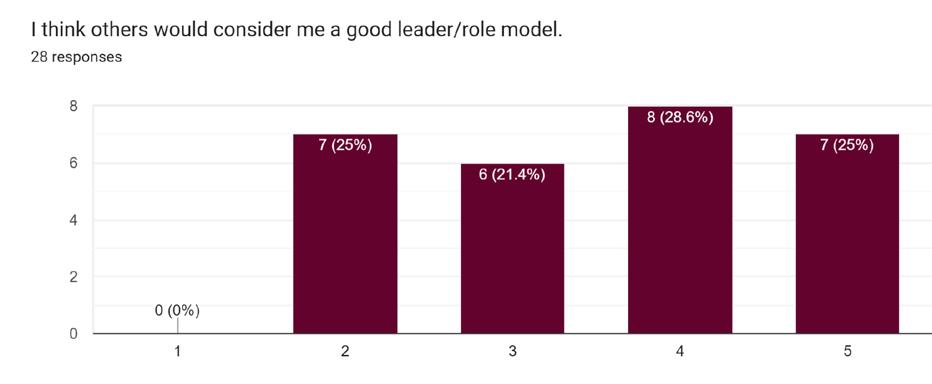
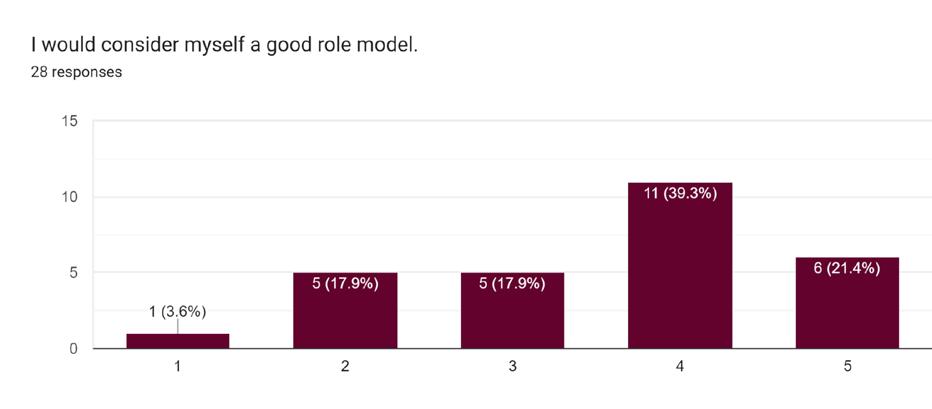
Additionally, students were asked to identify role models in three areas: their family, the student body in school and the staff body. Students appeared to conform to the literature, with a stronger agreement that family was a source of a role model more than within School. This drifted downwards slightly for the teaching body, but there was noticeable disparity and debate about whether students could identify role models within the student body. Whilst 22 out of 28 students agreed or strongly agreed with the notion of role models within their family, only 15 could do the same with students. Once again, this indicated an area in which students lack confidence or assurance that peers can be positive role models.

Additionally, when asked for their choices of role models and examples, results proved thought-provoking. Many cited a father as a role model, with rare references to mothers. Celebrities, including Christiano Ronaldo, Joe Root, Barack Obama, Bear Grylls and Dwayne Johnson all made appearances. A couple cited peers as well, but in almost all students, parents were mentioned specifically - Bandura’s notions of socialisation and shared characteristics seemed to be somewhat corroborated here, as did a narrowed range of role model examples.
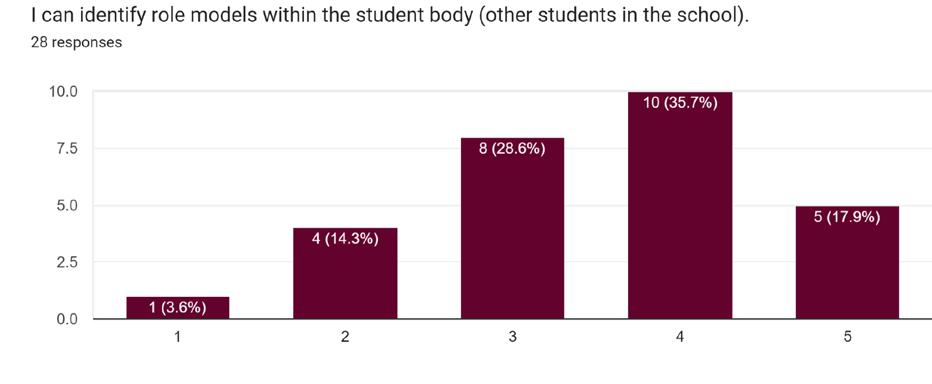
w: ags.bucks.sch.uk 36
To
Year
what extent can
9 students’ perceptions of role models be broadened and challenged within teacher and peer-led Personal Development sessions?
Students were in predominant agreement that role models affected their behaviour, with 75% of students agreeing. When asked to explain why they felt this, students that agreed argued that ‘they can steer me on and off the right path’, ‘my parents definitely have a little bit of an impact on my behaviour as they are the ones I spend most of my time around’ and ‘a role model is someone you want to be like - if your behaviour doesn’t change because of your role model then I doubt they are your model’. This supports the notions of socialisation and learned behaviour discussed within the literature, although it is interesting to see that the students could even initially articulate awareness of this.

Students were then asked to identify characteristics of role models, by choosing their top five attributes. The selection of ten was largely taken from research, and students ranked them from 1st being their most important to 5th being their 5th most important - therefore leaving five characteristics remaining and less or unimportant in their view. These were then, for the purpose of analysis, weighted with point value (5 points for 1st, 4 for 2nd, 3 for 3rd, 2 for 4th and 1 for 5th), therefore creating the totals listed in the right hand column of the table (below).
This established that students tended to pick more holistic qualities, such as ‘dedicated’ and ‘responsible’ over the qualities the literature suggested might drive role models such as ‘sporty/athletic’ and the importance of gender. While this is encouraging, indicating that our students are conscious of what attributes they might seek in a role model, it was interesting to see disparity in their choices, as qualities more associated with ‘real men’ still seemed to factor into some students’ choices.
The survey culminated with students defining in their own words a ‘role model’. These definitions would be referred back to throughout the Personal Development sessions, but below are some examples:
A role model…
• will be willing to help anyone and everyone for a good cause
• is someone who shows responsibility and confidence.
• must lead by example
• always is empathetic and thoughtful of other people no matter their background
• is someone that makes sacrifices and is inspirational
• is someone whose ethics and morals I use and someone who I look up to
• is someone who motivates and makes people feel better than before
These results all indicated some areas of divergence from the literature, as students appeared to have some clear understanding of the importance and impact of role models, but did provide some areas in which Personal Development discussions were still likely to have impact.
37 Flagship: Journal for Evidence Engaged Practice
Choice of characteristic 1st 2nd 3rd 4th 5th Total Dedicated 8 9 7 2 1 102 Inspirational 11 7 1 2 3 82 Responsible 5 5 6 2 3 70 Trustworthy 3 7 4 4 7 70 Confident 2 2 4 7 5 49 Makes sacrifices for others 1 1 4 7 3 38 Funny 2 1 3 3 3 32 Sporty/athletic 0 2 1 1 3 17 Sensitive 0 0 2 2 3 13 Gender (male/female) 0 0 1 1 5 10
WHAT HAPPENED IN THE SESSIONS?
Week 1: The results were presented to the class, and discussed with the students. Students were excited and interested to see the results of the surveys, and observe some of the trends previously mentioned. In particular, there was a discussion around the choices of role models, with some students willing to embellish their choices and explain further. We also dissected the importance of parental role models, and began to unpick why fathers were chosen more frequently than mothers.
Week 2: The Tutor Group Prefects led a discussion in which they talked about their role models. This highlighted a broad range of ideas beyond those cited in the initial survey, and in particular the idea of role models for learning and school. Students were then encouraged in smaller groups to identify role models within school (e.g. prefects, teachers, peers) that could help them achieve and aspire to their goals.
Week 3: Students read an article from ‘Being Mankind’, a book I had sourced for free from the organisation of the same name, who work around masculinity. This article discussed a man called Scott Meenagh and his experiences of role models.
Week 4: We discussed the article read in the previous week, dissecting the key messages and ideas. This prompted a discussion around whether the students felt he was a positive role model, and what students felt were the key ideas and takeaways they could apply to their thinking and aspirations.
Week 5: Tutor Group Prefects led another session discussing one another, and what qualities they felt the other possessed that made them good role models. This was really powerful, and students were engaged and intrigued by the idea of exploring a peer’s qualities and attributes in this supportive space.
Week 6: Students finished the series of sessions by tackling the question ‘Are YOU a good role model?’. Students worked in pairs, identifying initially some characteristics of themselves, and then initially without discussing their partner. We then finished by students sharing with one another the qualities they felt each other possessed that made them good role models, much like the Prefects had done in the previous week. Students revelled in the chance to talk to their partners in this way, and this prompted some lovely discussions.
w: ags.bucks.sch.uk 38
To what extent can Year 9 students’ perceptions of role models be broadened and challenged within teacher and peer-led Personal Development sessions?
It was clear from these discussions that students were influenced by role models from a variety of sources and experiences, so it was good to see so many of them willing and ready to share these ideas with their peers in smaller group discussions.
The success of the sessions would lie both in the extent to which it had broadened ideas and increased confidence in the students around role models, but also in the engagement with the sessions themselves.
There was a noticeable shift in perception of themselves as role models, both personally and the extent to which they thought others would view them similarly. Interestingly, the extent to which there was little discrepancy in these results from one another indicates that students felt more confident that they may be projecting outwardly the qualities of a good role model - this might be explained by the way students engaged with the sessions in Week five and six particularly. Building upon that, 85.7% of students agreed that role models affect their own behaviour, seeing an increase of just over 10% in students agreeing. While this only equates to a couple of students, the discussions we had in sessions around attitudes, values and behaviours appears to have had some effect here on students being more conscious of how role models might impact them.


Students were also asked for general feedback on the impact and enjoyment of the sessions by being asked to state the extent of agreement with the statements in the table below (Likert Scale or 1 being strongly disagree to 5 being strongly agree). Pleasingly, the feedback was overall very positive, both on their enjoyment of the sessions and the impact they felt it had had. It was clear, based upon this feedback, that the sessions succeeded in broadening ideas of role models, and challenging some students’ initial definitions of role models. It was most reassuring to see that an overwhelming majority of students felt more confident that they would make good role models in the future - this was a key objective of the research, so it was great to see that students felt such a change overall.

39 Flagship: Journal for Evidence Engaged Practice FINAL SURVEY
Statement Total agreed or strongly agreed (4 or 5) % I enjoyed the sessions on role models we did in Personal Development. 24 86 Other students in the school would benefit from these sessions. 24 86 The course expanded my understanding and ideas of what a good role model should or could be. 23 82 Role models can now be defined more broadly for me. 25 89 I feel more confident that I would make a good role model now or in the future. 26 93
When asked to expand further on what they enjoyed about the sessions, students elaborated further on key aspects, including these below:
“I liked the fact we got to know more about the prefects and their role models”
“The group discussions were useful”
“It was interesting to see the results of the survey”

“Me and my partner were able to say lots of nice things about each other”
This provided some key takeaways. Students clearly appreciated the chance to express their opinions and enjoyed the fact that they could see the results of the surveys throughout. It also seemed that these topics were a good focus for Personal Development, as they enjoyed the opportunity to discuss ideas in a safe space, and found the exercise of sharing ideas with their peers helpful.
To what extent can Year 9 students’ perceptions of role models be broadened and challenged within teacher and peer-led Personal Development sessions?
One important area educators can have real impact is in supporting and enabling students to consider how their behaviour, attitudes and aspirations can be influenced by others.
CONCLUSIONS
It was clear that students’ views on role models diverged from the literature occasionally, although their initial responses did indicate areas that conformed with the existing research. This indicated a clear area of benefit from the Personal Development sessions, so it was pleasing to see that students responded well to the unit, and felt they had gained a great deal from it, both in knowledge and in confidence.
As their form tutor, these sessions were among the most successful Personal Development sessions across the year in terms of student engagement, as they were interested to see their voice represented and felt that they were able to discuss their ideas freely. It was clear from these discussions that students were influenced by role models from a variety of sources and experiences, so it was good to see so many of them willing and ready to share these ideas with their peers in smaller group discussions. By the end of the sessions, the exercise of identifying characteristics of positive role models within their partner felt like a real full circle moment, and demonstrated the progress they had made over the series of sessions, with students willing to express praise to each other. One area in which Personal Development sessions proved challenging was time - often discussions could have extended beyond the time allowed in registration, although this perhaps is more encouraging in the fact that students were keen to engage with the sessions.
Our role as teachers, therefore, is interesting and one worth considering. Teachers rarely were identified directly in named examples, although there was acknowledgement that students could identify role models within the staff body. However, what role should teachers play? Do they need to be ‘role models’ for students? This research would suggest that one important area educators can have real impact is in supporting and enabling students to consider how their behaviour, attitudes and aspirations can be influenced by others, be those role models or other individuals. Personal Development discussions, in the context of Aylesbury Grammar School, provides a logical and supportive environment for this to take place, with teachers encouraging open discussions around the subject, and challenging narrowed ideas of role models.
In particular, NPRM usage appeared to have great impact also, with the sessions run primarily by Tutor Group Prefects noted as useful, both as a chance to build relationships
between them and the students, but also in ‘role modelling’ the discussions that students could be having. Peer-led sessions and discussions were one of the clearest methods students identified as enjoyable and useful in these sessions, creating space for student voice to lead and for opinions to be voiced freely.
Although I did not collect data for specific sessions, in terms of enjoyment and engagement, in evaluating the success of the sessions, the students engaged particularly well with the ‘Being Mankind’ extract. Students had a whole session to read and develop ideas over a week, so the preparation may have explained their engagement and detail of their contributions, but the case study approach did prove useful in highlighting key ideas and messages students could take away and apply.
Overall, the sessions succeeded in the aims and objectives, as they were able to establish existing ideas of role models, challenge these through discussions in a safe and supportive environment, and students felt more confident and positive about their aspirations as role models as a result. It also highlighted that teachers and educators can contribute to this process by highlighting the importance of studying about role models, encouraging students to find positive role models, and offering a framework for discussion about values, attitudes and responsibilities. In terms of what can be learnt for the future, and some further questions that might be explored, there are some areas for consideration:
- These sessions could be expanded across other tutor groups (e.g. Year 9 as a whole) to see whether there is positive impact across groups
- Explore further ways for student voice to drive discussions in Personal Development sessions
- Whilst not an immediate focus of my research project, due to its more narrowed scope, it also seems that masculinity and its relationship to role models could be explored further in the future. Work on this is already happening at Aylesbury Grammar School, so it would be interesting to explore this relationship further in research.
41 Flagship: Journal for Evidence Engaged Practice
REFERENCES
Beatty, C. and Tillapaugh, D., 2017. Masculinity, Leadership, and Liberatory Pedagogy: Supporting Men Through Leadership Development and Education. New Directions for Student Leadership, 2017(154), pp.47-58.
Bricheno, P. and Thornton, M., 2007. Role model, hero or champion? Children’s views concerning role models. Educational Research, 49(4), pp.383-396.
Byrde, J. ed., 2016. Being Mankind - Volume 1. 1st ed. London: Super Being Labs, pp.14-18.
Carrington, B. and Skelton, C., 2003. Re-thinking ‘role models’: equal opportunities in teacher recruitment in England and Wales. Journal of Education Policy, 18(3), pp.253-265.
Carrington, B., Tymms, P. and Merrell, C., 2008. Role models, school improvement and the ‘gender gap’—do men bring out the best in boys and women the best in girls?1. British Educational Research Journal, 34(3), pp.315-327.
Cushman, P., 2008. So what exactly do you want? What principals mean when they say ‘male role model’. Gender and Education, 20(2), pp.123-136.
Fleming, S., Hardman, A., Jones, C. and Sheridan, H., 2005. ‘Role models’ among elite young male rugby league players in Britain. European Physical Education Review, 11(1), pp.51-70.
Francis, B., 2000. Boys Girls and Achievement. 1st ed. New York: Routledge.
Hurst, B. 2018. Boys won’t be boys. Boys will be what we teach them to be. [Video]. TED. https://www.ted.com/talks/ben_hurst_boys_won_t_be_boys_ boys_will_be_what_we_teach_them_to_be?language=en
Lockwood, P., Jordan, C. and Kunda, Z., 2002. Motivation by positive or negative role models: Regulatory focus determines who will best inspire us. Journal of Personality and Social Psychology, 83(4), pp.854-864.
Lucey, H 2001, Social class, gender and schooling. in B Francis & C Skelton (eds), Investigating Gender: Contemporary Perspectives in Education. Open University Press, Milton Keynes, pp. 177-188.
Murphey, T. l998.. Motivating with near peer role models.In B. Visgatis (Ed.) JALT 97 Conference Proceedings: Trends and Transitions, pp. 205-209.
Odih, P., 2002. Mentors and Role Models: Masculinity and the educational ‘underachievement’ of young Afro-Caribbean males. Race Ethnicity and Education, 5(1), pp.91-105.
Porter, T., 2018.. A Call to Men. TED Talk Retrieved 18 July 2022, from https://www.ted.com/talks/tony_porter_a_call_to_men
Reiner, A., 2021. Better boys, better men: The new masculinity that creates greater courage and emotional resiliency. New York, NY, USA: HarperOne. Socialstudies.org. 2022. Role Models for Youth: A Survey and Unit of Study. [online] Available at: <http://www.socialstudies.org/sites/default/files/ publications/yl/1301/130105.html> [Accessed 18 July 2022].
Stephens, K., 2004. Parents are Powerful Role Models for Children. Parenting Exchange, [online] (19), pp.1-2. Available at: <https://www.childcareexchange. com/library_pe/5231004.pdf> [Accessed 18 July 2022].
Wiese, B. S. and Freund, A. M, 2011. Parents as role models: Parental behaviour affects adolescents’ plans for work involvement. International Journal of Behavioural Development, 35(3), pp. 218–224.
w: ags.bucks.sch.uk 42
To what extent can Year 9 students’ perceptions of role
and
within teacher and peer-led Personal Development
models be broadened
challenged
sessions?
The impact of a change to a more

ABSTRACT
In the school year 2020-21, the Classics department at Aylesbury Grammar School introduced a new course book for Key Stage 3 Latin, partly motivated by the desire to give a more accurate reflection of the ethnic diversity in the Roman Empire. The new course, Suburani (book 1, first twelve chapters), teaches Latin and Roman culture via the means of stories and cartoons concerning the lives of a group of people most of whom share a tenement block in the low-income Subura district of Rome, starting in AD64, with flashbacks to Britain at the time of the Boudiccan revolt. This replaced the Cambridge Latin Course Book 1 (4th edition), a story-based scheme originating in the 1970s centring round the life of a comparatively wealthy and apparently white family in Pompeii, starting in AD79. The impact of this on student perceptions of Black, Asian and minority ethnic (BAME) people in the Roman World was monitored in my 2021 research (Gruar, 2021), which I have continued this year, both to capture the data from a full two years of teaching to support more meaningful comparisons, and to build on previous findings by considering the impact that can be made by teachers.
43 Flagship: Journal for Evidence Engaged Practice
diverse ks3
Latin course book in student perceptions of BAME people in the Roman world, and how to optimise this: an update.
Alex Gruar Teacher of Classics
CONTEXT
Despite a plethora of evidence for ethnic diversity in the Roman Empire, meriting the description of the citizen body as “the most ethnically diverse there ever was before the modern world” (Beard, 2015), popular views of Classics continue to be problematically and inaccurately white. Most recently, the artificially white impression of the ancient world has been the subject of a BBC Radio 4 programme (Detoxifying the Classics, 2022). It is therefore worth reiterating that ancestral DNA analysis (Antonio et al., 2019) of 48 imperial era individuals in Rome typified this period as one of “Substantial ancestry shift towards the Eastern Mediterranean and the Near East. Highly variable ancestry across individuals”. The other main setting for the Suburani course, Roman Britain, is subject to similar diversity, as documented by Olusoga (2016):
The mobility that was a feature of the late Roman Empire may well have meant that parts of 3rd-century Eburacum may well have been more ethnically and racially diverse than parts of York today in the 21st century.
Citing both the Ivory Bangle Lady, whose grave goods and expensive burial testify to a high status and regard within the community of Roman York, and the unit of Aurelianic Moors stationed at Aballava on Hadrian’s Wall, Olusoga presents a province where BAME people were to be found across the socioeconomic classes. The situation is effectively summed up by Elmer, quoted in The Guardian (Weale, 2022):
We’ve tended to take an all-white view of an empire that clearly wasn’t. If you’re a person of colour, it’s natural to wonder whether people like you were even there. It’s a catastrophic failure of our subject and needs to be rectified.
The literature concerning the importance of creating an inclusive Classics classroom, the role of the textbook within this and the criticisms of older course books such as the Cambridge Latin Course (4th edition) in creating an artificially white impression of antiquity, were explored in depth in my previous literature review (Gruar, 2021). The issue is still topical, with the issue of Classics textbook reform, specifically the revision of the Cambridge Latin Course for the forthcoming 5th edition “to include more
prominent female characters and better reflect the empire’s ethnic mix”, attracting the attention of The Guardian (Weale, 2022). However, it is worth recapping the question of how textbooks influence learner perceptions of the wider world and how teachers may influence this. Sleeter and Grant (1991) argue that the ways in which textbooks create and project symbolic representations of society are hidden and not explicit to the viewer: symbolic representations in the curriculum represent socially constructed relations as natural; subjective interpretations of reality and value judgements are presented as fact.
In the case of the school-age learner of Classics, who may not encounter many contrasting views of the subject in their home life, it is particularly incumbent on the teacher to provide alternative perspectives. This is explored by Sawyer in “Latin for all Identities” (2016), who places the burden on teachers of redressing the balance with more diverse images in their own examples, and of using the faults in the textbook as “teachable moments”. She uses the Cambridge Latin Course (4th edition) as her main example of an unrepresentative course, referring to the inactivity of the female characters, and the failure of the second book to fairly replicate in its choice of characters the diversity that it discusses in Roman Alexandria.
w: ags.bucks.sch.uk 44
The impact of a change to a more diverse KS3 Latin course book in student perceptions of BAME people in the Roman world, and how to optimise this: an update.
METHODOLOGY
The term “BAME” was kept throughout despite the problematic way in which it implies that the experience of all non-white people is parallel, owing to the difficulty of mapping more precise modern ethnic groups onto the Roman population and, in particular, to the depictions in books. The term BAME would also enable us to sidestep the ongoing debate between Afrocentrist scholars who claim these peoples as Black, and those such as Snowden (1997) who use artistic depictions and Roman descriptions to argue that they were not. More practically, by limiting the focus only to those characters depicted as Black, we would lose the impact on our students of other aspects of ethnic diversity (such as a range of skin tones, or a character identified as Syrian). Finally, there was no strong reason to hypothesise at the beginning of this study that Black students were at greater risk of perceiving themselves excluded from a traditional Latin course than other minority ethnic groups, and owing to the voluntary nature of participation in the process there was a higher likelihood of gaining meaningful data if it were collected for BAME students as a whole. Opportunities were provided to self-identify with more specific ethnicities, however.
Quantifiable data was collected via a Google Forms questionnaire during the second half of the spring term. This was sent to all of my classes and some of my colleagues’ in 2021. In the first year, this was kept brief to encourage high rates of participation and featured three Likert Scale questions: how many BAME people the student thought there were in Roman society, how many there were in their book, and how positively or negatively they were presented. To check the reliability of their answers, they were also asked if they could name any of the BAME characters in the book. All names that could be recognised were included regardless of variant spellings (“Lulia” instead of “Iulia”, for example): only names that could not be securely identified were excluded from results. To mitigate the impact of remote teaching on their recall, I used a pair of Kahoot quizzes the week prior to the survey, made as closely parallel as possible, asking students to match the names to the eleven characters displayed. Each of the responses on the Likert scales was assigned a number (for instance 1 for “very positively” to 5 for “very negatively”) so that an average score could be found for each year group’s answers to each question. This enabled scores for Years 8 and 9 to be compared. Where a student submitted more than
one reply, the second was taken as their definitive answer and the first discarded. Full tables with the numerical values and the averages are included in the appendix. In the second year, the questionnaire was repeated at the same time of year and extended to both full year groups. Additional questions were asked to establish whether students were aware of any BAME individuals in Roman history, with a free text option for naming these, and a multiple choice follow-up question asking where they had found out about them. The Kahoot quizzes to assist with name recall were not required to be used, as there had been no lockdowns that year and teachers had been reinforcing the names of characters during regular face-to-face teaching. The second phase of the information gathering used focus groups to deepen the understanding of the impact on students of how the textbooks presented ethnic minorities. A question was included on the survey asking whether students would be willing to participate in this, and those who replied “yes” or “maybe” were contacted via email with further details. Initially in 2021, these were scheduled for lunchtimes on return to school, late in the spring term. As turnout was too low to be viable, these were rescheduled with the assistance of form tutors for extended registrations in May and this timing was repeated in the second year for comparability. The sessions were necessarily short and question prompts focused on whether the depictions were felt to be realistic, whether this mattered to the students, and what, if anything, could be done to improve. As the focus groups were selfselecting, it was not possible to balance the representation of ethnic groups. With students’ consent, extracts from these transcripts have been quoted in a “cleaned” form, with the removal of conversational fillers such as “like”.
45 Flagship: Journal for Evidence Engaged Practice
TEACHER INTERVENTIONS IN THE SECOND YEAR
Practical considerations dictated that interventions had to fulfil certain criteria to be useful. As Year 8 and 9 have a single one-hour lesson of Latin per week and language acquisition and retention benefits from regular practice, taking a whole lesson to digress would have had a negative impact on our other objectives. Moreover, the Suburani course has a complex plot with multiple characters having their own arcs, in addition to paralinguistic topics related to this storyline (such as chariot racing, baths and water supply or the Great Fire of Rome). Resources had to be practical for all teachers delivering the course (both members of the department and an additional non-subject specialist in Year 8, along with a trainee teaching one of the classes for part of the time). It was decided unnecessary to keep a control group (given the data from the previous year) as well as unethical (in limiting the access to beneficial interventions) and impractical (as resources and good practice are routinely shared). Therefore interventions to improve awareness were necessarily brief and ideally used existing resources that integrated into the sequence of learning.
Various strategies and resources were shared between teachers, either by including them into the scheme of learning or by informal sharing of best practice. All three teachers were aware of the previous year’s findings, including the mismatch in student perceptions between BAME people in the coursebook and those in real life. Our
commitment to addressing this led to minor improvements in teacher talk, such as frequently referring to the character of Gisco, when he appeared, as a “Numidian cavalryman”, and checking students’ understanding of this point. In addition, we used the map of the Roman empire in the Suburani coursebook as a reference point, eliciting from students that parts of both Asia and Africa were included in Roman imperial territories at the time at which the book was set. Year 8 were shown a brief and accessible video explaining the results of the Stanford University DNA study of the Roman population, either in class or as part of their homework. They were also given a brief, lowstakes, multiple-choice Google Forms quiz in which they were asked to identify where eight individuals from Roman history had come from, with an incentive for finding out (a merit for full marks) and permission to “cheat” or search for the answers online. This was deliberately not presented as focused on ethnicity: although several of the people mentioned were from Africa or Asia (e.g. Augustine, Galen, Septimius Severus), this was not singled out. The individuals chosen were varied in sex, sexuality and the fields to which they had contributed (including religion, medicine and mathematics). In the room used by some groups, a display board entitled “Decolonising Classics” was also put up by the trainee teacher, with images and text evidencing ethnic diversity both in antiquity and in the reception of Classics.
w: ags.bucks.sch.uk 46 The impact of a change to a more diverse KS3 Latin course book in student perceptions of BAME people in the Roman world, and how to optimise this: an update.
We’ve tended to take an all-white view of an empire that clearly wasn’t. If you’re a person of colour, it’s natural to wonder whether people like you were even there. It’s a catastrophic failure of our subject and needs to be rectified.
FINDINGS: SURVEYS
When students were asked whether there were any BAME characters in their Latin coursebook, all years who had used Suburani responded more positively than the 2020-21 Year 9 group who were still using the Cambridge Latin Course: the median student in that group thought there were none, whereas the median in all Suburani groups perceived one. The greatest awareness came from the 2022 Year 8, of whom under 25% thought there were none. There was also a small reduction in those who perceived none between the 2020-21 Year 8 and the same group questioned again a year later, but this was paired with a reduction in those who thought there were more than one. This can be accounted for by the comparatively frequent appearances in both stories and pictures of the character of Gisco, a cavalryman from North Africa, in chapters 7-12, read that year, but the disappearance of Julia after chapter 3. This appears to be confirmed by the numbers who named him as a BAME character they remembered: 7% of respondents in 2020-21 Year 8, rising to 37% in 2021-22 Year 9. The 2021-22 Year 8 were also slightly more likely (at 12%) to name Gisco than their predecessors, perhaps due to increased teacher references to his origins. One teacher observed a class beginning to self-correct when a student was unaware of Gisco’s origins, suggesting that this knowledge had become embedded.
be attributed to the heroic, if not entirely uncomplicated, role that Gisco plays in the plotline of chapters 6-12.
If you answered yes, how do you think BAME characters are portrayed in the book?
As expected, the clearest evidence of teacher impact was in the awareness of BAME people not in the plot, but in the real Roman world. The change in book had made some difference, as can be seen in the comparison of the two sets of 2020-21 results: the median opinion in the Cambridge Latin Course group was that only a small minority of the population were BAME, compared with a minority in the Suburani group. This group continued to progress in their perception of the prevalence of minorities as they moved into Year 9. The subsequent Year 8 is the group that was the most likely so far to express a belief that BAME people constituted at least half of the population. This is consistent with the information provided in the Stanford DNA data, as presented to them in the video, yet further problematises the use of the term “BAME”, which becomes contradictory when used to apply to a majority of the population. Few students from either group were aware of BAME individuals in Roman history, however: 10% from Year 8 and 14% from Year 9. The most frequently mentioned name was Septimius Severus (from seven individuals). Very few students were able to identify where such knowledge had come from. This should come as little surprise: the Suburani course features only one historical figure (the emperor Nero) and only passing references to others in background materials.
Student impressions of how BAME people were depicted in Suburani were also less negative than in the Cambridge Latin Course. Almost a quarter of the cohort using the legacy course considered that ethnic minorities were shown negatively or very negatively, an understandable conclusion given the figure of Syphax, the slave-dealer. The comparable figure was less than 10% for all other groups, in each of which the most popular opinion was that they were shown neutrally, with the positives outnumbering the negatives in each case. There was a slight increase in positive responses from the 2020-21 Year 8s as they entered Year 9, which might
How many Black, Asian or minority ethnic (BAME) people do you think were there in Roman society?
47 Flagship: Journal for Evidence Engaged Practice
Year Group 0% 25% 50% 75% 100% 1: 2021 Year 9 (legacy course) 2: 2021 Year 8 3: 2022 Year 9 4: 2022 Year 8 3: none 2: yes, one 1: yes, more than one 0: no response
Are there any BAME characters in your Latin course book? This question refers to your Suburani textbook/Activebook.
Year Group 0% 25% 50% 75% 100% 1: 2021 Year 9 (legacy course) 2: 2021 Year 8 3: 2022 Year 9 4: 2022 Year 8 5: very negatively 4: negatively 3: neither positively nor negatively 2: positively 1: very positively 0: no response
Year Group 0% 25% 50% 75% 100% 1: 2021 Year 9 (legacy course) 2: 2021 Year 8 3: 2022 Year 9 4: 2022 Year 8 5: none 4: a small minority 3: a minority 2: about half 1: a majority
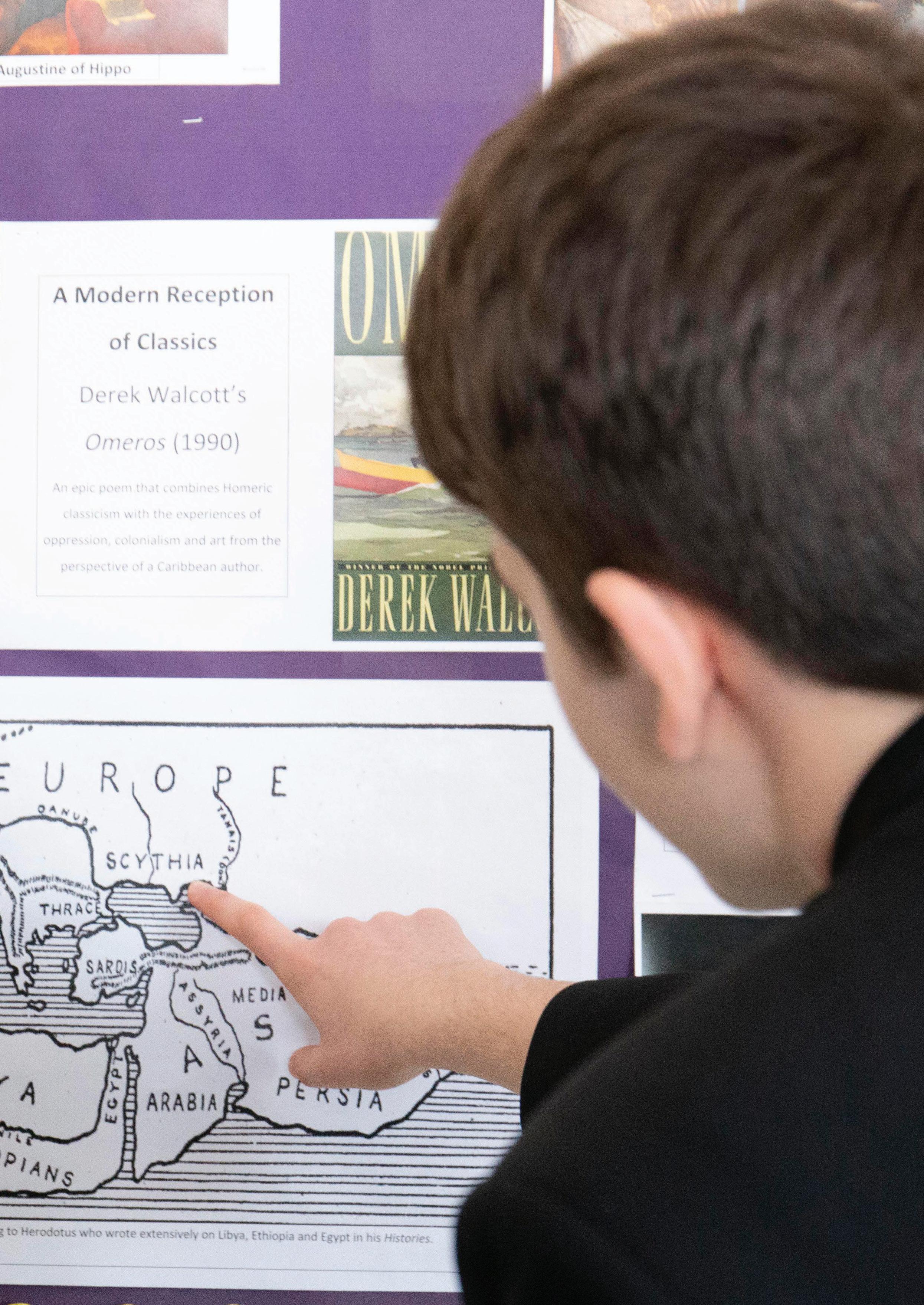
FINDINGS: FOCUS GROUPS
Students this year echoed the sentiments of those last year in valuing diversity of representation, but regarding it as tangential to the objectives of the subject, which they identified as primarily language acquisition:
I think that it matters a bit about showing how diverse the Roman Empire was and that [it] wasn’t only one race of people, but when it comes to learning about Latin itself, it doesn’t really affect it, or make much of a difference.
2022 Year 8 student C
it’s nice to see people of different ethnicities in the materials, but even if not, it’s not going to be a deal-breaker that I won’t use the book
2022 Year 9
There was, however, a movement away from the belief that the inclusion of ethnic minorities was an inaccurate intervention on the part of the modern creators of the resources. The same student who in 2021 had suggested that “there should be some sort of disclaimer somewhere which says that it’s not exactly how Roman times would have been” returned in 2022 with the following:
I remember last year when I did this, I didn’t think that it showed it accurately, but now that I’ve been more used to the book I think it does because the Roman Empire is in the middle of Europe and that means you get all these ethnicities from all the other sides coming in to it and obviously since it was such a big empire, lots of people would want to be in it if they could. So I think that it does show it accurately.
2022 Year 9 student E
Although his statement suggests a rosier view of migration than the conquest and enslavement familiar to those who have studied Roman imperialism in more depth, he is clearly aware that the geography of the empire itself is linked to a diverse population and attributes this awareness to his learning in the past year.
Other Year 9 students this year also appeared to evaluate the accuracy of the depictions in the book by comparing with other sources, most frequently the map:
I think that it’s so that it does show it quite accurately because you don’t see that many of the Asian minority because the Roman empire doesn’t expand into Asia so it’s more into North Africa, that’s why you see more Black people in the Suburani book.
2022 Year 9 student C
This led one student to consider that the book underrepresented those from Africa, in clear contrast with the view expressed the previous year, that the book overrepresented minorities:
I think it shows it mostly accurately but there should be maybe occasionally some people of different skin colours or ethnicities, as wasn’t the Roman province in Africa, did they, did any people like come from that?
2022 Year 9 Student D
49 Flagship: Journal for Evidence Engaged Practice
Thus it appears that the use of maps and consideration of the extent of the Roman Empire led to a greater understanding of this topic.
Year 8 students this year generally appeared more accepting of the image presented by Suburani. In justifying their opinions, they were inclined to refer to the presentation of diverse ethnicities in the book as inherently plausible:
I don’t really know exactly what the Roman world was like and what the cultures were, but I assume from the wide variety of different races in the book that there is, is quite accurate.
2022 Year 8 student A
I think that it’s quite diverse because the Suburani book gives a wide range of different races in it and sometimes where they come from, as it shows some people from Rome, some people from Africa, and some people from even part of Europe in it as well.
2022 Year 8 student C
Nevertheless, this cohort did also show the impact of teacher talk on their awareness:
from the book, it seems like there’s a lot of different races, and it kind of shows how diverse it is and it’s kind of backed up with what … the teacher says in class.
2022 Year 8 student B
This underlines the evidence from the survey results in suggesting that, particularly with younger classes, the choice of coursebook sets the parameters for what is likely to be believed as accurate.
When asked for suggested improvements, students were keen to see both the impact and experiences of migrant groups. Some linked this to the background topics in the book, such as the building of the baths:
I think that maybe after we finish a chapter, we could go in depth on, how the thing was made and how people were affected by it, like if we’ve learnt about Roman baths, we could learn maybe, who made it…
2022 Year 8 student C
They also saw the possibility for using the plotline and characters as a hook:
when the chapter’s finished, I think there should be almost a contents of people, so a list of every person, a picture of them, and then where they’re from and how they got here or just what they do for a living and stuff like that to give us an idea of the different, how the different races were treated differently or what they did.
2022 Year 8 student A
This contrasted slightly with suggestions from last year, where there was interest in trade and distinctive cultural features (such as the naming of children) but this was presented more as an additional lesson rather than a clarification or extension of the existing materials. In part, this might reflect that some of those extra demands have now been met, such as the request for “showing different parts of the empire”, but it may also have shown greater awareness that this was an integral part of what was being studied.
w: ags.bucks.sch.uk 50 The impact of a change to a more diverse KS3 Latin course book in student perceptions of BAME people in the Roman world, and how to optimise this: an update.
CONCLUSIONS
This year’s findings confirm last year’s conclusion that a textbook with diverse representations is a necessary yet not sufficient condition for establishing an inclusive classroom and accurate perception of diversity in the context being studied. Some pupils, particularly those in younger classes, will have implicit trust in the core materials presented to them and their vision of reality can be restricted by the images that are most frequently seen. Others, however, look to us to provide corroborating evidence that reflects the authentic experiences of minorities within the Roman Empire and the ways in which they interact with the wider world. We are also able to go further, in stating that regular, brief, low-level and varied teacher interventions can have a meaningful impact on student perceptions, even if individual learners do not always consciously recall these instances.

From the book, it seems like there’s a lot of different races, and it kind of shows how diverse it is and it’s kind of backed up with what … the teacher says in class.
REFERENCES
Detoxifying the Classics, 2022. [Radio programme] Radio 4: BBC.
Margaret L. Antonio, Ziyue Gao, Hannah M. Moots, Michaela Lucci, Francesca Candilio, Susanna Sawyer, Victoria Oberreiter, Diego Calderon, Katharina Devitofranceschi, Rachael C. Aikens, Serena Aneli, Fulvio Bartoli, Alessandro Bedini, Olivia Cheronet, Daniel J. Cotter, Daniel M. Fernandes, Gabriella Gasperetti, Renata Grifoni, Alessandro Guidi, Francesco La Pastina, Ersilia Loreti, Daniele Manacorda, Giuseppe Matullo, Simona Morretta, Alessia Nava, Vincenzo Fiocchi Nicolai, Federico Nomi, Carlo Pavolini, Massimo Pentiricci, Philippe Pergola, Marina Piranomonte, Ryan Schmidt, Giandomenico Spinola, Alessandra Sperduti, Mauro Rubini, Luca Bondioli, Alfredo Coppa, Ron Pinhasi, Jonathan K. Pritchard (2019)
Ancient Rome: A genetic crossroads of Europe and the Mediterranean. Science08 Nov 2019 : 708-714
Olusoga, D. (2016) Black and British: A Forgotten History (Macmillan)
Sawyer, B. (2016) Latin for all identities The Journal of Classics Teaching https://www.cambridge.org/core/journals/journal-of-classics-teaching/ article/latin-for-all-identities/ABA26AD3FA0167FA2AEB2AA7C35B3202 accessed 31st May 2021
Sleeter and Grant (1991) Race, Class, Gender and Disability in Current Textbooks in Apple, M, The Politics of the Textbook
The British Museum (2022) Reimagining the Black Curriculum. [video] Available at: https://www.youtube.com/watch?v=wbyE4wC4PcI accessed 13 July 2022
Weale, S., (2022) UK school Latin course overhauled to reflect diversity of Roman world. The Guardian, [online] Available at: https://www.theguardian. com/education/2022/jul/10/uk-school-latin-course-overhauled-to-reflectdiversity-of-roman-world accessed 13 July 2022
BIBLIOGRAPHY
Amos, E. (2020). A case study investigation of student perceptions of women as seen in the Cambridge Latin Course in a selective girls grammar school. Journal of Classics Teaching, 21(42), 5-13.
Ambrose, S.A., Bridges, M.W. , DiPietro, M., Lovett, M.C., Norman, M.K. (2010) Why Do Student Development and Course Climate Matter for Student Learning? How Learning Works: Seven Research-Based Principles for Smart Teaching p153-187
Ball, S., Christensen, J, Duncan, A., Elmer, D. Hackney C.D., Kennedy, R.F., Lloyd, M, Ready J, Scodel R, Solez, K, Verano, R, Zapkin V., Zuckerberg, D. (2018) Scholars Respond to Racist Backlash against Black Achilles, Part 1: Ancient Greek Attitudes toward Africans in Pharos: Doing Justice to the Classics http://pages.vassar.edu/pharos/2018/05/11/scholars-respond-to-racistbacklash-against-black-achilles-part-1-ancient-greek-attitudes-towardafricans/ accessed 24th June 2021
Beard, M. (2015) SPQR: A History of Ancient Rome Bracey, J. (2017), Why Students of Colour Don’t take Classics Eidolon, https:// eidolon.pub/why-students-of-color-dont-take-latin-4ddee3144934. Accessed May 31st 2021
Cambridge Schools Classics Project Blog https://blog.cambridgescp.com/ accessed 23rd June 2021
Cambridge School Classics Project (2020) Black Lives Matter Statement https://www.cambridgescp.com/black-lives-matter-statement-cscp accessed 22nd June 2021
Decolonising SOAS Working Group (2018) Decolonising SOAS Learning and Teaching Toolkit for Programme and Module Convenors May 2018 https:// blogs.soas.ac.uk/decolonisingsoas/files/2018/10/Decolonising-SOASLearning-and-Teaching-Toolkit-AB.pdf accessed 22nd June 2021
Delaney, C., Smith, H., Tims, L., Smith, T., & Griffiths, W. (2021). Keeping the ancient world relevant for modern students with Suburani. Journal of Classics Teaching, 22(43), 64-67. Accessed 31st May 2021
Dugan, K. P. (2019) The ‘Happy Slave’ Narrative and Classics Pedagogy: A Verbal and Visual Analysis of Beginning Greek and Latin Textbooks. New England Classical Journal, 46:1, 62–87.
Edwards, C. (2008) The How of History: Using Old and New Textbooks in the Classroom to Develop Disciplinary Knowledge Teaching History, no. 130, 2008, pp. 39–45.
Gellar-Goad, T. (2015) How learning works in the Greek and Latin classroom, part 7 https://classicalstudies.org/blogs/ted-gellar-goad/how-learningworks-greek-and-latin-classroom-part-7 accessed June 23rd 2021
McIntosh, P., (1989) Unpacking the Invisible Knapsack (https:// nationalseedproject.org/Key-SEED-Texts/white-privilege-unpacking-theinvisible-knapsack) accessed 24th June 2021
Snowden, F.M., (1997) Misconceptions about African Blacks in the Ancient Mediterranean World: Specialists and AfrocentristsArion: A Journal of Humanities and the Classics
Whitmarsh, T., interviewed by Ling, T. (2018) in No, the BBC is not “Blackwashing” Troy: Fall of a City https://www.radiotimes.com/tv/drama/ troy-fall-of-a-city-blackwashing-casting-black-actors-greek-myth/ accessed 23rd June 2021
Whitmarsh, T. (2018) Black Achilles in Aeon https://aeon.co/essays/whenhomer-envisioned-achilles-did-he-see-a-black-man accessed 23rd June 2021
Zuckerberg, D. (2018) Not All Dead White Men: Classics and Misogyny in the Digital Age
w: ags.bucks.sch.uk 52
The impact of a change to a more diverse KS3 Latin course book in student
of BAME
in the
and
to optimise this: an update.
perceptions
people
Roman world,
how
APPENDIX: SURVEY RESULTS
How many Black, Asian or minority ethnic (BAME) people do you think were there in Roman society?
How many Black, Asian or minority ethnic (BAME) people do you think were there in Roman society?
Are there any BAME characters in your Latin course book? This question refers to your Suburani textbook/Activebook.
Are there any BAME characters in your Latin course book? This question refers to your Suburani textbook/Activebook.
53 Flagship: Journal for Evidence Engaged Practice
Year Group 1: a majority 2: about half 3: a minority 4: a small minority 5: none Grand Total 1: 2021 Year 9 (legacy course) 1 6 24 37 11 79 2: 2021 Year 8 5 17 34 44 6 106 3: 2022 Year 9 5 24 26 27 1 83 4: 2022 Year 8 10 34 41 21 2 108 Grand Total 21 81 125 129 20 376
Year Group 1: a majority 2: about half 3: a minority 4: a small minority 5: none Grand Total 1: 2021 Year 9 (legacy course) 1% 8% 30% 47% 14% 100% 2: 2021 Year 8 5% 16% 32% 42% 6% 100% 3: 2022 Year 9 6% 29% 31% 33% 1% 100% 4: 2022 Year 8 9% 31% 38% 19% 2% 100% Grand Total 6% 22% 33% 34% 5% 100%
Year Group 0: no response 1: yes, more than one 2: yes, one 4: a small minority Grand Total 1: 2021 Year 9 (legacy course) 2 14 14 49 79 2: 2021 Year 8 1 38 35 32 106 3: 2022 Year 9 0 28 33 22 83 4: 2022 Year 8 4 41 39 24 108 Grand Total 7 121 121 127 376
Year Group 0: no response 1: yes, more than one 2: yes, one 4: a small minority Grand Total 1: 2021 Year 9 (legacy course) 3% 18% 18% 62% 100% 2: 2021 Year 8 1% 36% 33% 30% 100% 3: 2022 Year 9 0% 34% 40% 27% 100% 4: 2022 Year 8 4% 38% 36% 22% 100% Grand Total 2% 32% 32% 34% 100%
If you answered yes, how do you think BAME characters are portrayed in the book?
positively
positively nor negatively
If you answered yes, how do you think BAME characters are portrayed in the book?
very positively
positively
positively nor negatively
w: ags.bucks.sch.uk 54 The impact of a change to a more diverse KS3 Latin course book in student perceptions of BAME people in the Roman world, and how to optimise this: an update.
Year Group 0: no response 1:
2:
3: neither
4:
5: very negatively Grand Total 1: 2021 Year 9 (legacy course) 38 0 4 19 14 4 79 2: 2021 Year 8 23 5 16 56 5 1 106 3: 2022 Year 9 14 4 21 40 3 1 83 4: 2022 Year 8 21 2 24 55 6 0 108 Grand Total 96 11 65 170 28 6 376
very positively
negatively
Year Group 0: no response 1:
2:
3: neither
4: negatively 5: very negatively Grand Total 1: 2021 Year 9 (legacy course) 48% 0% 5% 24% 18% 5% 100% 2: 2021 Year 8 22% 5% 15% 53% 5% 1% 100% 3: 2022 Year 9 17% 5% 25% 48% 4% 1% 100% 4: 2022 Year 8 19% 2% 22% 51% 6% 100% Grand Total 26% 3% 17% 45% 7% 2% 100% Do you know of any BAME individuals in Roman history? Year Group 0: no response 1: yes 2: no 3: don’t know Grand Total 3: 2022 Year 9 0 12 48 23 83 4: 2022 Year 8 2 11 55 40 108 Grand Total 2 23 103 63 191 Do you know of any BAME individuals in Roman history? Year Group 0: no response 1: yes 2: no 3: don’t know Grand Total 3: 2022 Year 9 14% 58% 28% 100% 4: 2022 Year 8 2% 10% 51% 37% 100% Grand Total 1% 12% 54% 33% 100%
Assessing the effectiveness of an
teaching strategy on students’ understanding of mathematics
Ali Manjengwa Teacher of Mathematics

ABSTRACT
Following the Black Lives Matter movement and the “Rhodes Must Fall” demonstrations in summer 2020, there has been much debate about how inclusive the curriculum is. Several universities in the UK have been putting in place strategies to ‘decolonise’ university education. Schools on the other hand are also looking at ways to make the curriculum inclusive. AGS is no exception: the Maths department has been looking at ways of making the Maths curriculum more inclusive to cater for the diversity in the student body.
This research was initially aimed at identifying, implementing, and evaluating teaching strategies to decolonise the Maths curriculum at AGS. The literature review revealed several ways of decolonising the Maths curriculum and it was impossible to evaluate all of them. Decolonising the curriculum essentially involves looking at what we teach, how we teach and a consideration of the cultural concepts as well as making the subject more inclusive. Research suggests that one of the ways of decolonising the curriculum is to infuse multicultural teaching in learning activities and strategies – an ethnomathematics approach (Yull, 2008). This research is mainly looking at assessing the effect of an ethnomathematics teaching strategy on Year 8 students’ understanding of and attitudes towards Maths. In particular, the research focussed on Year 8 students learning about multiplication through exploring multiplication methods in different cultures and how the cultures influenced the mathematical thinking behind different multiplication strategies. This research concluded that after the ethnomathematics learning, students had a better understanding of multiplication, demonstrated openness to diverse ideas and perspectives from other cultures and could build comparative analysis of what they were learning. The findings of this research were used to formulate a project to be incorporated into the scheme of work.
55 Flagship: Journal for Evidence Engaged Practice
ethnomathematics
HYPOTHESES
• Introducing an ethnomathematics approach will make learning easier and more meaningful.
• Learning multicultural multiplication will give students a broader view of learning mathematics, not just the Eurocentric - a way of decolonising the Maths curriculum.
• Students will be able to celebrate the achievements of more cultures and nationalities other than the European perspective.
• The implementation of the ethnomathematics teaching approach will help students understand multiplication better.
CONTEXT
A central ethos of AGS is to provide a broad and balanced curriculum. This curriculum is continuously being reviewed to meet the ever changing needs of the different cohorts. Founded in 1598, Aylesbury Grammar school has always offered a full and expansive curriculum aimed at ‘inspiring and nurturing young men to explore for themselves who they want to be and find their own place in the world’. To do this, students need exposure to the influences of gender, culture and civilisations in shaping the curriculum.
The student body at AGS has become more diverse in recent years. Currently over 50% of the student body identify as BAME (Black, Asian and Minority Ethnic). To inspire and nurture students from these diverse cultures, the Maths department started looking at ways to decolonise the Maths curriculum. To do this there was need to examine the Maths curriculum by looking at the following aspects:
• challenging the eurocentric view of mathematics
• questioning whether the curriculum is inclusive
• examining the perception that the Maths curriculum is centred on the achievements of ‘dead white men with long beards’
• asking whether we convey, without realising it, the superiority of one culture over others
Introducing an ethnomathematics approach to teaching and learning at key stage 3 was done with some of the key stage 3 classes with the aim of decolonising the Maths curriculum. In addition it helps to develop students’ intellectual, social, emotional, and political learning. The aim is to develop a number of ethnomathematics teaching approaches and incorporate these into the scheme of work. The intention is to make mathematics more relevant and meaningful for students thereby improving the quality of Maths education.
w: ags.bucks.sch.uk 56
Assessing the effectiveness of an ethnomathematics teaching strategy on students’ understanding of mathematics
Aylesbury Grammar school has always offered a full and expansive curriculum aimed at ‘inspiring and nurturing young men to explore for themselves who they want to be and find their own place in the world’. To do this, students need exposure to the influences of gender, culture and civilisations in shaping the curriculum.

RESEARCH QUESTION
Assessing the effectiveness of an ethnomathematics teaching strategy on students’ understanding of multiplication.
RESEARCH DESIGN
The research design of Plomp (2013) was followed. The five phases in Plomp’s model include (1) preliminary investigation phase, (2) design phase, (3) realisation phase, (4) test phase, evaluation and revision, and (5) implementation phase. Using this model, this research was narrowed down to preliminary research, developing and prototyping and finally assessment.
PRELIMINARY RESEARCH
A pilot study was undertaken with a Year 7 class to help identify the potential of carrying out a full project. Year 7 students were asked to do research of different multiplication techniques and report their findings. They were also asked to report on how they see themselves in Maths. The outcomes of the pilot study helped to inform the design of the main research. Data from the preliminary research revealed that students had a very narrow view of learning multiplication. The range of methods they knew were limited to 1 or 2. It also revealed that most students had never been exposed to multicultural multiplication and had no idea that there are alternative methods of multiplication besides the column and grid multiplication. Another fundamental question that came out of the preliminary study was that of the origins of the multiplication methods. Students had never been taught about the origins of the multiplication methods they used. Teaching mathematics without historical references was identified by Anderson (1990) as one of the six pedagogical disasters in Mathematics education. I argue that teaching Mathematics with no historical, cultural, geographical, or political reference is doing a disservice to our students. The pilot study with Year 7 reinforced the need to further trial this ethnomathematics approach with another group in a more focussed manner with a view to develop a series of lessons on multiplication for Year 8 aimed at decolonising the curriculum.
LITERATURE REVIEW
Recent debate on decolonising the curriculum has been focussed on not so much whether it is necessary to decolonise the curriculum, but more about how it can be decolonised. Many researchers suggest different ways of decolonising the curriculum. For Maths there are some arguments against decolonising it but in my view most of these arguments are simply based on a misunderstanding of the need to decolonise. According to Hughes (2021), “Decolonising the curriculum is about being more accurate, more inclusive and more interculturally responsive; it is not about forcing one ideological perspective on students, it’s about telling both sides of the story.” Using ethnomathematics strategies in teaching Maths has been recommended by many researchers as one of the ways by which Maths can be decolonised.
Ethnomathematics essentially is the relationship between Maths and culture. Reston (2001) argues that it is important to restore students’ cultural identity in classrooms. The same author stresses that if students are exposed to multicultural activities that reflect the knowledge and behaviours from diverse cultural environments, then there is a higher chance that they may not only value their learning but also have a greater appreciation of those different from themselves.
w: ags.bucks.sch.uk 58 Assessing the effectiveness of an ethnomathematics teaching strategy on students’ understanding of mathematics
Students need exposure to the influences of gender, culture and civilisations in shaping the curriculum.
METHODOLOGY
The main project involved a Year 8 class of 32 students and was completed over three lessons. To activate and assess prior knowledge, the students were given a worksheet to answer. The worksheet consisted of a few multiplication problems and a few questions about the multiplication process itself. On the multiplication problems students were required to explain the method they used. They were also asked to fill out a questionnaire designed to investigate their knowledge of other multiplication methods and how the methods linked with their culture. The questionnaire also sought to establish students’ knowledge of the history behind the methods they used.
Students were then given a task to do research on the different multiplication methods. The task was as follows:
In this assignment you are going to research different methods of Multiplication across different cultures and explore how culture influences mathematical thinking strategies. You will need to prepare a multimedia presentation to cover the following points:
1. What are different methods of multiplication around the world and how do they work?
2. Provide history on each country’s method.
3. Solve problems demonstrating each country’s method.
4. What do the methods have in common with what you know?
5. What are the advantages and disadvantages to each method?
6. How do you think culture influences these methods?
7. Which method/methods do you prefer and why?
The following methods were investigated:
Ancient Egyptian multiplication method.
Place value multiplication method.
British column multiplication method.
Chinese multiplication method.
Japanese multiplication method.
Russian multiplication method.
Students used PowerPoint presentations to present the findings of their research to demonstrate their understanding of the different ways of multiplication around the world. The following table shows the assessment criteria that was used to mark their presentations:
1. Investigated more than 2 examples of multiplication methods from around the world and how they worked?
2. Presentation includes information, history and examples about how multiplication equations are solved in each culture/country.
3. Solve problems demonstrating each country’s method.
4. Presentation compares one country with the UK in terms of multiplication teaching. Which method/methods do you prefer and why?
5. What are the advantages and disadvantages to each method?
6. How do you think culture influences these methods?
7. Information is included in a creative, detailed slideshow presentation with many presentation features utilised. Each person has a part in the presentation.
8. Credits/ sources shown.
59 Flagship: Journal for Evidence Engaged Practice
Requirements Possible Points Awarded Points Comments
10
15
5
5
5
5
10
60
5 Total
FINDINGS
Data analysis from the first phase revealed that only one out of the 32 students knew an alternative method of multiplication. The student mentioned that they were aware of the Chinese multiplication method but did not know how it worked. None of the students knew anything to do with the history of the multiplication methods or any cultural links to the methods they used. The following are the findings from this research:
1. ENJOYMENT
It was clear from the beginning that students enjoyed the tasks and the presentations. It was something different from the ‘boring’ maths they were used to. A number of researchers have shown that there is a direct correlation between the learning outcomes and the enjoyment of the learning activities (G. Tisza et al., 2021). About 85% of the students gave a very high score rating to the lessons as shown in figure 1.
(NCTM, 1989) advocates for students to be exposed to diversified experiences related to the cultural, historical and scientific evolution of Mathematics. It is important to create mathematical experiences that are related to cultural experiences as these tend to be rich in mathematical experiences (Civil, 2002).
2. STUDENTS EXPLAINING HOW MATHEMATICAL THINKING WAS INFLUENCED BY CULTURE
Most students were able to explore how the different multiplication methods were influenced by culture. This showed some deep learning and it also allowed them to ask further enquiry questions which they would not normally ask when teaching multiplication the traditional way.
Survey question: ‘For the multiplication method you researched, explain the link between culture and their multiplication methods’.
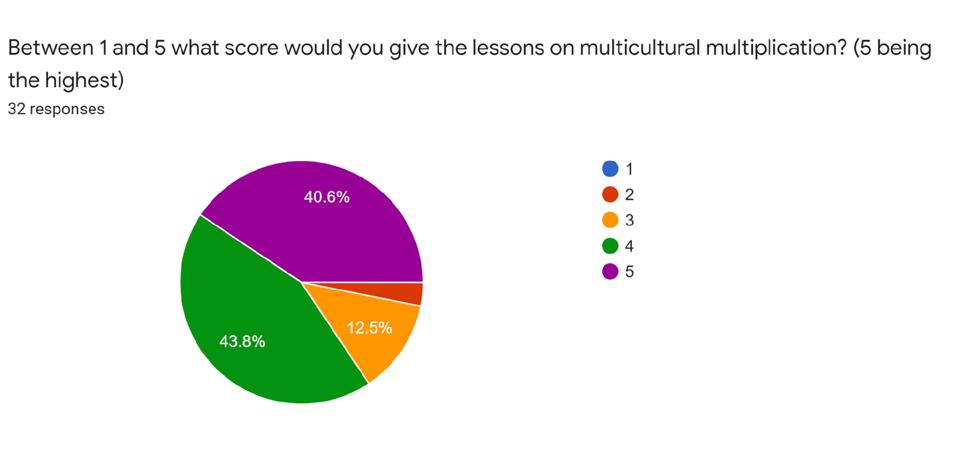
Student answer: ‘The Russian method was mainly used by the Russian peasants who did not know basic multiplication and only knew basic maths and so it only affected them and their culture so it didn’t actually affect the country. Since the rich and those in power used other methods’.
47 percent of the students who asked agreed that they are now more aware of how the multiplication methods they learnt are connected to real life compared to only 3% who disagreed. The National Council of Teachers of Mathematics
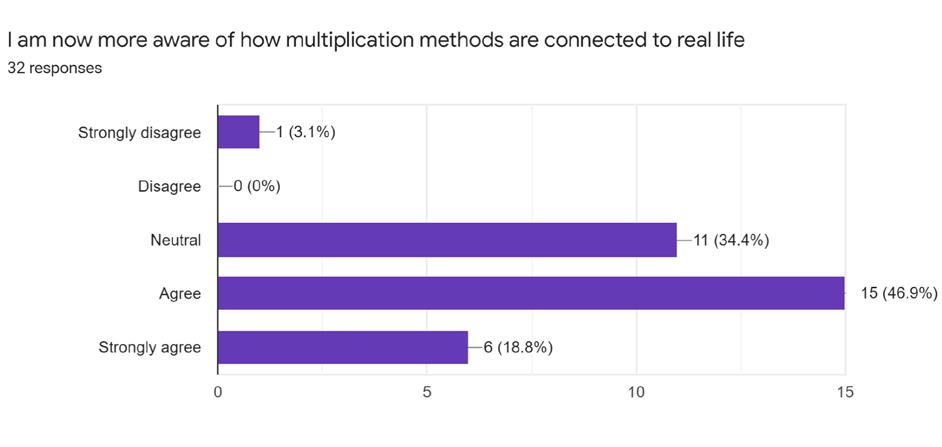
Students could build comparative analysis of what they were learning.
3. BETTER UNDERSTANDING OF THE PROCESSES OF MULTIPLICATION AND DEMONSTRATED OPENNESS TO DIVERSE IDEAS AND PERSPECTIVES FROM OTHER CULTURES.
The findings of this research are that the introduction of an ethnomathematics strategy improved students’ understanding of mathematics and students were able to do a comparative analysis of what they were learning. When comparing cultures, students were able to suspend judgement and look beyond simplistic determinations of “right” and “wrong,” and explain how geography, history and political and economic systems affect, and are affected by, specific cultural practices. This is consistent with the argument by Reston (2001) who asserted that if students are exposed to multicultural activities, they are more likely to value the mathematics learning and also to respect others from diverse cultures. It is therefore important to be introducing ethnomathematics learning and teaching activities.
w: ags.bucks.sch.uk 60 Assessing the effectiveness of an ethnomathematics teaching strategy on students’ understanding of mathematics
REFERENCES
Civil, M. (2002). Culture and mathematics: A community approach. Journal of International Studies, 23(2), 133-148
National Council of Teachers of Mathematics. (1989). Curriculum and Evaluation Standards for School Mathematics. Reston, Virginia : NCTM.
Rosa, M. & Orey, D. C. (2011). Ethnomathematics: the cultural aspects of mathematics. Revista Latinoamericana de Etnomatemática, 4(2). 32-54
Smestad, B. & Nikolantonakis, K. (2010). Historical methods for multiplication. Conference: ESU 6 European Summer University on the History and Epistemology of Mathematics. January 2010. Available at: https://www.researchgate.net/publication/263733700_Historical_methods_ for_multiplication
The Journal of Negro Education Vol. 59, No. 3 (Summer, 1990), pp. 348-359 (12 pages)
Tisza, G. and Markopoulos, P. (2021). Understanding the role of fun in learning to code. International Journal of Child-Computer Interaction, 28, p.100270. doi:10.1016/j.ijcci.2021.100270.
www.nameorg.org. (n.d.). Can I be a multicultural educator in math? - NAME Learn. [online] Available at: https://www.nameorg.org/learn/can_i_be_a_ multicultural_educa.php.
Yull, D. (2008). Ethnomathematics and Journaling in a Multicultural Summer Enrichment Mathematics Class. Research and Teaching in Developmental Education, 25(1), 54–63. http://www.jstor.org/stable/42802321
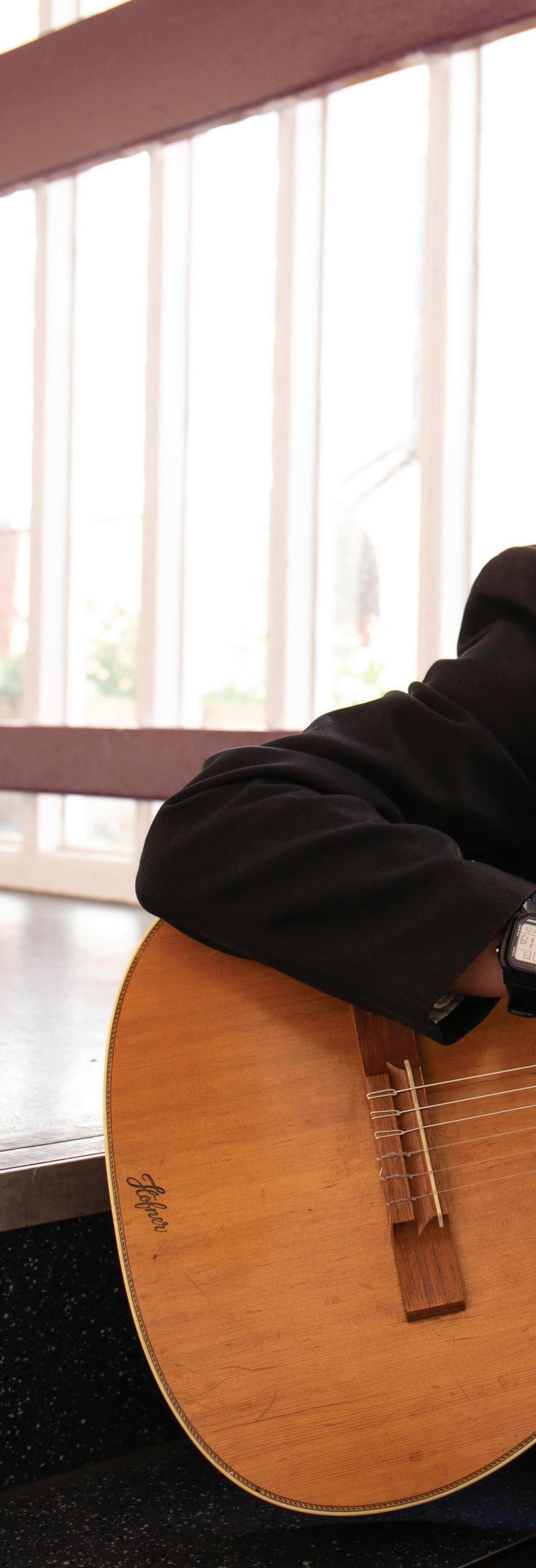
61
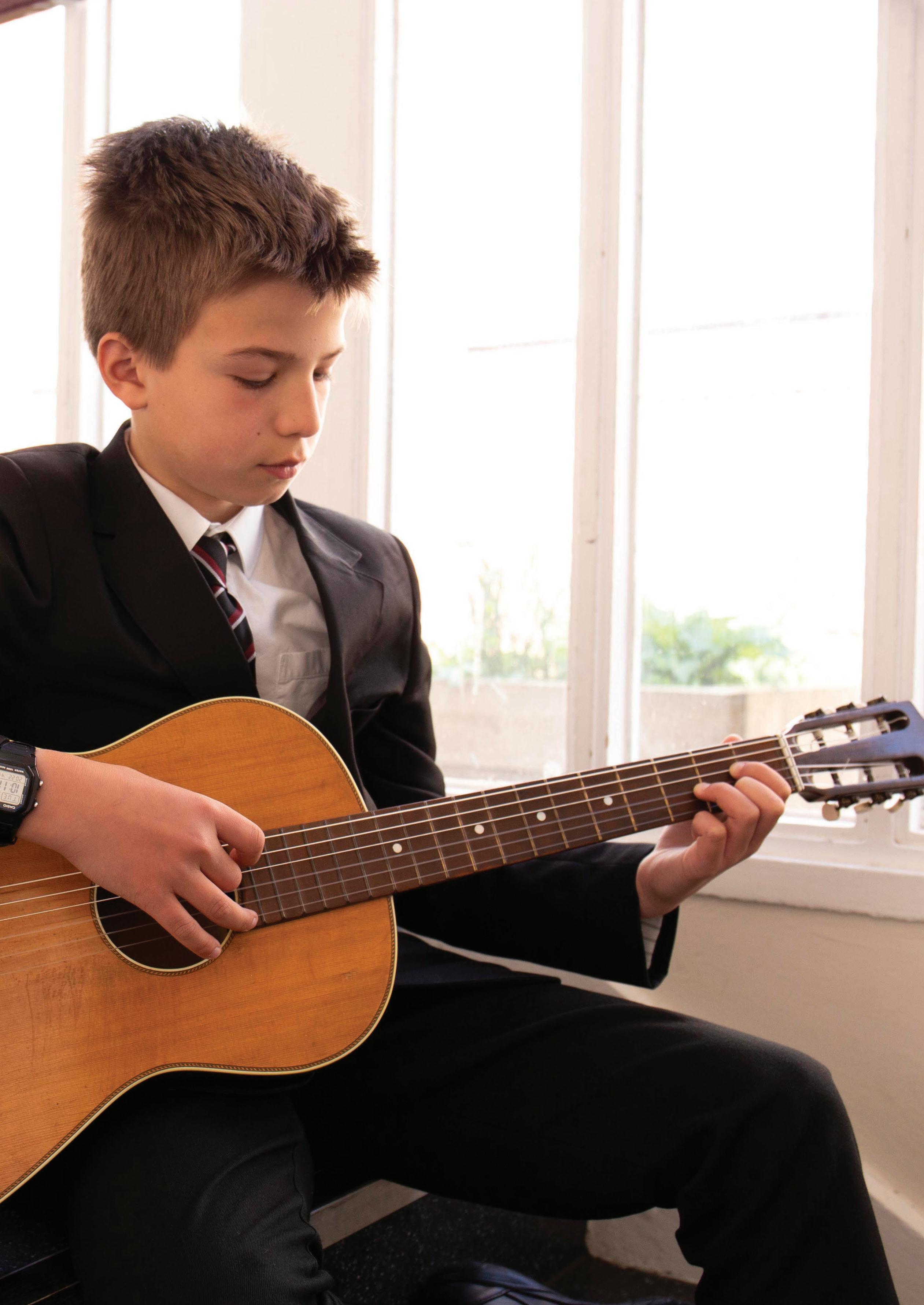
How might a
ABSTRACT
Attempting to undertake a project during the Covid pandemic was clearly difficult. I decided therefore, with guidance from my sponsor and SLT, to explore a way to improve the transition experience for incoming Year 7s. The previous cohort of 2020 had no real transition experience as a result of lockdown and it was felt there was a noticeable difference in their social interactions and engagement in lessons. Furthermore, the diversity of the School’s intake has increased over the last decade, placing more emphasis on transition and School culture as a whole.
7?
Andrew Skinner Head of English

63 Flagship: Journal for Evidence Engaged Practice
broader and more inclusive transition process from Year 6 to Year 7 develop student confidence and attitude to learning in Autumn term for Year
CONTEXT
Historically, the school had offered a paid sports ‘camp’ to incoming students with attendance of around 55% on average for the three years preceding the pandemic. In 2020, the offering was a half day in the summer as all transition activities had been cancelled. Attendance of 90% reflects the unusual circumstances as each form group was offered an isolated half day. For the incoming 2021 cohort, I wanted to explore the opportunities to allow a wider range of students to access and take something meaningful from the experience. Offering a much broader range of activities, bringing in academic subjects and seeking to develop ‘character’ (a School development focus) the camp was designed now with a 50/50 split of sports and games against academic subject activities. The national Covid catch-up premium was explored as a means of funding instead of asking parents for a voluntary donation.
In terms of a broad curriculum, the obvious place to start here is the restricted nature of the summer camp in previous years as a solely sporting event. The increasing importance of transition in the pandemic era suggests the need for a broader and more accessible opportunity for all students. Developing whole school literacy is in its infancy at our School. Ensuring that one of the sessions on offer focused on literacy across the School – something that Y6 students will be familiar with – works well with the new strategy of a whole year group reading text. With all students being sent a copy of ‘Wolf Hollow’ to read before the start of term, the summer literacy session allowed for a discussion of the text in a more informal setting.
LITERATURE REVIEW
The think piece by John West-Burnham (2015) on ‘Moral Leadership’ comprises four main aspects; the fourth of which focuses on the ‘culture’ of the school. Defining ‘culture’ as the ‘language, symbolism and behaviour of an organisation’ any school transition process needs to carefully consider how best to introduce a new cohort to the culture of the School and the desired character attributes. Introducing academic sessions based around developing character allows staff to set the standard early for a new cohort, embedding some expectations before term commences.
Davies and Davies (2004) present the need for short term and long term goals working with each other. This was really important for the unique circumstances of the duration of this transition course. The short term, immediate focus was on Summer 2021 cohort, but with the understanding of looking years ahead at what the transition camp may look like without the impact of Covid and of course without the catch up premium. This is very much what Davies and Davies (2004) term ‘reframing’: setting up the ‘new future’ in what will be a changing context. Therefore, the goal was to be ‘successful and sustainable both in the short and long term.’ It was important to focus on summer 2021 as the start of (hopefully) a change in approach in the long term.
Of Goleman’s (2000) famous six leadership ‘styles’, the one that most lends itself to this particular project was very much the democratic. The nature of the transition camp being in holiday time meant that it very much relied on willing volunteers and a collaborative approach. Each department and by extension staff volunteers were responsible for their own content, thus all were working together, collaboratively, for a common goal. Elements of the affiliative approach were of course relevant too. Linking back to the West-Burnham (2015) referenced earlier, with an already established culture set through ‘moral leadership’ from SLT down to student, this approach was far more productive than any kind of coercive or authoritative approach. Having said this, the aims of the sessions were absolutely set from an authoritative perspective, having already been discussed with the Assistant Headteacher, Head of Year and Senior Leadership Team.
w: ags.bucks.sch.uk 64
How might a broader and more inclusive transition process from Year 6 to Year 7 develop student confidence and attitude to learning in Autumn term for Year 7?
Hattie’s research (2003) places teacher influence on student variance at 30%, behind only the student themselves (50%) in weighting. Having the ability to put students in front of teachers as part of an extra transition opportunity therefore seemed a sensible idea. From here, awareness of Kotter (1995) focuses on creating the climate for change first. Building the right team was really the first point here – it was important to have people on board who wanted to be involved, therefore a voluntary sign up seemed appropriate to start with, albeit with a gentle ‘nudge’ that it would be great to have the core subjects involved. The new literacy lead, currently going through their own process of leading and implementing change, was approached directly as an opportunity to embed good practice from the outset. Kotter’s final steps (‘don’t let up’ and ‘make it stick’) are the final stages – where the project is currently. The student feedback has been important in ensuring that the academic sessions will be run next year and beyond.
Kubler-Ross’ (1969) change curve can be linked more closely to individual ‘buy-in’ and attitude to change, and was somewhat negated by careful thought about Kotter’s model with ‘building the team’ selectively. However, student feedback suggested some subject areas they felt would benefit them and therefore thinking about future impact and a lasting legacy would require wider involvement from other departments. Recognising some of the reasons for a lack of early involvement will help build for the future.
McAleavey, Rigall and Fitzpatrick (2016) acknowledge the importance of collaboration with other schools. Understanding how other schools operate provides clear learning opportunities. In particular, it is important to think about schools with a similar context. As a ‘Challenge Partners’ hub school, as well as being able to draw on the BASS group of schools, the School is well placed in terms of learning from others. In terms of the particular focus for the project, it was useful to see what the sister school (girls’ selective state) was offering as well. Running alongside their transition camp provided a useful point of comparison. Equally, in terms of the ‘buy in’ alluded to in Kubler Ross’ change curve, being able to show success elsewhere is credible support.
Professor Louise Stoll’s 2016 OECD report focuses on schools as ‘Learning Organisations [..] that react more quickly to changing external environments, embrace innovation […] and ultimately improve student outcomes.’ At a time of unprecedented uncertainty, the professional development and overall development of schools as ‘learning organisations’ has never been more relevant. The changes and adaptations that all schools have made over the last two years have been extraordinary. Not least the pressures in dealing with exams. At a time of great upheaval, creating huge new systems and development were clearly not the top of any priority list. The School development plan rightly was dominated with Covid catch up and readjustments. Therefore, focusing projects around negating Covid impact, and not looking to pursue other avenues at a time when staff were focused on remote learning and exam setting, marking and grading was the only option.

65
Having said this, the Teacher Development Trust rightly highlights that professional development linked to student outcomes leads to increased buy-in by staff and ultimately pupil progress. Therefore, the academic sessions would prove a development opportunity for staff at a career entry level. Incoming Early Career Teachers (ECTs) in Maths and English, and a recently qualified teacher in History, were given the opportunity to design and deliver the sessions, working alongside their respective Heads of Department as well as overall guidance from myself. Staff were therefore given the opportunity to build on existing areas of strength and interest to tailor the sessions accordingly. School wide work on ‘character’ education has been provided via INSET and remains a School priority into 2021-22.
Brundrett’s (2006) notes that individualism and collectivism have an ‘equal’ role to play in effective change in organisations. This principle underpinned the planning of the sessions. Individuals were free to pursue what they liked, under the umbrella of a collective goal. This is further reasoning behind offering the opportunity to career entry members of staff as well.
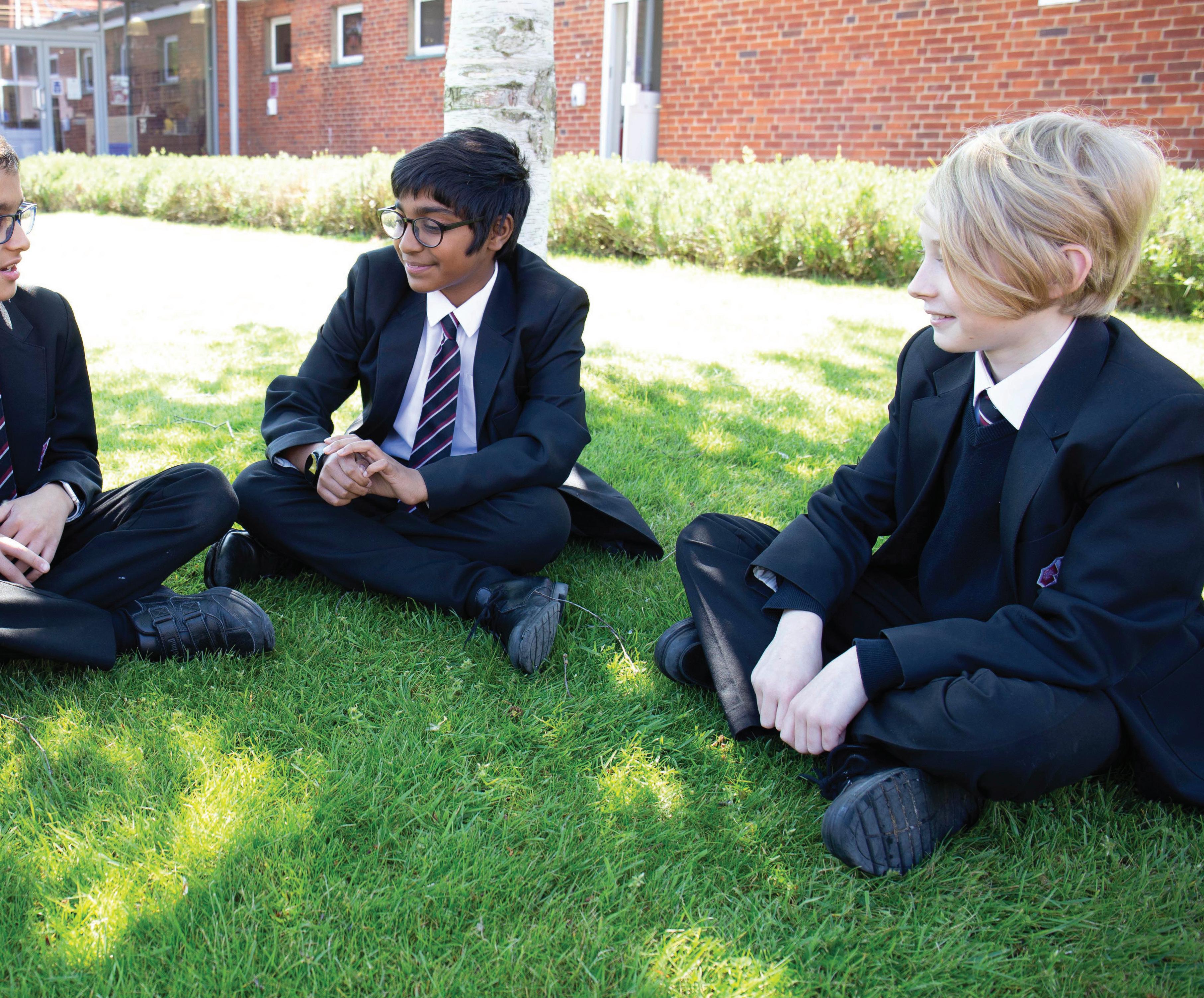
How might a broader and more inclusive transition process from Year 6 to Year 7 develop student confidence and attitude to learning in Autumn term for Year 7?
METHODOLOGY
The baseline data used here are the School’s Year 7 Autumn Attitude to Learning (ATL) grades. These provide a snapshot of the focus and attitude of how the students have adapted in their first term. The data used was a breakdown of all subjects’ ATL grades for the preceding four years, then adding the data from the first term of this academic year. The first point of comparison was to look at the impact of the first lock-down hit cohort of 2020 compared to 2019. This revealed that 53% of subjects saw a decline in the number of O (Outstanding) grades awarded, with 47% of subjects seeing an increase in the number of R (Requires Improvement) grades awarded. This was backed up by the overall number of ‘O’ grades dropping from 26.88% to 24.93 and the ‘R’ grades increasing from 3.23% to 4.21. The data supports targeted transition activities with the drop in overall ATL for the cohort with minimal transition activities, and of course a period in lockdown.
Furthermore, with attendance averaging 55% across 2017-19 for the summer camp as exclusively sports, the aim was to steadily increase student participation. Due to tighter restrictions in the summer of 2020, a half day summer induction saw 90% attendance, but will be viewed as anomalous due to national circumstances.
Covid catch up and recovery were prominent elements of the School Development Plan for 2020-21. LT1 (Learning and Teaching) and CD1 (Community and Development) were both concerned with developing in-School support for welfare, pastorally and for learning and teaching. The Education Times in Crisis report highlighted transition between Year 6 and 7 as an area particularly affected by Covid restrictions. In addition, the report highlighted the perceived value of relationships in the classroom, both between students and also between staff and students. Combining these factors helped create the case for an improved transition experience and opportunity.
The government ‘Catch-up premium’ can be used by schools ‘in a way that suits their cohort and circumstances’ and ‘should particularly focus on disadvantaged and vulnerable students as […] they have been most affected.’ Anecdotal evidence suggested the 2020 intake struggled more with relationships and understanding expectations at secondary level, particularly amongst students with special education needs, a fact backed up with the ATL data discussed earlier.
In addition, the School’s intake has changed over the last decade to a much more diverse cohort. The table below shows a marked increase of 47% in the proportion of students from BAME backgrounds entering the school within the last 15 years. With SEND numbers averaging 12% of each year group over the last four years, alongside the 57% BAME proportion for the incoming 2021 cohort, further evidence of the importance of transition and character education is provided. This data analysis provided the evidence to explore ways to improve the transition experience.
Table 1: Breakdown of student population
Due to the nature of the academic sessions, learning walks were the most appropriate strategy to gather evidence of the quality of the sessions. There were two main areas of focus for the learning walks themselves: focus on the development of ‘character’ through subject based learning and engagement of students in the task. The latter element would also be evaluated through seeking student feedback. During the learning walks themselves, discussions would take place with students as well as the staff involved. Staff feedback, feedback from HoY and AHT were all factored in. The most effective way to gain mass feedback from the students was through the use of a Google Form. A combination of multiple choice options along with open questions allowed for the most useful feedback. A ‘wordle’ was created from the open responses. More informal feedback was sought through discussions with individuals.
67 Flagship: Journal for Evidence Engaged Practice
Entry year 05 06 07 08 09 10 % BAME 10 18 18 17 22 23 Entry year 11 12 13 14 15 16 % BAME 27 28 27 29 37 31 Entry year 17 18 19 20 21 % BAME 45 45 57 54 57
Having already requested an outline of the sessions and their content, it was unsurprising that the learning walks showed a clear, strong and purposeful approach to the development of character. Some brief examples would include the Literacy escape room session, with students working in teams to decipher clues, codes and puzzles. The science and maths sessions encouraged students to hypothesise and find solutions to problems by trial and error. Students were engaged in sessions and the small group nature of the days allowed for much greater staff interaction and assistance for those unsure and lacking in confidence. Staff created positive learning environments allowing students to try things for themselves, whilst offering guidance on how to approach team work.
w: ags.bucks.sch.uk 68
How might a broader and more inclusive transition process from Year 6 to Year 7 develop student confidence and attitude to learning in Autumn term for Year 7?
The previous cohort of 2020 had no real transition experience as a result of lockdown and it was felt there was a noticeable difference in their social interactions and engagement in lessons.
FINDINGS
I decided to use School attitude to learning (ATL) data as one method of measuring if the change had any impact on perceived attitude in the classroom. The data from autumn term only would be used as a guide. Clearly, each year group brings with it a different set of individuals, and different experiences, so I am well aware of the potential for natural variation. Pleasingly, the ATL data comparison suggested a clear improvement in the way students had settled into secondary school life. Whereas 2020 data showed 53% of subjects saw a drop in the amount of ‘O’ (Outstanding) grades awarded from 2019, the 2021 data showed 65% of subjects increased the amount of ‘O’ grades. Equally 2020 data saw 47% of subjects with an increase in ‘R’ (Requires Improvement) grades whereas 2021 data showed 65% of subjects saw a decrease in the amount of ‘R’ grades recorded. The improvement beyond 2019 data was particularly pleasing. The overall percentage of ‘O’ grades of 26.96% was the highest of the last five years. The overall percentage of ‘R’ grades of 2.13% was the lowest of the five year period recorded, and nearly half that of 2020’s high.
The student feedback and feedback from staff was overwhelmingly positive. 86% of attendees selected at least one of the academic sessions in their top three sessions, a more accurate reflection of the nature of our intake.
Participation in the sessions increased to 73% from the 55% average from 2017-19. Only one attendee didn’t feel that the sessions increased their confidence in lessons for the first two weeks of term.
Overall, the project was successful in terms of providing a more holistic approach to transition, catering for the needs of a wider range of students after a difficult two years. This is further reinforced by the fact that the School has agreed to continue to offer the academic sessions as part of the transition camp going forward.
The data results suggest the short term goal was achieved, i.e. the immediate improvement in the ATL of a new Y7 cohort. The project now moves into the long term phase, and is currently in the planning process for summer 2022. Davies and Davies’ notion of ‘reframing’ is clearly to the fore here, with national circumstances (particularly around funding) changing the context. The challenge will be to offer continued progress with a different funding capability.
ESTABLISHING EFFECTIVE PARTNERSHIPS
Effective partnerships have been enhanced through the development of the academic programme, perhaps most evidently through working with the Year 7 Head of Year, Head of Section, Resources Director and premises team. The practical elements of leading a whole School project such as this has given me the opportunity to discuss and learn from staff (particularly support staff) who I wouldn’t normally have contact with. Some of the most time consuming discussions have been with the Resources Director and Premises Manager over the availability of resources and running the camp alongside some significant building projects.
In addition to increasing my exposure to, and understanding of, the practical areas of School management, working with different departments has been a clear area of encouragement. Collaborating with science and maths in particular has strengthened partnerships and understanding areas that are more unfamiliar; the need for resources and preparation of chemicals and single use only items in science is one such example. This was really important in terms of appreciating and developing a more ‘affiliative’ approach to leadership. Liaising with a team with a different set of priorities, different goals, and different targets, and understanding their reasons was one of the more useful elements of the project from a personal perspective. It also highlighted the importance of West-Burnham’s ‘moral leadership’. If the ‘culture’ is set from the top through all staff, then ‘buy-in’ should be more effective.
Furthermore, working closely with the new School Literacy Lead and the librarian to raise the profile of Literacy and its importance across the curriculum has been an area of focus for the School. Encouraging students to see the relevance of character education continues as part of the School learning and teaching development plan (LT3).
69 Flagship: Journal for Evidence Engaged Practice
COLLABORATIONS
Collaborating and working across different subject areas for a common goal of an improved transition experience can be deemed as successful through the data results already discussed. Furthermore, Maths, English, History and Science (Business is not taught discretely at KS3, nor is Literacy) nearly all showed an increase in ‘O’ ATL grades from 2020 and a decrease in ‘R’ grades. Maths increased from 16.67% to 20.21% for ‘O’ grades, English 39.25% to 46.28% (highest % in 5 years tracked), History 37.63% to 39.89% (highest in 5 years) and Science 21.51% to 29.79% (highest in the 5 years). In terms of the reduction in ‘R’ grades, Maths went from 9.14% to 4.26% (its lowest % in the 5 years tracked), English roughly the same with 3.23% compared to 3.72%, History 0.54% to 0% (joint lowest) and Science 3.23% compared to 3.72%.
In addition, only one out of the 136 respondents felt that the camp didn’t increase their confidence and help them after their first two weeks in September, along with 86% of students selecting one of the academic sessions in their top three. This in itself would suggest the collaboration was a success.
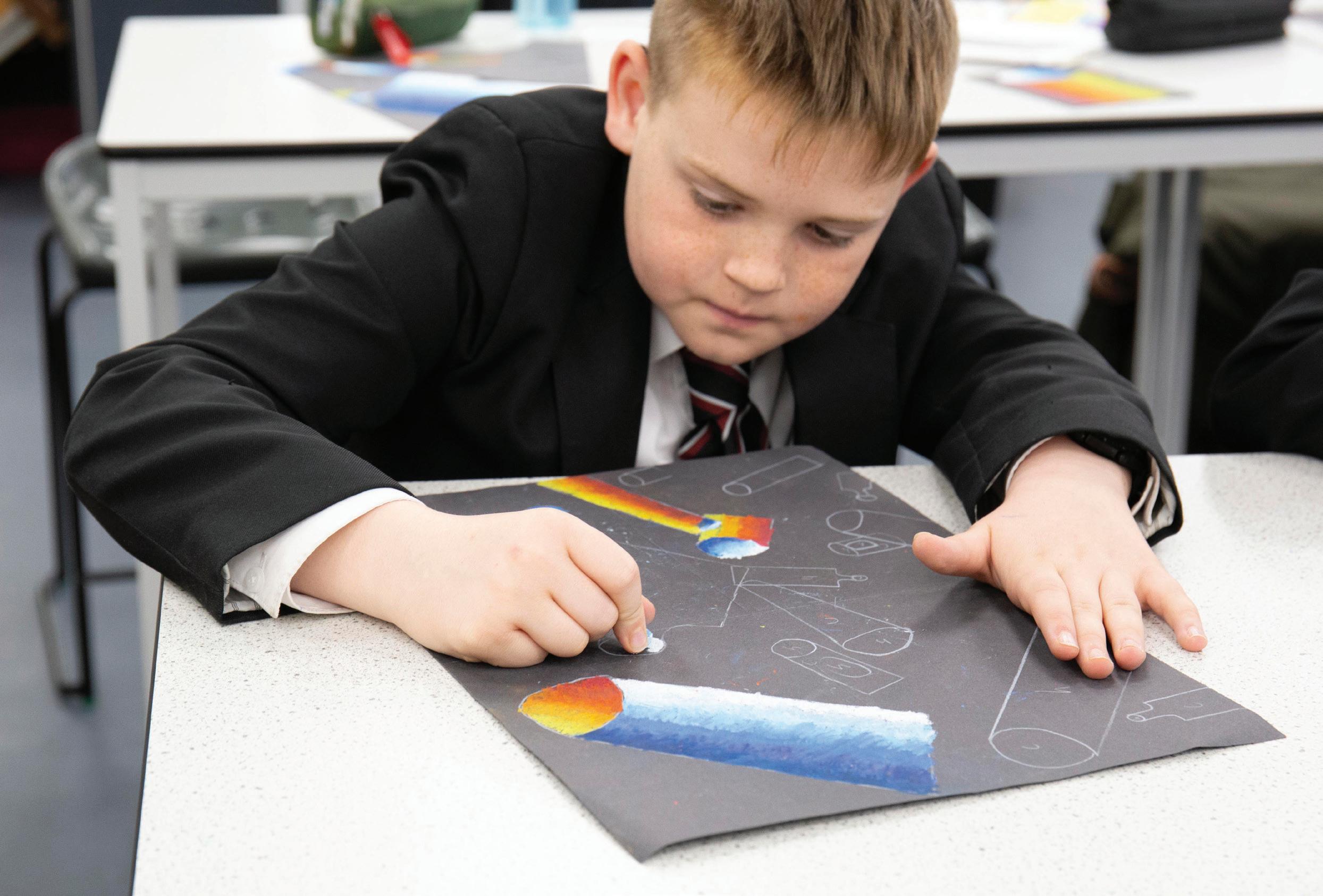
How might a broader and more inclusive transition process from Year 6 to Year 7 develop student confidence and attitude to learning in Autumn term for Year 7?
Students were engaged in sessions and the small group nature of the days allowed for much greater staff interaction and assistance for those unsure and lacking in confidence.
CONCLUSIONS
Student feedback was overwhelmingly positive. Only one student of the 136 who responded felt that the sessions didn’t improve their confidence for lessons in the first two weeks of term. 86% of students selected at least one academic session in their top three sessions (including all sports and games activities). This shows the tasks and content were well selected. Open responses to the question of how it made them more confident during the first two weeks of term were placed into a wordle with ‘people’ and ‘friends’ along with the verb ‘making’ suggesting it was hugely beneficial for relationships. ‘Classrooms’, ‘subjects’ and ‘teachers’ are particularly encouraging in terms of the academic sessions themselves, with students citing an increased confidence and understanding of the culture of the School and expectations of them.
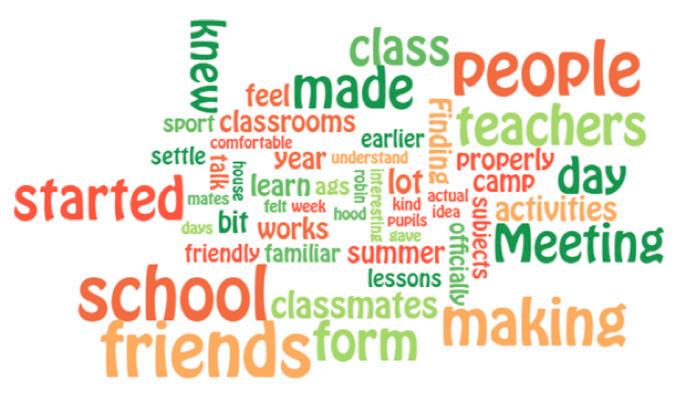
Overall figures were barely noticeably higher (2021 26.96%; 2019 26.88%) for ‘O’ grades, but clearly lower – in fact the lowest recorded – for ‘R’ grades (2021 2.13%; 2019 3.23%).
The feedback has created a compelling case to continue with an expanded transition camp opportunity. Planning is underway for the 2022 version at the time of writing.
Overall attendance was up by 18% from the three year average (2017-19) from 55% to 73%. Attendance was impacted by Covid cases, but it is important to note the cost implications as well. Data from 2022 and beyond will be more directly comparable without the prospect of Covid catch up funding.
ATL data revealed a pleasing increase in the overall attitude of students. Headline figures include the increase of ‘O’ grades in 65% of subjects for 2021 autumn term. This was matched with a decrease in ‘R’ grades for 65% of subjects as well. The overall grades for 2021 were up from 2020. The percentage of 2021 ‘O’ grades (26.96%) were higher than 2020’s (24.93); and the overall percentage of ‘R’ grades (2.13%) for 2021 was nearly half 2020’s high of 4.21%. This is arguably a vindication of the use of the Covid catch up premium. A comparison with 2019 (pre Covid) would also be useful in determining the longer term impact against a ‘normal’ year. Here too, there was an improvement. 53% of subjects saw a rise in ‘O’ grades in 2021 compared to 2019; 53% a reduction in ‘R’ grades.
71 Flagship: Journal for Evidence Engaged Practice
Staff created positive learning environments allowing students to try things for themselves, whilst offering guidance on how to approach team work.
REFERENCES
Barbara J. Davies & Brent Davies (2004) Strategic leadership, School Leadership & Management, 24:1, 29-38, DOI: 10.1080/1363243042000172804
Brundrett, Mark. (2006). Vision, strategy and planning in Education. Leadership Pathways.
Educationdevelopmenttrust.com. 2022. Rapid School Development. [online] Available at: <https://www.educationdevelopmenttrust.com/ EducationDevelopmentTrust/files/2c/2cf47b83-39d7-402f-929f-4858539c123a. pdf> [Accessed 11 August 2022].
Goleman, D., 2000. Leadership that gets results. Harvard Business Review, March - April, pp.78-90.
Hattie, J. (2008). Visible learning. Routledge.
International, K., 2016. The 8-Step Process for Leading Change - Kotter International. [online] Kotter International. Available at: <http://www. kotterinternational.com/the-8-step-process-for-leading-change/>
Kubler-Ross, E., 1972. On death and dying. JAMA: The Journal of the American Medical Association, 221(2), pp.174-179.
Oecd.org. 2022. What makes a school a learning organisation?. [online] Available at: <https://www.oecd.org/education/school/school-learningorganisation.pdf> [Accessed 11 August 2022].
Unrwa.org. 2022. Moral Leadership. [online] Available at: <https://www.unrwa. org/userfiles/file/leading_4_the_future/module1/moral-leadership%20 West%20Burnham.pdf> [Accessed 11 August 2022].
w: ags.bucks.sch.uk 72
How
a broader and more inclusive transition process from Year 6 to Year 7 develop student confidence and attitude to learning in Autumn term for Year 7?
might
Using technology to support self-paced learning in physics and the effect on self-efficacy
Finn Teacher of Physics and Digital Learning Leader

ABSTRACT
Like many teachers, I have often thought about getting the pace of lessons right for the students in my classes. Inevitably there is no single pace that suits all students; too fast and they move on before they fully understand, or too slow and they get bored. The use of one-to-one devices in the classroom, however, opens up the possibility for students to work on a wide range of learning activities in a self-paced manner. This action research project investigated how using technology in the classroom to access a module of self-paced learning impacted two classes of Year 10 Physics students’ beliefs about their learning and self-efficacy. The students studied a module on Heat and Temperature through a structured scheme of tasks, undertaken at their own pace. Students were given choices on how long they would spend on each task and about some of the tasks they completed. Both qualitative and quantitative data were collected to gauge students’ self-efficacy beliefs and understanding of the physics covered. The self-paced learning using technology maintained high levels of self-efficacy in the students. In addition, the students found that being able to control how long they spent on each task was a benefit and they were able to make use of the wide range of resources available to them through the internet to consolidate their learning. Some students struggled with regulating their own learning, however, so further research into effective implementation would be useful.
73 Flagship: Journal for Evidence Engaged Practice
Amber
GLOSSARY
Computer based learning (CBL): “is the term used for any kind of learning with the help of computers. Computerbased learning makes use of the interactive elements of the computer applications and software and the ability to present any type of media to the users.” (Techopedia, 2016)
Self-paced instruction: any kind of instruction that proceeds based on learner response. Self-paced instruction is constructed in such a way that the learner proceeds from one topic or segment to the next at their own speed. (Wikipedia, n.d.)
Self-efficacy: according to psychologist Albert Bandura, who originally proposed the concept, is the belief or judgement made by an individual that they can succeed or accomplish an identified task. (Bandura, 2010)
Technology is increasingly becoming a key tool in modern education, with students in many schools using computers or other devices on a regular basis. There are many exciting new learning tasks that students can access, and devices offer the possibility of personalising learning. There are, however, also the challenges of how technology can be used effectively and how possible distractions to student learning can be managed.
Whilst teaching, I have found it can be challenging to set tasks that all students can complete in the time that they are given. I am concerned that students can find the pace of learning in class too fast or slow and the content too challenging or easy. I feel that these challenges can affect their confidence in their ability to learn physics, and can lead to disengagement. I have been very interested in the possibility of using technology to personalise learning more for individual students, as they can access many different resources and move from task to task at their own pace. My interest led me to wonder how the use of technology can be embedded in the teaching of a topic and whether the integration of technology to allow students to learn at their own pace will improve their sense of self-efficacy, given they will have more control over their learning, and will harness the boys’ widespread enthusiasm for the use of technology.
I chose to use action research to assess the impact of technology that I implemented with the students in my classes. There are ways of learning that I would like to try with my students anyway, and action research allowed me to systematically look at the impact of particular interventions on my classes, whilst still being an active participant in the process of the action.
w: ags.bucks.sch.uk 74
Using technology to support self-paced learning in physics and the effect on self-efficacy
There is no single pace that suits all students; too fast and they move on before they fully understand, or too slow and they get bored.
LITERATURE REVIEW
USE OF TECHNOLOGY
The Education Endowment Foundation advises that there is strong evidence of moderate learning gains when technology is used for learning (Lewin et al., 2019). Drawing on reviews and meta-analyses of the use of technology in education, Lewin and colleagues found that technology is used most effectively when it supplements traditional learning and enables positive changes in learning interactions.
Boys show more interest in technology at the age of 14 than girls (Ardies et al., 2014). In Mathematics, which is similar to Physics, it has been shown that boys are more positive than girls about the use of technology and that this is associated with high confidence and achievement in the subject (Gialamas et al., 2009).
Consequently, it is important to consider how the use of technology fits within the content and pedagogy of the existing curriculum to effectively enhance learning. The intersection between the three domains is formalised in the Technology, Pedagogy and Content Knowledge (TPACK) framework (Harris et al., 2009). Figure 1 shows how the three areas of knowledge are essential in order to use technology for effective learning, such that the most appropriate technology is chosen to support the pedagogy and enhance the content learning, where all three domains intersect.

WHEN IS COMPUTER BASED LEARNING EFFECTIVE?
In Physics the use of technology tools for self-study can result “in a statistically significant increase in average student performance” (DeVore et al., 2017, p.7). However, in the same study De Vore and colleagues found that students who are more likely to benefit from extra study time are also less likely to be motivated and lack the self-regulation skills required to engage with self-study tools without supervision. DeVore and colleagues’ study emphasises the importance of not only how the tool is designed but also how it is implemented. A framework for tool design and implementation called the Self-Study for Engaged Learning Framework (SELF) was developed by DeVore, which highlights the interplay between factors relating to the tool and the user, such as scaffolding provided within the tool, users’ previous knowledge and support for students’ self-efficacy beliefs. The effect size of SELF on student performance depends largely on prior learning and topic. The intervention, a self-study tool, employed worked problems to help to clarify misconceptions and scaffold student learning.
SELF-PACED LEARNING
Self-paced learning has been shown to be more effective than learning where the pace of introduction of items to be learnt is externally controlled (Tullis & Benjamin, 2010). It is particularly effective where learners use metacognition to allocate more time to learning more difficult items.
A recent study found that the use of devices in conjunction with an online course and interactive video can promote self-paced learning. This online course is effective for learning physics topics (in this case heat transfer) and can lead to improved student satisfaction with their own learning (Palaigeorgiou & Papadopoulou, 2019). This approach was equally well suited to girls and boys. Students showed improvement from pre-test to post-test, in their conceptual understanding of thermal physics via a validated assessment. Students in these studies attributed their improvements to the use of interactive video and how questions embedded in the videos prompted thought and discussion. Importance students placed on discussion highlights that it is important to preserve opportunities for discussion while putting in place a module of selfpaced learning. Similar research validated assessments are available to show conceptual understanding of thermal physics more broadly (Chu et al., 2012, Yeo & Zadnik, 2001).
75 Flagship: Journal for Evidence Engaged Practice
Figure 1 TPACK framework (Harris et al., 2009)
SELF-EFFICACY
Self-efficacy is the belief in one’s own ability to influence outcomes in a particular domain. According to Bandura (1977), self-efficacy plays a crucial role in determining the coping mechanisms and level of persistence that individuals employ when faced with a challenging task. A lack of selfefficacy can lead to defensive behaviour. Bandura sought to bring together the procedures and sources of information that can influence levels of self-efficacy through metaanalysis of studies between 2001 and 2015. This metaanalysis shows there is a medium correlation between self-efficacy and academic achievement, with a Pearson correlation coefficient of r=0.33, showing that about a third of academic achievement can be attributed to self-efficacy or its causes (Honicke & Broadbent, 2016). This positive correlation was seen over almost all the studies, and lends weight to the idea that improving students selfefficacy goes hand in hand with increasing achievement.
SELF-EFFICACY IN PHYSICS
Self-efficacy in physics can be assessed through the Physics Self-Efficacy Questionnaire (Lindstrom & Sharma, 2010), which follows the design principles as set out by Bandura (2005). Interestingly, in Lindstrom and Sharma’s study there were differences in self-efficacy between male and female students, both before studying a physics course and after formal instruction, with male students generally having higher self-efficacy and being more resilient to change.
Previous studies have shown that self-efficacy declines with formal instruction in physics (Lindstrom & Sharma, 2010), so it is a challenging task to increase self-efficacy in physics through study.
USING TECHNOLOGY IN PHYSICS
The use of interactive technology can improve students’ self-efficacy in physics, as was shown by Cai’s study (2020) on the use of augmented reality (AR) to teach physics. Here the increase in self-efficacy was attributed to the ability of AR to let students virtually conduct practical work that would be difficult in a conventional teaching laboratory. Conversely, another study showed student self-efficacy was lower in topics where hands-on practical work was replaced purely with computer based simulations (Stoeckel & Roehrig, 2021). The detrimental effect of replacing practical work makes the case for retaining practical work within the student laboratory in physics where possible and using simulations to supplement this. In contradiction to previous studies, Stoeckel and Roehrig’s study also found that both male and female students had self-efficacy that strongly corresponded to their academic performance and that self-efficacy remained at similar levels throughout a physics course. A key element of physics study that was perceived to reinforce self-efficacy for both girls and boys was guided inquiry based practicals; however boys’ self-efficacy, unlike girls, also benefited from applying the concepts learned in practicals to solving problem sets.
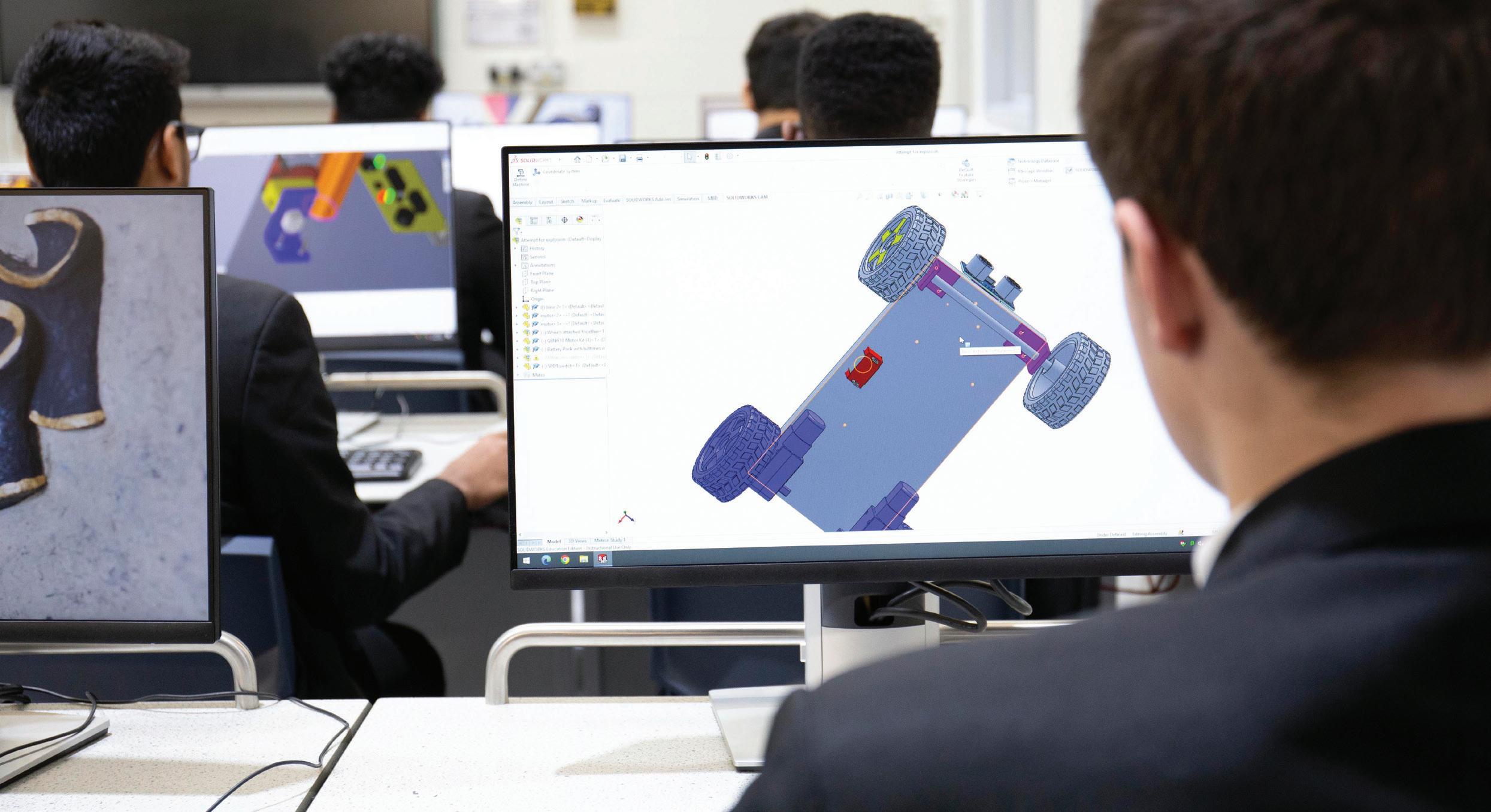 Using technology to support self-paced learning in physics and the effect on self-efficacy
Using technology to support self-paced learning in physics and the effect on self-efficacy
RESEARCH CONTEXT
The school has been developing its use of technology in the classroom over recent years and is planning further integration in the near future, with students having individual devices to use in school. Two classes of Year 10 students (ages 14 to 15) took part in the research action, totalling 53 students. I had taught many but not all the students in previous years. The action took place from October, near the start of our academic year, meaning I had formed good relationships with some students, but not yet with others.
THE ACTION
Over the course of six weeks the students completed a topic on Heat and Temperature using a self-paced module of work delivered on individual Chromebooks. Tasks and resources were accessed by the students using hyperdocs. A hyperdoc is an electronic document containing hyperlinks to tasks and areas for the students to answer questions and add their own notes. The tasks that the students undertook were very diverse in nature. Both physical practicals (which used bluetooth devices to log data) and simulated practicals were included in the planned tasks. Interactive content in the form of videos with embedded questions and simulations of physical behaviour, such as visualisations of the motion of atoms as they are heated, were included. The students also discussed physics questions and the conclusions of their practical work in a shared digital space. Self-marking quiz questions were assigned where they could apply their knowledge of the Heat and Temperature topic through practice. Whilst the students could move on from one task to the next in their own time, I also stopped the class at some points to go through parts of the topic as a group and to provide collective feedback based on how students had done on the tasks.
DATA COLLECTION
To investigate how the students’ conceptual knowledge of thermal physics changed over the course of the action, they were given a pre- and post-test called the Thermal Concept Evaluation (TCE) (Chu et al., 2012; Yeo & Zadnik, 2001). Before and after the action, self-efficacy was evaluated using a survey, the Self-Efficacy in Physics Scale, which was designed and validated for use with physics students in secondary education and above and based on the principles for creating self-efficacy scales (Bandura, 2005; Lindstrom & Sharma, 2010). In addition to the questions from the Self-efficacy in Physics Scale, the post-action survey also asked the students open questions about their experiences of self-paced learning using technology. A small group of students attended a group interview to gain further depth and detail about their experiences. The interview was semi-structured, with the questions planned beforehand but flexibility enabled follow up questions to gather more detailed responses.
DATA ANALYSIS
Data from the open questions on the post-action survey and the small group interview were coded and then organised into themes based on the trends and patterns that I perceived in the responses. Scores on the Thermal Concept Evaluation and Self-Efficacy in Physics Scale surveys were compared from before and after the action. I also compared scores on the End of Topic Test with the students’ individual targets and the difference compared with similar classes within the School for the same topic taught in a conventional manner.
DISCUSSION OF FINDINGS
Three themes emerged from my coding and analysis of the qualitative data. Firstly, students felt able to work at their own pace and spend more time on tasks that required it. Secondly, they were able to make use of extra-resources to support their own learning. Finally, the students felt calmer while doing the work.
77 Flagship: Journal for Evidence Engaged Practice
WORKING AT THEIR OWN PACE
This phrase was included in the responses of 16 out of 51 students when asked the question: What were the positives of using technology for self-paced learning? 31 out of the 51 respondents also agreed that using the Chromebooks allowed them to work at their own pace. Although this is a majority, it is interesting that some were either neutral or did not agree, as there weren’t apparent external factors forcing them to work at a particular pace. Working at their own pace was more often associated with positives, with qualifiers, such as, “I found that I could work at my own pace and I could pay more attention” or “working at my own pace which was really nice”. This finding was also supported during the interview conducted with a small group of students, where Boy A said, “because you get to work at your own speed you can understand … much better than before”. The students commented on how they were able to spend more time on areas that they felt they needed to, with 10 out of 55 students mentioning this in the questionnaire and three out of the five students in the interview. I was impressed during the intervention to see most students managing their learning well. In the interview, Boy B commented, “ it was better, you’re not rushing to get work done, so you could go over and over again if you wanted to really get into it.” Although the students were provided with tasks to do, they had some choice for certain tasks and they were able to choose the tasks that would reinforce their own learning. Boy B also commented on having the chance to do practice questions in a way that he wouldn’t usually do, stating that, “I think doing so many of them actually helped me quite a lot because normally I wouldn’t really do many, so the fact that we did loads and loads and then we get feedback straightaway.”
One drawback of self-paced learning that emerged through the study was the reduction in teacher-directed learning. Although some features of lessons that would normally be done during a more traditional lesson were still included, such as practical work and whole class explanations, they were either done differently (practicals carried out by different students at different times) or took up less of the lesson time than they usually would. 13 out of 55 students commented on difficulties or missed this kind of tuition, particularly teacher instruction, doing more practical work or taking notes by hand. In the interview an explanation that some students provided was that they remember better
when writing by hand, as Boy C commented “if you’re doing it physically, you’re remembering it more if you are writing it up physically than just tapping keys on a keyboard and it coming up on the screen.”
ACCESS TO EVERYTHING
Using Chromebooks enabled and supported students to implement strategies to improve their learning: as one boy put it, “having access to everything.” This had both positive and negative effects, with many students commenting on how they were able to look things up easily if needed, while many also commented on how they could get distracted. I observed effective independent learning happening during lessons, with students making decisions on what to spend longer on and where to do further background study. I also saw students look up further information when they needed, often using platforms that they had been introduced to through the tasks set. This practice was also mentioned by quite a few students (15 of 55) as being a positive element of what they experienced. The students appeared confident as they did this. Conversely, some students went on to websites unrelated to the task and had to be reminded of what they should be doing. However, I was able to spend time with these students individually, as the rest of the class were getting on with the tasks.
FLEXIBILITY
A few students (seven out of 55) commented on how they felt calmer or less rushed in their work, with comments on what they found positive, such as, “ being able to understand what I need without feeling rushed by the class”. Some students also commented on finding this way of working enjoyable.
I observed that some students seemed to get worried that they were working at a different pace to others, and this may have affected their sense of self efficacy. This was borne out by the students’ comments that they worked at a slower pace and one student noting, “I didn’t work as hard as I should have.”
w: ags.bucks.sch.uk 78
Using
support self-paced
in
and the effect on self-efficacy
technology to
learning
physics
PHYSICS AND SELF-EFFICACY
Students’ scores on the Thermal Concept Evaluation (Yeo & Zadnik, 2001) were higher on the post-test than pre-test by an average of 23%. They also did well in their end-of-module internal assessment, achieving on average above their predicted score. These data suggest that the students still made good progress in their learning with self-paced learning. Scores from the Physics Self-Efficacy Questionnaire didn’t show any significant change, with one class having a very small increase and the other a very small decrease.
IMPACTS ON SELF-EFFICACY
Although scores for self-efficacy were not significantly increased, many students showed attitudes and behaviours that indicated their ability to learn independently. As many students remarked, they showed persistence and resourcefulness when they found something difficult.
However, there were a significant number who struggled with distractions and regulating their own learning. This could be as a result of lower self-efficacy in these students, as self-efficacy influences self-regulated learning processes (Bernacki & Nokes-Malach, 2014, p. 99). Poor self-regulation could also lead to self-efficacy remaining low, therefore selfpaced learning could reinforce low self-efficacy for some.
CONCLUSIONS
Using individual devices provided the opportunity for students in my two Year 10 Physics classes to learn at their own pace and practice and develop independent learning skills. Their self-efficacy remained high and was demonstrated through their resourcefulness when undertaking tasks.
The action highlighted ways in which self-paced learning using technology could be incorporated into lessons. Using technology allowed students to spend more time on areas that they found challenging and provided them with the ability to self-regulate their own learning; thus, enabling an opportunity for the students to conduct further research into areas of development. The students also highly valued being able to do practice and get feedback on their answers immediately. However, there are changes that I would make when implementing self-paced learning in the future. I would spend time gradually developing students’ independent learning skills by gradually building up the length of time students spend working independently and setting tasks where the main aim is to work independently.
REFLECTION STATEMENT
It has been really interesting to implement the use of technology for self-paced learning. It has challenged many of the assumptions I had about classroom practice and left me with many further questions. It has been great to see the students I teach engage with new and interesting tasks and to see many of them embracing independent learning and the ownership of the process. This action research project has also reminded me of the importance of the teacher in guided practice within the classroom, highlighted by the students’ own comments.
79 Flagship: Journal for Evidence Engaged Practice
Self-paced learning has been shown to be more effective than learning where the pace of introduction of items to be learnt is externally controlled
REFERENCES
Ardies, J., De Mayer, S., Gijbels, D., & van Keulen, H. (2014, March). Students attitudes towards technology. International Journal of Technology and Design Education. DOI 10.1007/s10798-014-9268-x
Bandura, A. (2005). Guide for creating self-efficacy scales. In F. Pajares & T. Urdan (Eds.), Self-efficacy beliefs of adolescents (pp. 307-337). Information Age Publishing.
Bandura, A. (2010). Self-Efficacy. In I. B. Weiner (Ed.), The Corsini Encyclopedia of Psychology, 4 Volume Set. Wiley.
Bernacki, M. L., & Nokes-Malach, T. J. (2014, November 26). Examining selfefficacy during learning: variability and relations to behavior, performance, and learning. Metacognition Learning, 99-117. DOI 10.1007/s11409-014-9127-x
Cai, S., Liu, C., Wang, T., Liu, E., & Liang, J.-C. (2020, August). Effects of learning physics using Augmented Reality on students’ self-efficacy and conceptions of learning. British Journal of Educational Technology, 52(4). 10.1111/bjet.13020
Chu, H.-E., Treagust, D., Yeo, S., & Zadnik, M. G. (2012, July). Evaluation of Students’ Understanding of Thermal Concepts in Everyday Contexts. International Journal of Science Education, 34(10), 1-26. 10.1080/09500693.2012.657714
DeVore, S., Marshman, E., & Singh, C. (2016, June). The challenge of engaging all students via self-paced interactive e-learning tutorials for introductory physics. Physical Review Physics Education Research, 13(1). 10.1103/ PhysRevPhysEducRes.13.010127
Gialamas, V., Barkatsas, A. N., & Kasimatis, K. (2009, April). Learning secondary mathematics with technology: Exploring the complex interrelationship between students’ attitudes, engagement, gender and achievement. Computers & Education. DOI: 10.1016/j.compedu.2008.11.001
Harris, J., Koehler, M. J., & Mishra, P. (2009, January). What Is Technological Pedagogical Content Knowledge? Contemporary Issues in Technology and Teacher Education,, 9(1), 60-70.
Honicke, T., & Broadbent, J. (2016, February). The Influence of Academic SelfEfficacy on Academic Performance: A Systematic Review. Educational Research Review, 17, 63-84. 10.1016/j.edurev.2015.11.002
Law, E., Klawe, M., Conati, C., & Meech, J. (2000, January). Team-paced versus Self-paced: The Effects of Educational Game Design on Collaboration, Learning and Attitude towards Information Technology. World Conference on Educational Media and Technology.
Lewin, C., Smith, A., Morris, S., & Craig, E. (2019, December). Using Digital Technology to Improve Learning: Evidence Review. Education Endowment Foundation. https://educationendowmentfoundation.org.uk/educationevidence/evidence-reviews/digital-technology-2019
Lindstrom, C., & Sharma, M. D. (2010, November). Self-Efficacy of First Year University Physics Students: Do Gender and Prior Formal Instruction in Physics Matter? International Journal of Innovation in Science and Mathematics Education, 19.
Palaigeorgiou, G., & Papadopoulou, A. (2019, January). Promoting self-paced learning in the elementary classroom with interactive video, an online course platform and tablets. Education and Information Technologies, 805-823. https://doi.org/10.1007/s10639-018-9804-5
Stoeckel, M., & Roehrig, G. (2021, July). Gender differences in classroom experiences impacting self-efficacy in an AP Physics 1 classroom. Physical Review Physics Education Research, 17(2). 10.1103/ PhysRevPhysEducRes.17.020102
Techopedia. (2016, December 28). Computer-Based Learning (CBL)? - Definition from Techopedia. Techopedia. https://www.techopedia.com/definition/11167/ computer-based-learning-cbl
Tullis, J. G., & Benjamin, A. S. (2010, December). On the effectiveness of selfpaced learning. Journal of Memory and Language.
Wikipedia. (n.d.). Self-paced instruction. Wikipedia. https://en.wikipedia.org/ wiki/Self-paced_instruction
Yeo, S., & Zadnik, M. G. (2001, November). Introductory thermal concept evaluation: Assessing students’ understanding. The Physics Teacher, 39(8), 496-504. 10.1119/1.1424603
w: ags.bucks.sch.uk 80
Using technology to support self-paced learning in physics and the effect on self-efficacy

To all the trailblazers and pathfinders, to the editing team, and the constant desire to transform, thank you. This is certainly our Flagship.

83
Flagship Journal for Evidence Engaged Practice Published by Aylesbury Grammar School 2022 Issue 4



































































 Using technology to support self-paced learning in physics and the effect on self-efficacy
Using technology to support self-paced learning in physics and the effect on self-efficacy



